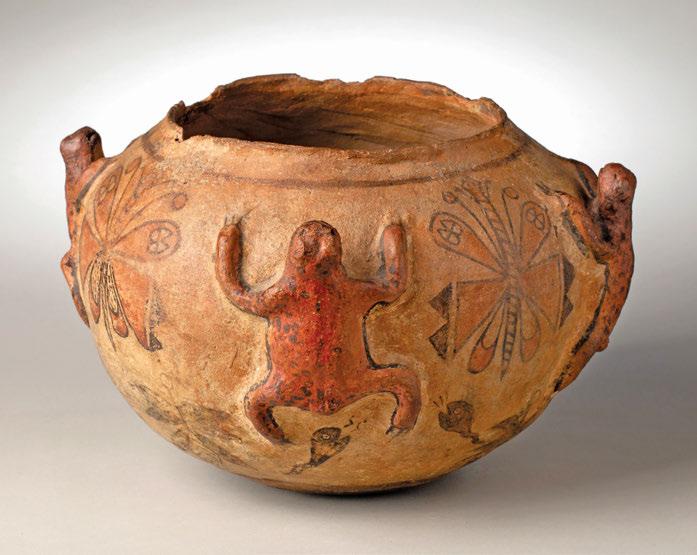The Brandywine Museum Of Art













































Q&A: Linda Selvin
Willis Russell Henry: Obituary & In Memoriam
Wiederseim Auction Spotlights Single-Owner Collection
Morphy Fires Off A $7 Million Firearms & Militaria Auction
September Brimfield Closes Out A Strong Year
From The Continent To Montgomery County, Penn. — A Single-Owner Collection Succeeds At Doyle
Hambletonian Portrait & French Chateau Furniture Headline Flying Pig Auction
Clarke Auction Gallery Bids Adieu To Summer With ‘Blockbuster’ Sale












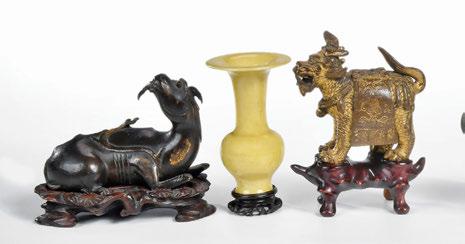



















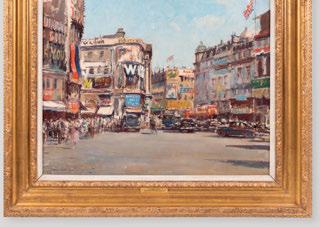





The Appraisers Association of America is a leading association of personal property appraisers who focus on fine and decorative arts. The group’s latest guidebook, Appraising: The Definitive Guide to Valuing Fine Art, Decorative Arts & Collectibles, Volume 2, was published this September, so we caught up with executive director Linda Selvin to discuss both the book and the organization’s mission.
For our readers who may not be familiar with the Appraisers Association of America, could you tell us a little about the organization and what you do?
We are the oldest, premier professional association for appraisers in fine arts, decorative arts and collectibles, referred to as personal property. Established in 1949, our mission is to develop and promote standards in the profession of appraising and to impart those to our members to ensure public trust. Since there’s no licensing in the field of fine and decorative arts appraisers, credentialing from the Appraisers Association is key to safeguarding the public.
In 1983, we established the Appraisal Institute of America (AIA), our educational foundation. Programs that the AIA provide include our annual conferences — the National Conference and Art Law Day and webinars and in-person programming throughout the year.
In 2016 we launched our Comprehensive Appraisal Studies Program (CASP). The program trains individuals who are interested in becoming appraisers who have little or no market experience or are very early in their career or who are career changers. Our students are just remarkable! They come to us with connoisseurship, and we provide them with theory and methodology.
How is Appraising: The Definitive Guide to Valuing Fine Art, Decorative Arts & Collectibles, Volume 2, organized?
We have three sections in the book, the first being “Theory and Methodology,” the second is “The Business of Appraising” and the third is “Connoisseurship.” There are 50 articles in total in the book. Eight articles have been updated from Volume One and 42 new articles include topics such as Latin American art, media art and ultra contemporary art. Other topical articles feature wine and spirits and collector cars. We really wanted to address some of these newer areas of collecting that our appraisers are seeing. Of course, we do have more traditional areas such as English and continental furniture and European Impressionist art. It really runs the gamut of collecting.
Could you give an example of an article that is found in each section? What are
Under the section of “Theory and Methodology,” there’s an article on the Appraisal Review. Many of the topics in this section cover issues that an appraiser would be confronted with when appraising. Another addresses appraisals where a loss of value must be determined. Others discuss valuation approaches and the writing of an appraisal.
In the section on “The Business of Appraising,” there are articles on legal issues affecting personal property appraisers and the need for due diligence by the appraiser. The Appraisal Foundation, which is a congressionally authorized organization, issues a set of standards called the Uniform Standards of Professional Appraisal Practice, or USPAP. These are the industry standards for appraisers of personal property, real estate and business. USPAP provides the best practices for appraisers — the standards. Our appraisers are all required to follow them. In Business of Appraising, there’s an article about meeting the qualification and standards for USPAP. What if you can’t find comparables? What is your responsibility then? Within that article, there’s a section regarding non-discrimination

and ethical responsibility of an appraiser. Another article in this section covers working with other appraisers when their expertise is needed.
In the “Connoisseurship” section, we have additional essays on media art, public art, street art, ultra-contemporary art, art of the American West, Asian export art, Chinese art, animation art, post-war contemporary design and contemporary ceramics and glass and many more.
Who are the book’s contributors?
Many of them are certified members of the Appraisers Association whose areas of expertise connect to their topics; there is an article by renowned art and cultural economist Claire McAndrew; several wellknown conservators; art attorneys from contractual, restitution and tax areas; scholars involved in catalog raisonné work; and a scientist who contributed an article about preservation and materials and their standards. They’re really all leading professionals in their respective fields.
Who is the target audience for this text?

We find that not only appraisers but also collectors, gallerists and insurance professionals are interested in the book. The book provides insight into the history of the works being discussed, then contextualizes it in today’s market and discusses important aspects of the discipline that need to be understood when appraising it. Our broad readership is interested in context for appreciation and its value. As we know, art and collectibles have found many audiences, not least of which are those that collect for investment purposes.
How will the book change the current conversation around art appraising?
I think it will be informative. The book educates the appraiser and the public on aspects that are not available in other publications. Knowledge is power, and as appraisers, collectors or those with an interest will become better informed at what they are looking at and to make decisions.
—Carly Timpson Editor’s note: Appraising: The Definitive Guide to Valuing Fine Art, Decorative Arts & Collectibles, Volume 2 is available for purchase at www.appraisersassociation.com.
Periodicals Postage Paid at Newtown, Connecticut 06470
R. Scudder Smith, Founder (1963) Helen W. Smith
Sherri Smith Baggett Co-Publishers
Madelia Hickman Ring, Editor W. A. Demers, Senior Editor Laura Beach, Editor At Large Kiersten Busch, Assistant Editor Carly Timpson Assistant Editor Rick Russack, Contributing Editor Cindie Gannon, Advertising Manager 203-426-8036 (antiques advertising only) or 203-426-3141 (subscription and other information) or Fax. 203-426-1394 email (advertising) - ads@thebee.com email (subscriptions) - subscriptions@thebee.com email (editorial) - antiques@thebee.com
ADVERTISING RATES
Display: $19 per column inch Auction: $25.20 per column inch
(Early) Auction: $22.50 per column inch for ads received prior to 10 am Thursday, for the next issue. Payment must accompany ad unless credit has been established
DEADLINES:
All display advertising and editorial material must be received by Friday at 10 am; Auctions by Monday at 10 am (except Early Auctions - see above) for the issue dated the following Friday. PAGE LOCATION MAY BE REQUESTED AND WILL BE FOLLOWED IF POSSIBLE
ADVERTISING POLICY
Antiques and The Arts Weekly reserves the right to refuse any advertisement submitted for publication. Further, it cannot guarantee the quality of services advertised in its pages, nor the unquestionable authenticity of objects advertised and it cannot accept any responsibility for misunderstandings that may arise from the sale or purchase of services or objects advertised in its pages. Advertising position is not guaranteed - will be honored, if possible.
POSTMASTER: Send address changes to THE BEE PUBLISHING CO, 5 Church Hill Road, Newtown, CT 06470-5503
Other Rates Available, Please Call 203-426-8036 or subscribe online at www.antiquesandthearts.com
EFFECTIVE March 1, 2023









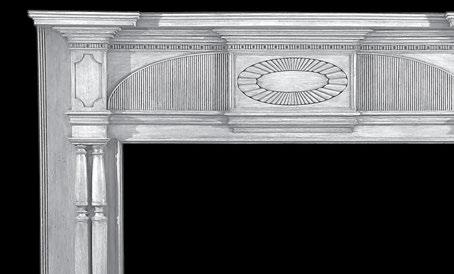






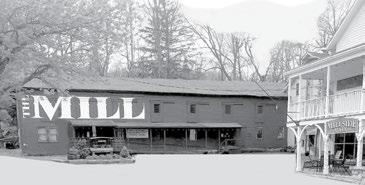




Complete circa 1875 Minton tete-a-tete, shape no. 1349, consisting of a teapot, a sugar, a thistle-form creamer, a pair of yellow cups and green saucers and a tray (est. $12/15,000).
The expected top lot of the auction is a rare and monumental Minton majolica Victorian wine cooler designed by Pierre Emile Jeannest (1813-1857), shape no. 631 ($30/40,000).


Minton majolica monkey garden seat modeled as a seated monkey with a nut below a cobalt buttoned cushion with tassels atop a basketweave base, shape no. 589 ($6/9,000).
WOLCOTTVILLE, IND. —
The Leberfeld collection of majolica — a collection so vast and important it was featured in one of the first coffee-table books on the subject (Majolica by Nicolas Dawes) — will come up for bid at an auction planned for Saturday, October 12, by the Strawser Auction Group, online and live in the Wolcottville gallery.
The October 12 event is one of three days of auctions planned by Strawser, with the Leberfeld collection being the headliner that day in front of other consignments. Nearly 250 pieces of majolica — the highly glazed, lead-based pottery first introduced by the Minton Pottery Company in England in 1859 — from the Leberfeld collection will come up for bid.
Jerry Leberfeld and his wife Aviva amassed one of the most important majolica collections in the world — more than 400 pieces — which they displayed in their New York apartment. Many of the pieces were featured in Majolica Mania and in the Majolica Mania Exhibit in New York City and Baltimore. Jerry Leberfeld also served as president of the Majolica International Society.
The expected top lot in the October 12 auction is a rare and monumental Minton majolica
Victorian wine cooler designed by Pierre Emile Jeannest (18131857). The cylindrical form was decorated with fox and ram heads around the top with four hunt figures plus hounds bringing down a fox and deer with two vintagers on the cover with a wine barrel. The wine cooler, 25 inches tall, is expected to realize $30/40,000.
A complete circa 1875 Minton tête-à-tête has an estimate of $12/15,000. It consists of a yellow lychee teapot, a gourdshaped sugar, a thistle formed creamer, a pair of yellow cups and green saucers with a floral center and a quatrefoil-shaped tray with a green border and yellow trellis sides. The tray measures 12½ inches in diameter.
An iconic Minton majolica garden seat, modeled as a seated monkey with a nut below a cobalt buttoned cushion with tassels atop a basketweave base and measuring 18 inches tall, should fetch $6/9,000.
A circa 1875 Minton majolica banana leaf garden seat designed by Hugues Protat, of waisted cylindrical form with large banana leaves and bamboo feet and seat, is expected to rise to $3/4,000.
A Minton majolica iconic lobster tureen with a shell handled base decorated with seaweed
Windsor Historical Society’s Giant Tag Sale Fundraiser Returns Oct. 10-13
WINDSOR, CONN. — Windsor Historical Society’s popular Bounties of Bargains tag sale fundraiser is back this fall! The Society is seeking donations and volunteers to support this giant tag sale, which takes place on the grounds of the Historical Society museum from Thursday, October 10 through Sunday, October 13. This huge community event has something for everyone, and you can help out! Volunteers are needed every
day from September 16 through October 13. Volunteers get special perks, including first dibs on sale items and unlimited leftovers after the tag sale. To volunteer, register online at: https://bit.ly/tagsalevolunteers or email, windsorhistorical.tagsale@gmail.com. The Windsor Historical Society is at 96 Palisado Avenue. For information, www.windsorhistoricalsociety.org, info@ windsorhistoricalsociety.org, or 860-688-3813.
and shells and a large lobster on the cover atop a bed of shells and seaweed, measures 13½ inches tall, ($3/4,000).
A scarce Minton majolica Renaissance wall-mounted candle holder with bearded man holding a torch, 19 inches tall by 16 inches wide, should finish at $2/3,000.
A Minton majolica cobalt pair of trumpet vases, one with morning glory flowers and leaves, the other with foxglove flowers and leaves, 12½ inches tall, is expected to ring up $2/2,500.
A hard-to-find Minton majolica cobalt Ming Tree large jardiniere, measuring 12½ inches tall and 21 inches wide, is estimated $1,2/1,500.
A rare Wedgwood majolica umbrella stand in the form of a tree trunk with two woodpeckers, 20½ inches tall, carries a presale estimate of $2/3,000.
An equally scarce Wedgwood majolica cobalt elephant punch bowl, with the bowl being supported by four elephants as feet and four grotesque mask handles, 6½ by 12 inches, is expected to achieve $2/3,000.
A hard-to-find Wedgwood majolica game dish with a running rabbit on one side and a

pair of hounds on the other, having two guns forming the handle and with game birds and a rabbit on the cover, 10 inches long by 7 inches tall, should earn $2/2,500.
A Wedgwood majolica mermaid vase clock designed by Hugues Protat, circa 1871 and standing at 14½ inches tall, is expected to change hands for $1,5/2,000.
A Wedgwood majolica cheese keeper with a cow finial and scene of a man and woman with cows in a meadow on cobalt ground, 11 inches tall and 11 inches wide, has an estimate of $1,2/1,500.
An example from Copeland is the rare 1876 majolica memorial
vase, 10 inches tall, retailed by New York City’s J.M. Shaw & Co., in the form of three back-toback eagles guarding the American flag. The vase made as a souvenir for the 1876 Philadelphia Exposition ($6/9,000).
A preview will be conducted in the Strawser Auction Group gallery at 200 North Main Street on Friday, October 11, from 4 to 6 pm Eastern time. The buyer’s premium for live, in-gallery bidders will be 10 percent (not the usual 15 percent); for online bidders it will be 19 percent (not 24 percent).
For more information, 260-8542859, (cell) 260-336-2204 or www.strawserauctions.com.
any ROLEX PATEK, VACHERON, etc.
• ALL SPORTS CARDS & MEMORALBIILIA
•ALL ANTIQUES, incl. SCULPTURES, FRENCH FURNITURE, BRONZES, ETC.
•ANY STAMP

Regular Admission: $5 - 8:30am to 9:30am Free Admission - 9:30am to Noon Complimentary Coffee and a Variety of Goodies. Over 40 dealers. No sale tax. Early admission $30 pp 7:00am to 8:30am 603-506-9848
www.granitestateantiqueshows.com
and FRANKLIN MINT ITEMS
•ANYTHING BY TIFFANY
•ALL STERLING SILVER & JUDAICA
•ANY BETTER AUTOGRAPHS, LETTERS DOCUMENTS
•THE RARER AND MORE UNIQUE, THE BETTER! BI-WEEKLY SUNDAYS 8:30 am to Noon Oct. 6, Oct. 20, Nov. 3


•ALL ENTERTAINMENT MEMORABILIA



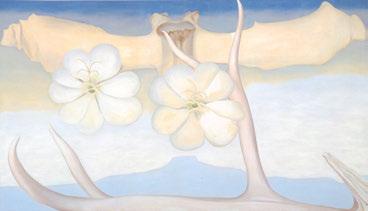
“Spring” by Georgia O’Keeffe (American, 1887-1986), 1948, oil on canvas, Georgia O’Keeffe Museum, Gift of The Burnett Foundation, 1997.6.28. ©2024 Georgia O’Keeffe Museum / Artist Rights Society (ARS), New York City. Courtesy Museum of Fine Arts, Boston.
“Leaf Motif, No. 2” by Georgia O’Keeffe (American, 18871986), 1924, oil on canvas, Collection of the McNay Art Museum, Mary and Sylvan Lang Collection, 1975.45. ©2024 Georgia O’Keeffe Museum / Artist Rights Society (ARS), New York City. Courtesy Museum of Fine Arts, Boston.

“Reclining Figure Bone” by Henry Moore (English, 18981986), 1975, Travertine marble, The Henry Moore Foundation: gift of the artist, 1977 LH643. Photo: Michel Muller. Reproduced by permission of The Henry Moore Foundation. Courtesy Museum of Fine Arts, Boston.

“Red Tree, Yellow Sky” by Georgia O’Keeffe (American, 1887-1986), 1952, oil on canvas, Gift of William H. and Saundra B. Lane and Museum purchase. ©2024 Georgia O’Keeffe Museum / Artist Rights Society (ARS), New York City. Photograph ©Museum of Fine Arts, Boston.

“Thin Reclining Figure” by Henry Moore (English, 18981986), 1979-80, white marble, The Henry Moore Foundation: acquired 1986 LH 734. Photo: Jonty Wilde. Reproduced by permission of The Henry Moore Foundation. Courtesy Museum of Fine Arts, Boston.
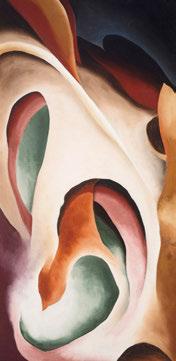

“Helmet” by Henry Moore (English, 1898-1986), 193940, bronze, The Henry Moore Foundation: gift of Irina Moore, 1977 LH 212. Photo: Nigel Moore. Reproduced by permission of The Henry Moore Foundation. Courtesy Museum of Fine Arts, Boston.
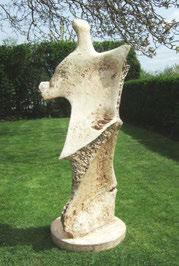
“Working Model for Standing Figure: Knife Edge” by Henry Moore (English, 1898-1986), fiberglass, The Henry Moore Foundation: gift of the artist, 1977 LH481. Photo: David Mitchinson. Reproduced by permission of The Henry Moore Foundation. Courtesy Museum of Fine Arts, Boston.
BOSTON — American painter Georgia O’Keeffe (1887–1986) and British sculptor Henry Moore (1898–1986) are among the most distinctive artists of the Twentieth Century. They have long been admired for their extraordinary distillations of natural forms into abstraction — O’Keeffe’s iconic paintings of flowers and Moore’s monumental public sculpture. The major exhibition “Georgia O’Keeffe and Henry Moore” is the first to bring these two artists together, using compelling visual juxtapositions to explore their common ways of seeing. Each artist experimented with unusual perspectives, shifts in scale and layered compositions to produce works that were informed by their surroundings — O’Keeffe in New Mexico and Moore in Hertfordshire, England. “Georgia O’Keeffe and Henry Moore” is on view at the Museum of Fine Arts (MFA) through January 20 in the Ann and Graham Gund Gallery.
Featuring more than 150 works — including approximately 60 works by O’Keeffe and 90 by Moore — the exhibition includes paintings, sculptures and works on paper, as well as faithful recreations of each of the artists’ studios containing their tools and found objects. Organized by the San Diego Museum of Art, “Georgia O’Keeffe and Henry Moore” is an unprecedented collaboration with the Georgia O’Keeffe Museum and the Henry Moore Foundation.
“Looking at O’Keeffe and Moore together, we can see how both artists were inspired by and also made use of natural forms. O’Keeffe hoped that her

“Pelvis IV” by Georgia O’Keeffe (American, 1887-1986), 1944, oil on Masonite, Georgia O’Keeffe Museum, Gift of The Burnett Foundation, 1997.6.1. ©Private collection. Courtesy Museum of Fine Arts, Boston.
paintings would make people pay attention to things they usually overlooked — the soft gradations of a flower petal, the patterns within a landscape, or the shapes between two objects. As O’Keeffe said herself, ‘to see takes time.’ The chance to see her work in person is not to be missed,” said Erica Hirshler, Croll senior curator of American paintings.
At the core of the exhibition are recreations of the artists’ studios, built with original contents from O’Keeffe’s Ghost Ranch studio in the hills of Abiquiú, N.M., and Moore’s Bourne Maquette Studio in Perry Green, a small hamlet surrounded by sheep fields. Though both O’Keeffe and Moore remained within reach of city life, the two artists worked in rural settings, both amassing large personal collections of animal bones, stones, seashells and other natural materials that served as key sources of inspiration. These found objects can be seen in these spaces alongside tools, unfinished works and plaster maquettes. The studio installations illuminate the heart of O’Keeffe and Moore’s artistic practices — something rarely made visible in museum spaces — and create richer portraits of the artists by encouraging visitors to imagine how they worked and lived.
The Museum of Fine Arts, Boston, is at 465 Huntington Avenue. For information, 617-267-9300 or www.mfa.org.

1978,
1986 LH
COPAKE, N.Y. — For more than 30 years Copake Auction has been the meeting place for antique and classic bicycle collectors and enthusiasts from all over the world. For nearly all these annual events the country auction company has not only conducted highly anticipated cataloged auctions but also its pre-auction Friday swap meet and 10-mile ride. Copake Auction’s 32nd annual bicycles auction will be conducted Saturday October 12, at 9 am.
Over the decades the father and son team of Michael and Seth Fallon have sold such collections as the Pedaling History Museum collection, the David Metz collection, Roger Johnson collection, Pope Mfg. Co. Reference Library collection, the Pennsylvania Dutch Co., Museum (Mt. Holly Springs, Penn.), Bob Trimble, Yesteryear Museum, J.R. Planck Museum, Ben Bowden Archives, Ex Schwinn Museum items, Ed Berry collection (Oregon) and the Lane Motor Museum (Nashville, Tenn.), just to name a few. The diversity of consignments ranges from a $10 rare head badge to a $166,000 motorcycle and everything in between.
This year’s catalog features 522 lots consigned from all over the continental United States, including the Wayne and Kim Batten collection. “This is the most high-wheel bikes we have ever offered in one session,” according to Mike Fallon, referring to the consignment that will feature 45 high wheels and 50 safety bicycles. Highlights from the collection include a circa 1880s Kangaroo high
wheel bicycle made by Hillman, Herbert & Cooper of Coventry; a Pony Star 44-inch high wheel bicycle. Mfg. H.B. Smith Co., Smithville N.J.; a barn fresh 44-inch Crypto geared high wheel; a 1907 Golden Sunbeam tricycle; a Nineteenth Century blacksmith-made boneshaker and much more.
Other various consignments include a New Rapid high wheel bicycle, circa 1887, 54 inches retaining its original nam badge “Sole U.S. Agent…St. Clary & Co., Baltimore Md….Makers S. Georges Engineering Company Birmingham, England”; leather tool pouch with tools; bells. Other brands include Victor, Columbia, Eagle, Bayliss Thomas, New Rapids, Gormully & Jeffery and more.
The auction will feature more than 100 hard tire and pneumatic safety bicycles. Brand names include Lozier, Columbia, Cleveland, Union, Eagle, Clipper, Victor and more. According to Seth Fallon, many of these are in “Barn Find” condition, which collectors love. Also included this year will be balloon tire era bicycles, road racing bicycles, tricycles, parts and accessories and more. As usual, the sale will feature parts and accessories, decorative items and collectibles, art and ephemera and more to include catalogs, pinbacks and medals, posters, advertising tear sheets, bicycle lamps, cyclometers, badges, horns, bugles, tools, saddles, tanks, tobacco cards, books, watches, photography, rims, advertising sign and more.
Previews will be Thursday and Friday October 10-11, from 10
Nineteenth Century blacksmith-made iron, wood and brass boneshaker bicycle, 35-inch front wheel, 31-inch rear wheel, acorn finial in front. ($2/3,000).

New Rapid high wheel bicycle circa 1887, 54 inches, retains original name badge “Sole U.S. Agent…St. Clary & Co., Baltimore Md…. Makers S. Georges Engineering Company Birmingham England,” leather tool pouch with tools, bells. Restoration by Larry Davala ($4/6,000).
Flying Merkel pneumatic safety bicycle, 24-inch frame, older restoration ($2/3,000).
am to 4 pm. Also, on Friday, October 11, will be the swap meet in the back sheep field from dawn ‘til dusk with free
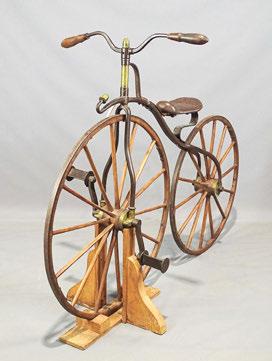

public admission and a $25 vendor fee. The auction will be live, in-person and live online at LiveAuctioneers and Invaluable.
Copake Auction is at 266 Route 7A, For information, www. copakeauction.com or 518-6411935.
NEW YORK CITY — The American Kennel Club (AKC) Museum of the Dog is excited to announce its newest exhibit, “Presidential Dogs: Canine Companions in the White House,” which is on view through January 5.
The exhibition explores the fact that dogs, as well as other pets, have played a significant role in the lives of the President of the United States since the country’s founding. Given the approaching Presidential election, the AKC Museum of the Dog reflects on and shares with visitors the history of dogs in the White House, including the various breeds who have had access to the Oval Office. In addition to the breeds represented, the exhibition features

archival video footage to highlight some of the most notable presidential dogs, such as excerpts from FDR’s “Fala” speech and Nixon’s “Checkers” address, which is playing in the museum’s AKC.tv studio.
“Our exhibition, ‘Presidential Dogs: Canine Companions at the White House,’ offers a retrospective look at the four-legged friends who have faithfully served alongside America’s leaders,” says Christopher E. Bromson, CEO and executive director of the AKC Museum of the Dog. “No politics, just paws.”
The American Kennel Club Museum of the Dog is at 101 Park Avenue. For information, 212696-8360 or www.museumofthedog.org.

important and rare image




DANVERS, MASS. — Kaminski Auctions conducted a momentous on-site auction at the Carmelite Monastery in Danvers on Saturday, August 17. This unique event, marking the permanent closure of the monastery’s chapel, was held to benefit the remaining Carmelite nuns. Established in 1958 under the guidance of His Eminence Richard Cardinal Cushing, DD, LL.D., the monastery has been a vital part of the community and spiritual life in the region.
The auction presented an extraordinary selection of items from the chapel, including large multi-sectional stained-glass windows, an elegant marble altar and a range of sacred artifacts such as chalices, candlesticks and a jewelencrusted monstrance. The event drew a diverse audience, including clergy and members of various religious orders, all eager to acquire pieces of this unique collection. Buyers managed the removal and transportation of their purchases, a detail that did not diminish their enthusiasm.
Among the notable items sold was a French gilt brass monstrance adorned with diamonds, pearls, rubies, emeralds and sapphires. The largest diamond, approximately two carats, was sold for $26,400, attracting multiple bids from online platforms.
Two Gorham gilt sterling chalices from 1938, each encrusted with three diamonds, fetched















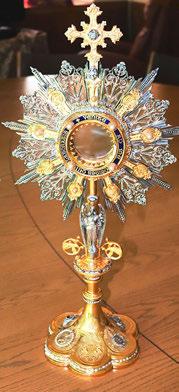
Leading the sale at $26,400 was this jewel encrusted French gilt brass monstrance.
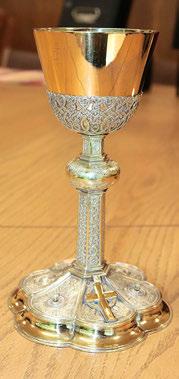
This was one of two gilt sterling silver chalices in the sale by Gorham, dated 1938, which each sold for $5,400.

Three graduated bronze chapel bells, shown here in the bell cote, brought $10,200.





$5,400 each.
The auction also featured a collection of large stained-glass windows, which were acquired in their entirety by the owner of a Peterborough, N.H., property previously occupied by Carmelite brothers. This col-

845-876-8168 oPeN DAiLY
5229 Albany Post Rd. Staatsburg, NY 12580
Between Rhinebeck & Hyde Park 10,000 sq. ft. Antique Mall Auctioneers & Appraisers Limited Dealer Space Available Rhinebeckantiqueemporium.com
lection, including a significant circular window signed by Rambusch, sold for a total exceeding $60,000. The new owner was not certain of their plans for the windows but has assured Kaminski the collection will stay together.
Additionally, a set of three bronze bells, including a 530pound bell, a 265-pound bell and a 165-pound bell, along with remote electronic equipment, sold for $10,200.
An elegant green marble altar with carved and gilded
inscriptions achieved a sale price of $3,360, while a painted carved wood statue of Mary Magdalene also sold for the same amount.
Even the monastery’s outdoor equipment brought great prices. A Ferris ISX 3300 commercial riding mower sold for $15,000 while their Club Car golf cart sold for $3,120.
Other items, including oak and brass Brutalist-style lecterns, side tables, and various lighting fixtures, were eagerly acquired by collectors, often

This large leaded glass window, signed “L.R. Rambusch” and dated “1958/2007” was one of several in the sale, all of which sold for a combined total exceeding $60,000.
surpassing their estimated values.
The auction not only celebrated the rich heritage of the Carmelite Monastery but also offered collectors a rare opportunity to acquire significant pieces of religious and historical importance. This event served as a tribute to the enduring value and beauty of these sacred artifacts, ensuring their legacy for future generations.
Prices quoted include the buyer’s premium as reported by the auction house. For more information, 978-927-2223 or www.kaminskiauctions.com.
w/Ad Appraisals: 12-2pm MASKS SUGGESTED



SALEM, ORE. — The Hallie Ford Museum of Art (HFMA) at Willamette University presents “Becoming Peter Voulkos: Works from the 1950s,” an exhibition located in the Maribeth Collins Lobby which is on view through December 21. The exhibition showcases 12 works by the legendary ceramicist Peter Voulkos, focusing on his early career in the 1950s when he became nationally recognized as a master of wheel-thrown functional stoneware. The exhibition culminates with a single piece exemplifying Voulkos’ revolutionary shift which pushed ceramics into the broader conversation taking place in contemporary art during the mid-Twentieth Century.
This exhibition holds particular significance as it marks the first time an HFMA exhibition has been curated entirely from the former collection of the Museum of Contemporary Craft (MoCC). Originating in 1937 as the Oregon Ceramic Studio, MoCC operated in Portland until its closure in 2016, when

“Striped Vase” by Peter Voulkos, 1953, glazed stoneware, Museum of Contemporary Craft collection, Hallie Ford Museum of Art, Willamette University, Salem, Ore., gift of Ruth Halvorsen, photo by Dan Kvitka.
it transferred its collection to the Pacific Northwest College of Art (PNCA). Following the 2021 merger between Willamette University and PNCA, the collection became part of
HFMA’s permanent collection. The MoCC collection comprises nearly 1,300 modern and contemporary craft objects, including works in clay, fiber, glass, metal and wood by artists and artisans of regional, national and international renown.
Jonathan Bucci, the exhibition curator, remarks, “Voulkos seemed like the perfect artist to begin exploring the MoCC collection. He had an early and influential relationship with the Oregon Ceramic Studio — a precursor to the MoCC — in the1950s. Voulkos played a pivotal role in breaking down the barriers between traditional craft and contemporary art and the Hallie Ford Museum of Art is thrilled to share these rarelyseen early works with the public. We look forward to showcasing more from the MoCC collection in future exhibitions.”
The Hallie Ford Museum of Art at Willamette University is at 700 State Street. For information, 503-370-6855 or www.willamette.edu/arts/ hfma.
NEW YORK CITY — This fall, the Museum of the City of New York (MCNY) presents “Art Deco City: New York Postcards from the Leonard A. Lauder Collection,” an exhibition that features a collection of historical postcards that tell the story of the city’s ascendance as a global emblem of culture and modernity during the interwar years.
On view through February 17, “Art Deco City” highlights the role of the postcard medium, through the Art Deco aesthetic and the development of modern graphics and cutting-edge technology, in broadcasting New York’s cosmopolitan allure to global audiences and positioning the city as a capital of the world. The exhibition is accompanied by objects that contextualize the postcards on view, encompassing decorative arts, fashion, photography, drawings, film and architectural models from the MCNY collection.
Featuring over 250 postcards from the 1920s, 30s and 40s, “Art Deco City” showcases the bold new look of Art Deco, a style that heralded New York’s arrival as a modern metropolis and a hub of architecture, design, fashion and culture. During these decades, postcards fulfilled the role social media plays today; they captured the glamour of city nights through images of neon-lit streets, restaurants and entertainment venues and showcased the novelty of modern urban life through depictions of setback skyscrapers and new modes of transportation. The exhibition explores how this pervasive form of communication encapsulated the city’s elegance amidst the challenges of the Great Depression and the political turmoil of the era.
Through innovations in printing technology, Art Deco-era postcards transmitted vibrant images and messages of this trailblazing “skyscraper city” around the globe, making Art Deco landmarks like the Chrysler Building, the Empire State Building, Rockefeller Center and Radio City Music Hall icons of New York architecture. Postcard artists depicted these structures with dynamic forms and brilliant colors characteristic of the Art Deco style and were instrumental in promoting the “city of tomorrow”
at the 1939-40 World’s Fair.
“Art Deco City” is organized in collaboration with the Museum of Fine Arts, Boston, and is drawn from the Leonard A. Lauder Postcard Archive of over 100,000 postcards. The exhibition’s alluring, candy-colored postcards circulated during Mr. Lauder’s childhood when he began using his allowance to purchase them in multiples at the Woolworth’s five-and-dime in the Empire State Building.
“The exciting city of my childhood is brought to life through these colorful and elegant postcards, which are among the first that inspired my passion for the medium and set me on the path of being a collector. I’m thrilled that they are being shared with the public by MCNY. I have a longtime, special bond with the Museum, and admire how its lively programming continually captures the dynamic history and energy of the city,” said Leonard A. Lauder.
Alongside the works from Leonard A. Lauder Postcard Archive, objects from the Museum of the City of New York contextualize the Art Deco style and underscore its role in shaping New York City’s visual identity as a modern metropolis.
“Inspired by Leonard Lauder’s vision of pairing Art Deco postcards with historic objects and works of art, guest curators Anna Jozefacka and Lynda Klich together with MCNY curator Lilly Tuttle have developed a dynamic exhibition that will highlight New York City’s dazzling ascendance during the interwar years,” said Stephanie Hill Wilchfort, Ronay Menschel President and Director of the Museum of the City of New York.
“At the turn of the Twentieth Century, postcards were an essential communication tool, and the medium found new life in the 20s and 30s as a way to broadcast New York City’s power, glamour and modern ethos to the world.
Leonard A. Lauder’s remarkable collection of New York postcards shows how artists and publishers continually updated their printing methods and materials, always keeping up with the latest visual styles in their designs,” said co-curator Lynda Klich.

“Greetings from New York,” 1940s, published in New York City by Manhattan Post Card Publishing Co., Inc., Leonard A. Lauder Postcard Archive. Promised gift to the Museum of Fine Arts, Boston.
“Art Deco was a look that spurred New York’s identity as the capital of modernity. This exhibition not only celebrates a style of design found in the city’s architecture, but also spotlights Art Deco as a cultural phenomenon that defined an era and continues to influence our perception of the city today,” said co-curator Anna Jozefacka.
“What’s particularly fascinating about this exhibition is how it highlights a significant paradox of the era: The world was simulta-

neously grappling with the downturn of the Great Depression and the looming crisis in Europe, while celebrating a moment of razzle-dazzle, romance and style being experienced and seen in
New York City,” said Lilly Tuttle, co-curator.
The Museum of the City of New York is at 1220 Fifth Avenue at 103rd Street. For information, www.mcny.org or 212-534-1672.






One of two lots that achieved $28,800, the highest price of the sale, this pair of George II walnut side chairs with needlework upholstery were made circa 1740 and had provenance to Kentshire Galleries in New York City ($12/18,000).

Landing within their $4/6,000 estimate was a pair of Chinese rose mandarin porcelain garden stools, which blossomed to $5,760. The Nineteenth Century hexagonal stools measured 19¼ inches high each.

This George II giltwood over-mantel mirror with a Nineteenth Century Dutch painting was one of the two top-selling lots of the sale. The 58-inchtall by 64-inch-wide Georgian mirror blew past its $10/15,000 estimate to achieve $28,800.
NEW YORK CITY — Doyle
Auctions had a homey start to their fall season on September 11 with A Prominent Pennsylvania Collection, a 222-lot sale featuring the property of a Montgomery County, Penn., lady. Her 10,000 square foot home was decorated by wellknown Philadelphia-based interior designers Bennett and Judie Weinstock. Popular offerings came from categories including fine art, Asian works of art and furniture and deco-
rative arts, to name a few.
“The sale was okay,” reported Sal Trupiano, furniture and decorative art generalist at Doyle, in a phone conversation with Antiques and The Arts Weekly after the sale. “We were happy that the decorative items did fairly well. There is always a good demand for decorative accessories; it proves that they are still a strong part of the market.”
Not delving into too much detail, Trupiano also men-
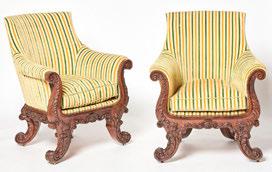
Pulling up a seat for $10,880 was this pair of circa 1823 George IV lyre-shaped bergères made by Gillows out of solid rosewood. In overall good condition, the pair had provenance to Thomas John Wynn and were previously sold by Christie’s London in March of 2000 ($15/25,000).

late Twentieth
and silk highlights and foundation. The 9-foot-9-inch by 13-foot carpet had a Raj quality level of
for $7,040 ($8,000-$12,000).
tioned that at least one expensive item went to a Midwest collector, while another made its way to Charleston, S.C., with “a client who has a good collection.”
Two lots, both pieces of furniture made in the George II period (1727-1760), earned $28,800, the highest price of the sale. The first was a George II giltwood over-mantel mirror which contained an early Nineteenth Century Dutch painting depicting a group of

“A Still Life of Fruit and Flowers, with Rabbits, a Parrot and a Frog in a Landscape,” Seventeenth or Eighteenth Century, oil on canvas, 53½ by 61 inches framed, was attributed to the Continental school and hopped to $10,240 ($6,000-$10,000).
figures on a riverbank in its upper half. The 58-inch-high piece had a mid-Eighteenth Century giltwood frame and three divided mirror plates on its lower half.
The second lot to earn $28,800 was a pair of George II walnut side chairs with needlework upholstery that were manufactured circa 1740 and had provenance to Kentshire Galleries (New York City). The auction catalog noted that the 40-inch-high chairs had “very nice patina on the walnut carving.” Despite some repaired needlework and fading in some areas, the pair skyrocketed over their $12/18,000 estimate.
Other notable chairs sold included a pair of circa 1765 George III carved mahogany library armchairs attributed to John Cobb ($19,200); a pair of circa 1823 George IV solid rosewood lyre-shaped bergères made by Gillows for the second baron of Newborough (Glynllifon, Wales) ($10,880); and a circa 1790 pair of George III needlepoint-upholstered mahogany open armchairs also with provenance to Kentshire Galleries ($7,040).
Trupiano explained that many of the English furniture pieces returned to their country of origin with various collectors and dealers. “Usually, pieces are worth the most in the country they were made in;

“View of the
it’s not unusual to see that in the marketplace.”
Two oil on canvas paintings from the Continental school were sold consecutively near the beginning of the auction. “A Still Life of Fruit and Flowers, with Rabbits, a Parrot and a Frog in a Landscape” was dated circa the Seventeenth or Eighteenth Century. The 53½-by-61-inch work earned $10,240. “Still Life of Fruit and Flowers with a Hen and her Chicks in a Landscape” finished right behind its Continental School counterpart, blooming to $9,600. The still life was painted in the Eighteenth Century and measured 62 by 52 inches framed.
In a similar vein, an Italian school painting from the Nineteenth Century, titled “View of the Campo Santi Giovanni e Paolo, Venice,” crossed the block for $8,960. The oil on canvas was signed indistinctly and dated “1824” on the lower righthand corner.
In preparation for the holiday season, Doyle is conducting its Doyle at Home auction on October 2, which will be a general sale of furniture, lighting and decorative accessories, among others.
Prices quoted include buyer’s premium as reported by the auction house. For additional information, 212-427-2730 or www.doyle.com.

its
Despite a $600/800 estimate, the
WILLOUGHBY, OHIO — College football, newly harvested crops and the announcement of Milestone’s Premier Vintage Toy Auction are all sure signs that autumn has arrived. This year, Milestone’s bounteous fall event is slated for October 5 at the company’s suburban-Cleveland gallery, with all forms of remote bidding available, including live online through a choice of Internet platforms. The auction lineup is packed with 715 lots representing the most-sought after categories of antique and collectible toys sourced from across the United States and beyond.
In anticipation of this sale, Milestone’s co-owner Miles King and his team of road warriors have crisscrossed the United States, picking up automotive, nautical and character toys; early motorcycles, pressed-steel trucks, banks, and Japanese tin and batteryop productions, including robots and space toys. In addition, the selection includes early European hand-painted and windup toys — some with rare factory boxes — by Lehmann, Martin, Gunthermann and many other sought-after German, French and British brands.
American pressed steel is a strong category, with several rarities deserving special attention. First, there’s an elusive Buddy “L” pressed-steel Tugboat, all original with vibrant red paint and intact decals. It’s a non-motorized version believed to have been intentionally produced that way at the Buddy “L” factory in East Moline, Ill. At 28 inches long and with provenance from the Fred Castan collection, it comes to auction with a $15/20,000 estimate.
Another cast-iron rarity is an all-original 27-inch-long Gendron Sampson pressed-steel stake truck with orange-andblack paint and decals. It’s the only original example of this truck Milestone’s team of toy experts has ever encountered ($6/8,000). Following closely behind is another all-original pressed-steel toy, a Turner Lincoln in a two-tone brown color scheme. The 26-inch auto will

Rare Buddy “L” pressed-steel red Tugboat. All original with vibrant paint and decals. Non-motorized version believed to have been intentionally produced that way at the company’s East Moline, Ill., factory. Length: 28 inches. Provenance: Fred Castan collection ($15/20,000).
be offered with a $4/5,000 estimate.
The ultimate in pressed-steel luxury is a rare American National Packard roadster pedal car in all-original condition with red paint. It is the only known example that has electric headlights, leading to speculation that it might have been produced to show at the New York Toy Fair, where exhibitors typically exhibit their most tricked-out variations. The battery holder has been replaced, but for completeness, the lot includes the original, in addition to a dry cell battery ($10/15,000).
Even the most advanced robot collections might be lacking a super-rare Yonezawa tin Mechanical Commander robot.
“This particular type of robot just never comes to market,”
Miles King observed. The October 5 auction has an example of a Commander Robot in its bright orange, red and white color scheme. The primitive looking 10½-inch ‘bot, with primitive wheels and gauges lithographed on its chest, also comes with a repro box. ($15/20,000).
A classic ASC (Aoshin Shoten, Japan) tin windup Tremendous Mike Robot will also cross the block. All original and complete, including its antenna, this 10-inch toy looks as though it was never played with. Its windup mechanism and other functions worked fine when tested, and it comes with its original pictorial box ($8/10,000).
For the space-toy completist, there’s a Garton “Space Cruiser” pedal car in red and white

factory paint. All original and complete, its sleek Space Age design sets it apart as something very special. Miles King assesses it as: “possibly the nicest all-original example known.” ($5/7,000).
For those who like their playsets ultra-mint — and who doesn’t — Milestone suggests a complete Marx #5422 Trucking Terminal outfit. This lithographed, fully boxed playset is new/old stock. The crisp, profusely illustrated set-box houses mint/boxed tin friction examples of an Allied Van Lines truck, North American Van Lines hauler and a pickup truck; as well as a neverassembled tin terminal building. On top of that, the set retains its original figures and accessories, which are still in Marx bags ($3/5,000).
One of the craziest yet most ingenious German toy designs is seen in Distler’s tin windup Directional Policeman Car, with its comical bug-eyed driver and a figural policeman affixed to the front of the vehicle. Milestone will auction an example of this toy, with bright colors and profuse lithography overall. Its medley of graphics includes motorcycles, autos, people, dogs, a double-decker bus, gas pump, buildings, street lights and more. When activated, the policeman points his arms in the direction in which

the car is turning. This toy is the only one of its type that Milestone’s team has ever seen ($10/15,000).
Milestone’s gallery is at 38198 Willoughby Parkway, Start
time: 10 am ET. All forms of remote bidding will also be available, including absentee, phone and live via the Internet. For information, 440-527-8060 or www.milestoneauctions.com.






Mid-Hudson Bidders Warm Up To Wiggins’ Winter Storm
NEW WINDSOR, N.Y. — A quintessential New York City winter landscape by Guy Wiggins (American, 1881-1962) was the top lot in Mid-Hudson Auction Galleries’ September 14 sale, titled, “Antiques. Artwork. Taino. Photos.” Painted in oil on canvasboard and signed and titled on the reverse, “Winter Storm, 5th Ave” measured 18 by 14 inches and realized $5,313. It had been consigned by a Hudson Valley seller who has sold through Mid-Hudson Auction Galleries in the past and was purchased by an online bidder from New Hampshire. For information, 914-882-7356 or www.midhudsongalleries.com.

Whaleman’s Knife A Surprising Vintage Good At Eldred’s HANOVER, MASS. — The September 18 Vintage Goods sale at Eldred’s featured a wide variety of material at approachable price points, with a little bit of everything. What a representative for the house called “a nice surprise” was the $1,408 realized by a Nineteenth Century whaleman’s knife with tooth handle that measured 7 inches long and came with a leather sheath marked “Hudson.” Discovered in a Maine estate, it sold online to a private collector, whereabouts undisclosed. For information, 508-385-3116 or www.eldreds.com.

Chinese Temple Vases Court
Americana Auctions’ Bidders
REHOBOTH, MASS. — On September 22, Americana Auctions presented 507 lots in its Splendid Summer Estates Auction, offering to local and further-flung bidders the opportunity to compete for furniture, silver, jewelry, nautical and maritime antiques, posters, militaria, rugs, clocks and Asian works of art, including objects from a Chatham collection and Edgartown, Mass., estate. A pair of large Nineteenth Century Chinese temple vases, in the Famille Rose pattern that each stood 24 inches tall and were both unsigned, had the highest result of the event, bringing $33,280 against a pre-sale estimate of $5/7,000. Auction manager Rich Shute said the buyer was in Paris. For information, 508771-1722 or www.americana-auction.com.


All prices include buyer’s premium.
Chunky Green Chalcedony Necklace Dazzles Benefit Shop Bidders
MOUNT KISCO, N.Y. — One of the highlights of The Benefit Shop Foundation’s September 18 Red Carpet Auction was a Neiman Marcus chunky polished green chalcedony necklace with hammered 22/24K gold clasp that measured 21 inches long and featured 21 opalescent stones of irregular shape. Estimated at $400/800, the necklace realized $2,193 from a buyer in the US who was making their debut purchase at the Mount Kisco house. For information, 914-864-0707 or www.thebenefitshop.org.

Miner’s & Flashlight Lamps Brighten Conley Collection At Forsythes
CINCINNATI, OHIO — On September 22, Forsythes’ Auctions sold the lifetime Americana collection of Pat and Ruthanne Conley, of Fort Thomas, Ky. The 315-lot sale featured furniture, pottery, boxes, folk art, holiday, decoys and early lighting. It was this last category that featured the sale’s top lot: a group of two miner’s lamps — one marked “Guys Droper” — and a wooden flashlight lamp was the priciest of the weekend, bringing $3,150 against a $60-$100 estimate. For information, 513-791-2323, 937-377-3700 or www.forsythesauctions.com.

Carved Wooden Native American Trade Figure Sells Well At DuMouchelles DETROIT, MICH. — An American polychromed carved-wood trade figure of a Native American created in the late Nineteenth/early Twentieth Century sold at auction for $31,000 to a phone bidder in the Southern United States. The auction was conducted by DuMouchelles on September 14. The carved-wood standing Native American figure wore a feather headdress and held a club in his right hand. Mounted to a painted wood display base with casters, the figure’s overall height was 83 inches. Provenance was from a Michigan private collection. For information, 313-293-6203 or www.dumoart.com.

Duffner & Kimberly Lamp Lights Up At Woody Auction
DOUGLASS, KAN. — Woody Auction’s September 21 sale featured 398 lots of art glass, lamps and more decorative antiques. A Duffner & Kimberly leaded glass Wisteria table lamp on a claw foot brass base was the highest earning lot of the day. The lamp, including its electrified four-light base, was 28½ inches high and the mosaic shade was 21½ inches in diameter. Soaring past its $1,5/2,000 estimate, the 29-pound lamp was bid to $33,000. For information, www.woodyauction.com or 316-747-2694.
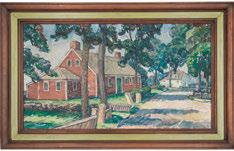
Cheney’s Kittery Point Landscape Heads Bray Auction PORTSMOUTH, N.H. — A painting of the Kittery Point, Maine, Wasson House, painted circa 1930 by Russell Cheney (American, 1881-1945) was the highest selling lot of nearly 160 offered in Bray & Co’s New England Collections auction on September 21. Accompanied by a newspaper clipping about Cheney and a postcard for the Wasson House, the painting is one of many views of Kittery done by the artist. Consigned to sale by the family of a Vermont art collector who acquired it many years ago, it sold to a private collector for $14,760. Auction house owner Derin Bray believes the result is an auction record for one of Cheney’s streetscapes. For information, 603-427-8281 or www.brayco.com.

Addams New Yorker Illustration Finishes First For Auction Gallery Of Palm Beaches WEST PALM BEACH, FLA. — A mixed bag of 197 lots were up for grabs at Auction Gallery of Palm Beaches’ September Discovery Auction, which took place on the 21st of the month. The sale featured the property of a Wellington estate with additional consignments from South Florida and the Palm Beaches, including paintings and prints, silver, porcelains, art glass, Chinese and Japanese antiques, tribal art and vintage and antique furniture, among others. Leading the sale was an original cartoon illustration for The New Yorker by Charles Addams (American, 1912-1988), which far surpassed its $1/2,000 estimate, earning $9,600. The ink and gouache on paper was signed lower left, inscribed lower right and laid to J. Whatman illustration board; it contained a The New Yorker editorial stamp and measured 16½ by 20¼ inches. For information, 561-805-7115 or www.agopb.com.
Auctions will conduct its annual fall auction on Sunday, October 20, selling the firm’s usual eclectic mix of American antiques, including Boston/Seymour pieces of formal furniture, painted furniture and a rare folk-art portrait. Also being sold are English, Continental and Asian works of art, furniture and accessories spanning the Eighteenth through the Twentieth Century.
Commissioned by the family and kicking off the sale are sculptures and works on paper from the estate/studio of Boston artist Ernest Elie Morenon, NA (19042002). Born in Marseille, France, he studied at the Ecole Nationale des Beaux Arts in Paris. Throughout his life, Morenon received numerous first prizes, awards and medals, both in France and in America. In France, he is best known for the massive carved oak panels, the “Porte de l’Alma,” which graced the entrance to the Paris 1937 International Exposition depicting the working people of France. This was a tense time in history on the brink of World War II.
Morenon emigrated to Boston in 1943 and become an instructor at the Cambridge School of Design from 1947 to 1950. He taught at the Boston Museum of Fine Arts School from 1950 until 1966. He was head of the sculpture department at the Boston Museum of Fine Arts from 1955 to 1965. He later taught at Boston University’s School of Applied Arts from 1966 to 1969. Morenon was a member of the National Sculpture Society; the National Academy of Design; the Architectural League of NY; Audubon Artists; and the New England Sculptors Association.

“The Future,” carved from Georgian pink marble, 48 inches tall. This Art Deco sculpture was displayed at the Worcester Art Museum in 1954, and in the 1977 Boston Fine Arts Museum School exhibit “Founders and Faculty.” Morenon was an instructor of sculpture at the Boston Museum of Fine Arts School, and head of the Fine Arts Museum’s department of sculpture from 1955 to 1965.
Morenon was one of the eminent carvers of ecclesiastical commissions in Twentieth Century America. His bronze and marble sculp-
ALBANY, N.Y. — An exhibition exploring historical and contemporary Mohican art and culture is on view at the Albany Institute of History & Art through December 31. “People of the Waters that are Never Still: A Celebration of Mohican Art and Culture” honors the Muh-he-con-ne-ok people, known today as the Stockbridge-Munsee Community Band of Mohican Indians.
“The Albany Institute of History & Art is located on the traditional homelands of the Mohican people,” notes chief curator W. Douglas McCombs, PhD. “They are an integral part of our regional history, even though, through forced relocations, much of the community now resides in Wisconsin.”
Traditionally, the Albany area is called Pempotowwuthut-Muhhecanneuw, meaning “the fireplace of the Mohican nation.” The Muh-he-con-ne-ok have a rich and illustrious history which has been retained through oral tradition and the written word.
The historical and contemporary art in “People of the Waters that are Never Still” evokes not only the five physi-

Boston artist Ernest Morenon (1904-2003) emigrated to Boston in 1943. Here, at age 33, he is pictured working on his massive oak panels “Porte de l’Alma” at the entrance to the 1937 Paris International Exposition of Arts and Technology. He received a gold medal for this work. Most of the buildings were demolished in 1938. Family lore says these panels were burned for fuel by the Nazis.
tures include “The Pieta” in the Cathedral of the National Shrine of the Immaculate Conception in Washington, D.C.; and several stone panels, “Stations of the Cross” in the Cathedral of Mary our Queen, Baltimore (1958). Massachusetts commissions include works in Holyoke, five

Lot #1 in the sale is this large, tempestuous steel and enamel sculpture, “The Conductor.” This and another steel sculpture, “Eterno Conflictto,”: express an aspect of Morenon’s true self, far removed from his ecclesiastical renderings. His fascinating experimentation with acrylics in the 1940s will also be sold.
limestone plaques for the Boston Nazareth Shelter for Homeless Children (1953), and Carney Hospital (1952). Studies for these works are included in the sale. Interestingly, Morenon was said not to be a religious man.
Because the majority of Morenon’s career was spent on public and private commissions, his work has not yet surfaced on the public market. The only example found on the Internet was a 46-inch basrelief, carved oak study of the “Porte de l’Alma,” which sold at Christie’s/Paris in 2011 for $17,000. The works being sold at CRN are among Morenon’s favorite pieces, which have remained in the family until his death in Providence, R.I., on the eve of his 99th birthday. CRN Auctions is at 57 Bay State Road. For information, 617-6619582 or www.crnauctions.com.



cal senses, but also a sense of connection — to place, the Earth, water, animals, relatives, ancestors, stories, traditions, identity and community.
The contemporary artists in this exhibition reflect upon their heritage through self-discovery, repurposing materials, carrying on traditions, preserving moments and memories and telling their own narratives through various compositions.
The exhibition features more than 40 objects, including historical objects and documents, crafts, contemporary works of art from 10 artists and a community beadwork project created by members of the Stockbridge-Munsee Mohican community. Works of art include paintings, sculptures, photography, baskets, beadwork, a visual poem and a musical composition. “People of the Waters that are Never Still” includes objects on loan from the Arvid E. Miller Museum, New York State Museum and Historic Huguenot Street.
The Albany Institute of History & Art is at 125 Washington Avenue. For information, 518-463-4478 or www.albanyinstitute.org.










This three-position selector MP5 SD machine gun by Heckler & Koch was one of two lots — both on the first day of the three-day sale — that earned $123,000, the highest price ($60/80,000)
DENVER, PENN. — Three days. Nearly 1,850 lots. More than $7 million in sales. A sellthrough rate of more than 97 percent. These were just some of the statistics from Morphy Auctions’ Firearms and Militaria auction that took place September 10-12.
Dan Morphy did not beat around the bush in his comments, telling Antiques and The Arts Weekly, “The September Firearms Auction outperformed our expectations. It had the largest group of new players in years. It is exciting to see new enthusiasm in this division.”
Two vastly different lots each achieved $123,000, the highest price of the event. The first to reach the high-water mark was
a three-position selector factoryoriginal Heckler & Koch MP5 SD machine gun, with matching factory silencer and one original “Made in Germany” magazine. It sold on the first day, about two dozen lots from the start of the sale.
Bidders would wait another 575 lots before another lot made $123,000, but one did — a boxed set of three knives, all made by Ron Lake and embellished by Barry Lee Hands. In excellent condition, gilt pearl inlays, gold borders, multicolored diamonds and etched decoration were among Hands’ embellishments of the set. The knives ranged in size from 4¾ inches to 13-7/8 inches and were stored in a walnut display case with red lining;

This rare set of Colt Python Snake Eyes double action revolvers was one of just 500 pairs made in 1989 and had provenance to the Jim Cyr collection. Estimated $15/25,000, the lot, which was in a display case, finished at $30,240.
the set had been in the collection of Frank Brownell.
Historic weapons held their own against modern firepower for the second-highest result as well. A World War II M2 Browning machine gun made by the Savage Arms Company, that was cataloged as “very desirable,” sold within estimate for $73,800, the same price achieved by a cased Colt No. 3 Paterson belt model percussion revolver that had been presented to William Watson. The catalog noted that Watson was a New York City attorney who is documented as representing Samuel Colt in disputes with Patent Arms Manufacturing Co, treasurer and majority shareholder John Ehlers. A presentation plaque

Morphy’s catalog noted this historic cased Colt No. 3 Paterson belt model percussion revolver was “an extremely rare opportunity for the discerning collector,” particularly those that had connections to individuals pivotal to Colt’s history. It was one of two lots to bring $73,800, the second-highest price of the sale ($40/60,000).

This silver plated and engraved Henry Lever action rifle, made by the New Haven Arms Company in 1863, had provenance to the collection of Colonel T. Daghistani and was published in R.L. Wilson’s Winchester Engraving (Pioneer Printing, 1975). It sold just short of its high estimate, at $39,360 ($30/40,000).

the circumstances under which

The second of two lots to bring the sale’s top price of $123,000 was this group of three knives, made by Ron Lake and embellished by Barry Lee Hands ($30/50,000).
on the lid of the case was inscribed “W. Watson / from A.P;” the house speculated the latter might be Andrew Parsons, an influential New Jersey politician who represented Passaic County, home of Colt’s Paterson factory, in the Upper House of the New Jersey Legislature.
History to the personal and advanced collection of Dr Jim Watson of Scottsdale, Ariz., further contributed to the gun’s desirability with bidders, who pushed it beyond its high estimate.
A circa 1875 double rifle made by R.B. Rodda & Co., that once belonged to Cal Pappas shot past its $45,000 high estimate to hit $46,740, while a Civil War era Henry Lever action rifle, made by New Haven Arms that was silver plated and engraved, brought $39,360.
For presentation pieces, it would be hard to beat a 500-year-
old Japanese katana (sword) that was given to Frank Parker by Prince Kan’in Kotohito, in 1936. Parker was a US Army officer who graduated from the US Military Academy, served in the Spanish American War and in Puerto Rico before returning to teach in a number of schools. After his academic retirement in 1936, he served in a number of posts, including that of assistant chief of staff, head of the Philippine Department and commander of the Eighth Corp Area and Third Army. Kotohito had connections to the Japanese imperial family and was the chief of staff for the Imperial Japanese Army until 1940. The blade, which came in its original wooden box, traded hands at $40,800. Prices quoted include the buyer’s premium as reported by the auction house. For additional information, 877-968-8880 or www.morphyauctions.com.

This circa 1875 double rifle by R.B. Rodda & Co., was sold together with Cal Pappas’ tools and copies of his self-published books, The British Bore Rifle (2013) and The Double Rifle Primer (2013) It went out for $46,740 ($35/45,000).

brought $67,650 ($100/150,000).
4,
NEW YORK CITY — The Metropolitan Museum of Art presents the first-ever major museum exhibition to examine the career of the influential Twentieth Century architect Paul Rudolph, a second-generation Modernist who came to prominence during the 1950s and 1960s alongside peers such as Eero Saarinen and I.M. Pei. “Materialized Space: The Architecture of Paul Rudolph,” on view through March 16, showcases the full breadth of Rudolph’s important contributions to architecture — from his early experimental houses in Florida to his civic commissions rendered in concrete, and from his utopian visions for urban megastructures and mixeduse skyscrapers to his extraordinary immersive New York interiors. The exhibition gives visitors the opportunity to experience the evolution and diversity of Rudolph’s legacy and better understand how his work continues to inspire ideas for urban renewal and redevelopment in cities across the world. The presentation features a diverse range of over 80 works in a variety of scales, from small objects that he collected throughout his life to a mix of material generated from his office, including drawings, models, furniture, material samples and photographs.
“Paul Rudolph was a pioneer and an iconic figure among the architectural community, and this long-overdue presentation analyzes the immense impact that his trailblazing work continues to have on contemporary architects and the development of our urban spaces,” said Max Hollein, The Met’s Marina Kellen French director

Paul Rudolph (American, 1918-1997), Perspective section drawing of the Art and Architecture Building, Yale University, New Haven, 1958, pen and ink, graphite and plastic film with halftone pattern, on illustration board. 36-7/8 by 53-5/8 by 2 inches. School of Architecture, Yale University, Manuscripts and Archives, Yale University Library.
and chief executive officer.
“‘Materialized Space’ not only underscores the radical thinking that Rudolph imparted to the Modernist era, but also invites viewers into the complex artistic process of architectural development, illuminating the ways in which the spaces we occupy come to life.”
“Materialized Space” is divided into thematic sections that follow the many stages of Rudolph’s architectural practice, highlighting his work in housing, civic projects, megastructures, interiors and his commissions in Asia. Through a careful selection of projects, the exhibition shows how Rudolph’s work engaged with key moments of cultural, eco-
NORFOLK, VA. — The Chrysler Museum of Art is thrilled to announce that “Peter Bremers: Ice to Water” is on view in the Glass Project Space at the Museum through January 19.
Influenced by his journeys to Iceland and his meditations on the rapidly melting glaciers, Peter Bremers (Dutch, b 1957) debuts new work in “Ice to Water.” Sixteen sculptures inspired by the natural world are displayed alongside photographic images the artist captured during his explorations of these changing landscapes.
To the coastal community of Norfolk, Virginia, which the Chrysler Museum calls home, this group of artworks not only symbolizes the worldwide impact of climate change but also reflects challenges we face locally due to sea level rise.
“When Peter and I were discussing ideas for an exhibition of his work at the Chrysler Museum, he mentioned in passing that he was going back to Iceland and rethinking a series of
sculptures inspired by melting ice,” said Carolyn Needell, Barry curator of glass. “I was thrilled to hear about this new direction because of its relevance to our Hampton Roads community, and I suggested that it be the focus for our show.”
Originally visiting Antarctica and the Arctic in 2001 — journeys which served as the impetus for his “Icebergs & Paraphernalia” series — Bremers took a stance to highlight natural beauty while remaining neutral towards environmental issues. Now, 20 years later, Bremers was moved to revisit his “Icebergs” series at a moment when climate change has accelerated the retreat of glaciers.
“I can no longer ignore what we face daily,” the artist says. Simultaneously, Bremers reflects, “This impermanence is also full of beauty and wonder. From ice to water.”
The Chrysler Museum is at One Memorial Place. For information, www.chrysler.org or 757664-6200.
nomic and political significance during the Twentieth Century, including post-war construction and expansion, urban renewal and housing policies in the 1960s and the
100,000 items, encompassing drawings, models, photographs and printed ephemera. “Materialized Space” features extensive loans from the Library of Congress, including several objects that have never been on view before and in some cases have never been photographed. Additional loans, from the Paul Rudolph Institute for Modern Architecture, include important examples of furniture and other objects from the architect’s estate — in addition to other key institutional and private lenders.
The Metropolitan Museum of Art is at 1000 Fifth Avenue. For information, 212-535-7710 or www.metmuseum.org.
economic boom in Asia in the 1980s.
Just before his death in 1997, Rudolph bequeathed to the Library of Congress his architectural archive of more than




FIRST WEDNESDAY ANTIQUES FLEA MARKET
October 2, 2024
November 6, 2024
December 4, 2024
January 1, 2025 February 5, 2025
March 5, 2025 April 2, 2025
Dover Elks Lodge - 282 Durham Road, Dover, NH
BATH ANTIQUE SALE
October 13, 2024
January 12, 2025 February 9, 2025
March 9, 2025 April 13, 2025
The Bath Middle School - 6 Old Brunswick Road, Bath, ME
THE BOXBOROUGH ANTIQUE SHOWS
October 20, 2024 January 5, 2025 February 2, 2025
March 2, 2025 October 26, 2025
The Boxboro Regency Hotel - 242 Adams Place, Boxborough, MA
THE THANKSGIVING SUNDAY ANTIQUE SHOW
A Holiday Tradition! December 1, 2024 181 Royal Plaza Drive, Marlborough, MA
www.gurleyantiqueshows.com
Joshua Gurley (207) 229-0403 joshua@gurleyauctions.com

November 10, 2024 December 15, 2024

Rachel Gurley (207) 396-4255
rachelgurley@gmail.com

Founded in 1919 in Milwaukee, Wisc., Moe Bridges Company’s independent presence in the market lasted only until 1934, so its light fixtures are relatively rare. This Art Nouveau Moe Bridges Co., table lamp, circa 1920, surpassed its $600/800 estimate and sold for $1,375. It was signed “Moe Bridges & Co” and measured 24 by 17 inches.

Art Nouveau

A table lamp by Bradley & Hubbard Mfg. Co,
was a two-light example with a reverse-painted
scene on one side of the glass shade and a lakeview on the other. Measurements were 23 inches high by 16 inches in diameter.

Leading the sale was this large Arts and Crafts library lamp with adjustable double arms. Its beauty was simple and direct in keeping with design movement: an octagonal, polished stone base, darkened brass body and green shadow shades. It sold for $1,625 against a $300/400 presale estimate, won by an online bidder on LiveAuctioneers.

This Art Nouveau Pairpoint chrome colored table lamp, circa 1920, crossed the block at $1,187. Its reverse painted-glass shade featured a floral design and its base was signed on the bottom. It measured 22 inches high with a 16-inch diameter.

Its shade encircled with a Greek key pattern below an octagonal eight-panel slag glass pattern bordered with red slag glass, a Bradley & Hubbard Manufacturing Co, bronze-finished two-light table lamp, circa 1900, went out at $1,000, more than triple its high estimate.
PHOENIXVILLE, PENN. — A single-owner sale with no reserves is one not to be missed.
Co-owner Ted Wiederseim conducted such an auction on September 6, selling more than 300 lots of mostly early lighting, including great examples of Art Deco, Art Nouveau, Arts and Crafts, chandeliers, wall sconces, table lamps, student/bankers lamps, pendant lights and more. Many were produced by wellknown makers such as Pairpoint, McKee, Tilley type, Edward Miller & Co., Bradley & Hubbard, Handel, Lightolier and others.
The top lot was a large Arts and Crafts library lamp with adjustable double arms. For “workhorse” lighting, it compensated with an octagonal polished stone base, darkened brass body and green shadow shades. That simple beauty was reinforced by its final price of $1,625, against a $300/400 presale estimate. It went to an online bidder on LiveAuctioneers, according to coowner Ted Wiederseim. Each of the shades was signed “Imperial Austria,” and the lamp’s measurements were 28½ by 31½ inches.
The overall sale realized $74,160 with 490 registered bidders, including 30 who were in house. The most online “visits” were made to an Art Nouveau table lamp, according to Wiederseim, and Art Nouveau seemed to be the flavor of the day.
The second-highest selling lot
was an Art Nouveau Moe Bridges Co., table lamp that juiced its $600/800 estimate to a sold price of $1,375. Faux bronze, it featured two sockets and a diaphanous tropical scene on its reversepainted shade. Signed “Moe Bridges & Co,” the circa 1920 lamp measured 24 by 17 inches. According the website Architectural Antiques, brothers Henrik and Ole Moe founded the Moe Bridges Company in 1919 in Milwaukee, Wisc. The company’s heyday in the market lasted until 1934 when it was acquired by Electric Sprayit Company. Because of its relatively short life, Moe Bridges Company light fixtures are relatively rare. Two items crossed the block at $1,187. The first was an Art Nouveau Pairpoint chrome colored table lamp, circa 1920. Its reverse painted-glass shade was festooned with a floral design, and its base was signed on the bottom. It measured 22 inches high with a 16-inch diameter. The second item was a table lamp by Bradley & Hubbard Manufacturing Co. Bronze finished, it was a two-light table example and its reverse-painted glass shade was lively, with a forest scene on one side and a lakeview on the other. Each of these lamps surpassed their $300/400 estimate.
Art Nouveau design continued with a Bradley & Hubbard Manufacturing Co., bronze finished, two-light table lamp, made circa 1900. Its shade was encircled

René Lalique (French, 1860-1945) was a jewelry designer, glassmaker and decorative artist. His frosted art glass jaguar, 5½ inches high by 13½ inches long, stalked a $400/600 estimate, but did better, finding a buyer at $938.

and

A bevy of maidens held shades and light fixtures aloft in this Art Nouveau faux bronze five-light chandelier, which beat its expected $150/200 estimate with a final price of $1,000. The shades were “salmon fish-scale” and the chandelier was signed Nuart.
with a Greek key pattern below an octagonal eight-panel slag glass pattern, bordered by red slag glass. The lamp was marked “297” on its bottom, and measured 26 inches high with an 18-inch shade. It went out at $1,000, more than triple its high estimate.
Fetching the same amount was an Art Nouveau chandelier, besting its expected $150/200. With what were called “salmon fishscale” shades, the faux bronze five-light chandelier had a motif of encircling maidens holding the shades and light fixtures aloft. Signed “Nuart,” the chandelier measured 39½ inches high by 29 inches wide.
A circa 1920s Art Nouveau bronze double arm table lamp

This bronze five-light chandelier fitted with Steuben glass shades, circa 1920s, was offered with a $400/600 estimate and left the gallery at $875.
featured green leaded glass shades that were attributed to Handel and complemented by a leafy base. The lamp measured 20½ inches high while the shades were 9 inches in diameter at the base and 3 inches at the top. Doubling its high estimate, it finished at $938.
One of the oddest forms in the sale was a patinated spelter metal figural table lamp, in the form of a female flapper who was posed upside-down and held a variegated lead and glass ball shade. Measuring 25 inches high by 7 inch diameter, this example also found a buyer at $938, tripling its high estimate.
Also leaping to $938, was a large signed, René Lalique (French, 1860-1945) frosted art
GREENWICH, CONN. —
Beauty, sadness and humor are woven through complex portraits of America in “Joel Sternfeld: American Prospects.” On view at the Bruce Museum through January 5, the exhibition is an ode to the artist’s 1987 landmark photography book, American Prospects, and coincides with a new edition published by Steidl Press. The Bruce mounts more than 40 large-scale color prints, ranging from Sternfeld’s most iconic images to never-before-exhibited photographs.
Sternfeld was an early adopter of color photography as fine art. He explored the medium’s potential in the 1960s and 70s with a small cohort of pioneers, including William Eggleston, Helen Levitt and Stephen Shore. Sternfeld initially focused on New York street photography and was awarded a Guggenheim Fellowship in 1978. Longing to explore beyond the confines of the urban grid, the award supported his purchase of a Volkswagen camper and a wooden 8x10-view camera, his tools as he embarked on a multi-year quest to capture
scenes across the country.
“Joel Sternfeld developed a unique aesthetic for the use of color and a distinctive personal vision,” said guest curator Robert Wolterstorff, the former Susan E. Lynch executive director of the Bruce Museum. “His powerful images are imbued with a sense of irony and depict a vision of Americans that is as complicated as the nation, inviting contemplation on ideas of paradise versus reality through Modern conceptions of landscape.”
Sternfeld is based in New York and teaches at Sarah Lawrence College. He is the recipient of numerous awards, including two Guggenheim Fellowships and the Rome Prize. His work has been exhibited in institutions worldwide, including the Museum of Modern Art (New York City), the Art Institute of Chicago (Chicago), the Albertina Museum (Vienna, Austria) and the San Francisco Museum of Modern Art (San Francisco).
The Bruce Museum is at 1 Museum Drive. For information, www.brucemuseum.org or 203-869-0376.

Even before disco balls, there were ball-balancing flappers, at least that’s what is depicted in this patinated spelter metal table lamp with a figural female, posed upside-down supporting a variegated lead and glass ball shade. Measuring 25 inches high by 7 inches in diameter, this example earned $938, triple its high estimate.
glass jaguar, measuring 5½ inches high by 13½ inches long.
According to the website 1stDibs, jewelry designer, glassmaker and decorative artist René Lalique was a glassmaker in the 1920s and 1930s, and designed vases, clocks, chandeliers and even car hood ornaments that were the essence of Art Deco chic.
Another exception to the sale’s lighting theme, was a circa 1880 oak sideboard — lively with carved dolphins, oak leaves and knights in armor — which also sold for $938. It was inscribed on the back “Designed and made by Louis F. Wehmeyer and his wife, Clara 1905.”
Another bronze five-light chandelier, circa 1920s, was offered
with a $400/600 estimate but left the gallery at $875. It was fitted with Steuben glass shades and measured approximately 41 inches high by 26 inches wide.
Prices given include the buyer’s premium as stated by the auction house. For information, www.wiederseim.com or 610827-1910.



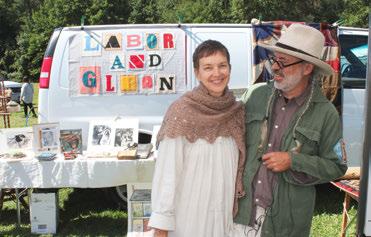

BRIMFIELD, MASS. — By all accounts, Brimfield 2024 was a year of contrasts. Many days during the May edition were plagued by soaking rains while shoppers and vendors in the July markets sweltered under scorching suns. To close out the year, nearperfect weather smiled down on the thousands who descended on the mile-long stretch of Massachusetts Route 20.


Pleasant weather and plentiful dealers brought savvy shoppers to Dealer’s Choice field on September 3, with the field opening at 11 am on the first day of the week-long festivities taking place elsewhere in Brimfield. In fact, Dan from Dantiques, Indiana, Penn., said it was a “top ten day” as far as the weather went, and that’s saying something, because he has been coming to Brimfield for 40 years.
Reflecting current market trends, the field was flooded with newer dealers who specialized in vintage clothing. Justin Steinke of Solid.Goods.Vintage and BarbaryBradleyObjects, Englewood, Ohio, noted that “clothing, especially 50s workwear is hot right now.” Though he commented, “I just do what I love, I don’t do trends” — a sentiment many veteran dealers and collectors alike can relate to. Many jewelry and clothing art







dealers were housed beneath the field’s large rear pavilion, a welcome reprieve for shoppers as those booths were sheltered from the sun beating down on shoppers in the afternoon. Other merchandise to be had under the pavilion included Asian art, paintings, vintage cameras, coins and other small collectibles.
New England Motel
“The field has never looked better,” observed Richard A. LaVigne, the visual architect
behind Galleries at Knollwood, which had a dynamic looking presentation in one of the three permanent pavilions in the center of New England Motel. The field, which opened its doors at 6 am on Wednesday, September 4, had several new vendors who brought a carefully curated selection of antique and vintage fine and decorative art with decorator-appeal. Among these was Jaime Roche, owner of Knock on Wood from Norwalk, Conn. She had showed at neighboring Black Swan Meadow for years
but it was her first time at ‘The Motel.” Her large booth in the center of the field was distinguished by plank flooring that was covered with rugs. Not only did the flooring physically elevate her offerings of customdesigned contemporary furniture from the dew-soaked field, but it gave her booth a finished look. A pair of fuzzy chairs and a
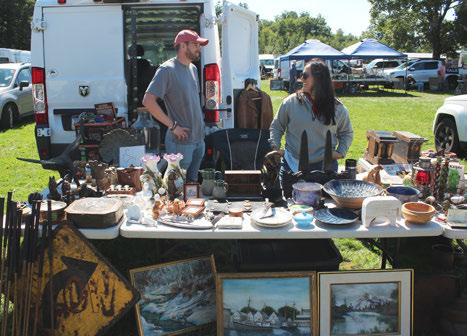
black painted coffee table were among her early sales. Long a center for antiques, Hudson, N.Y., has, in the past few years, become a go-to destination for vintage furniture dealers and interior decorators. Hudson showroom Modern Exchange has been participating at New England Motel for several years and is one of the
vendors who gives the field a decidedly vintage design feel. Hannah Khachadourian counts many A-list designers and hotel groups among her clients but likes the competition she feels from other vendors of similar furnishings. Her booth would best be described as an eclectic blend of antique and vintage furniture that combines both





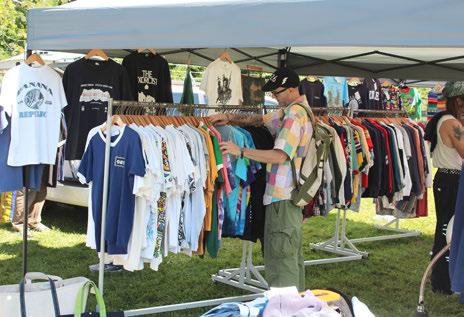


European and American styles. She and her team participate in just two shows annually: Brimfield and Round Top.
Contemporary custom crafts have come to have a strong presence at New England Motel. The field included Lisa Bodzinski, who is a home herbalist, medium and henna artist who started showing at Brimfield in July 2023, so she has now had a full year under her belt.
Heart-O-The-Mart Orleans, Mass., fine art dealer Kevin Rita, who was showing at Brimfield for the first time since 2020, used the opportunity to exhibit more than a dozen works by Tim Nicols (1931-2010), a Bos-


The sign says it all. Seen Olde Good Stuff, Youngstown, Ohio. Dealer Perry McCoy, of course, had many more, plus a selection of tobacco and coffee tins with advertising. McCoy does all the Brimfield shows except July. —May’s Antique Market
ton painter and MFA School teacher as well as Yale-educated lawyer, whose estate Rita is handling. Nichols’ work was influenced by Abstract Expressionism, but because he had an aversion to commercial promotion, he was never given recognition during his lifetime. Rita hopes to change that, and was asking $1,200 for each 46½ by 52 inch canvas. He was sharing space with fellow Orleans fine art dealer, Bill Wiebel.



Borsino and Barbara Skibe were enthusiastic about their Pilgrim Century chair, shown right, as well as the Eighteenth Century sawbuck table, which extended dining to 7 feet 7 inches. The
which had a replaced seat, and the
were both found in Massachusetts. —May’s Antique Market.
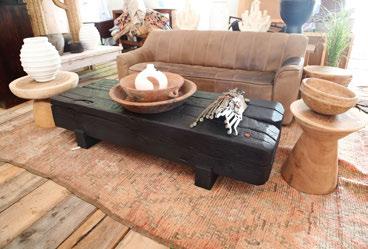
The plank flooring and rugs gave the broad booth of Knock on Wood a sense of permanence. The firm, which has both a warehouse and showroom in Norwalk, Conn., was showing at New England Motel for the first time. The black coffee table was one of owner Jaime Roche’s early sales.
It has been just a month since we saw Gene Pratt out in full force at the New Hampshire Antiques Dealers’ Association (NHADA) show in Manchester, N.H. He said he’d had a great show in New Hampshire and brought a different, but equally diverse selection to Brimfield, including stoneware and redware, a wooden running horse weathervane, primitive furniture and signs. Other NHADA show dealers at Heart-O-The-Mart were Sandy Jacobs and Drew Epstein (Swampscott, Mass.,) Bruce Emond and Village Braider (Plymouth, Mass.), DeWolfe & Wood Rare Books (Alfred, Maine) and Period To Mod/Brennan & Mouilleseaux Antiques & Design (Briarcliff Manor, N.Y.).
September 3 was likely Queen City Antiques’ 100th Brimfield show. The Buffalo, N.Y., dealer has held this spot on the Dealer’s Choice field for more than 25 years but shows at some of the other fields as well.
May’s Antique Market Weather — every show manager prays for its good behavior on
opening day, dealers plan for contingencies to counter its bad side and show-goers seem to be indifferent to it. May’s Antique Market marked the beginning of its 48th season of operating in all kinds of meteorological conditions



and usually brings books and ephemeral goods.

The crew at Village Braider was looking a little hot and hungry when we came through Heart-O-The-Mart. Bruce Emond, seated far left, said the pair of statues sold to a buyer from California.

Drew Epstein had, among several framed works, Paul Rocheleau’s photo of Shaker baskets. He also had a Shaker measure for those interested in Shaker material. Scoff Bassoff-Sandy Jacobs, Swampscott, Mass. —Heart-O-The-Mart

Washington, DC,-based dealer Matthew Corrigan (seated in the background) specializes in Chinese antiques and has been setting up at Heart-O-The-Mart for several years. This wall light dated to probably the late Nineteenth Century and was one of two he had.


Vintage clothing dealer Casey Hanrahan of Cranston, R.I., holds up a couple of tees from his collection. There is some discussion among dealers about whether there is too much vintage material, especially clothing, Martha May, owner of May’s Antique Market, said, however, that she invites vintage clothing dealers because they often bring their young friends who deal in good, different merchandise. “They work hard,” she said.


“He always sets up at May’s Antique Market,” said Johnny Magure of Colonel’s Collectibles, Providence, R.I., and does all three shows in the season. He deals in records, comics, art and “unique” antiques. There was even a real clown’s suit, shown back right, in his booth.


on September 5, with halcyon skies and comfortable temperatures as gates opened at 9 am to an energetic crowd of shoppers. “It was very good. Things went very well,” said a tired but pleased Martha May after the show closed. “There was an uptick on Friday and Saturday compared to two years ago. Every Friday and Saturday, it seems more and more people come. All I can say is that it was successful, and the dealers did well. There is a younger crowd coming in to sign up with us.”
When asked if there was too much vintage clothing on the field, May responded, “I think it’s 50-50 as far as the vintage dealers go. We have younger dealers coming in with very good traditional merchandise, too.” May pointed to Heather Lalonde, owner of New England Old World Antiquities (NEOWA), based in the Pioneer Valley in Western Massachusetts, who was selling early oak



Within two hours of New England Motel opening, Richard A. LaVigne and Antiques at Knollwood Galleries had sold several things, including club chairs, sculptures, frames, mirrors, wall brackets and wall appliques. Among the choice pieces still waiting for a new home was this Colonial Revival turned armchair.
and period antiques furniture.

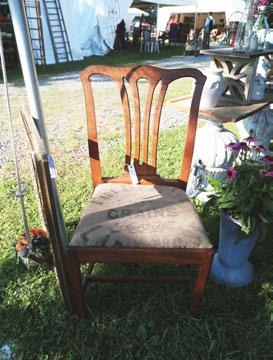
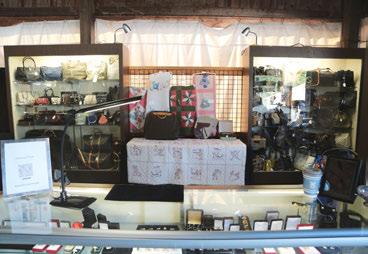

“I do have a cluster of younger people in the back of the field that are not selling vintage. I think I have five of them. They’re out of the Philadelphia area, as well as Brooklyn and New Jersey. They tend to do a lot of shows together and they come in with some really great stuff — not middle of the road; they’ve got a good eye, they work really hard.”
just praying for good weather on opening day.”
Antiques and The Arts Weekly inquired if there were any changes planned for next year’s market, to which May replied, “I’m
The 2025 Brimfield Antique Flea Markets will take place May 13-18, July 8-13 and September 2-7. For information, www.brimfieldantiquefleamarket.com.


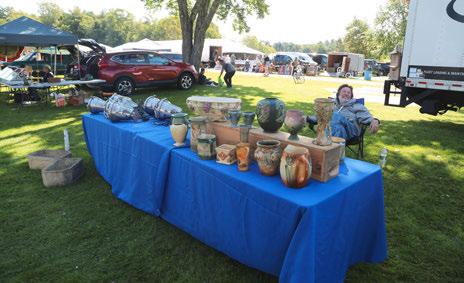


The most popular lot in the toy category was this Unique Art Artie & Jojo tin wind-up clown car; it drove out for $156.

This folky portrait of Hambletonian, one of the most famous American racehorses, was the highest priced item in the sale, finishing at $6,250.
N.H. — If people were asked to name three famous racehorses, their answers would probably include Seabiscuit and Man o’ War, while a third might be Hambletonian. Foaled in 1849, he was a Standardbred, better known as a trotter, used in harness racing. Hambletonian’s racing career was short, but his time as a stud was extensive; in fact, he is known to have sired at least 1,000 foals but possibly as many as 4,000. He is regarded as the “Father of the American Trotter” and he is the ancestor of most present-day harness racers. Flying Pig Antiques’ September 9 Multi-Estate Eclectic Collection of Antiques sale

included a folk art portrait of the horse. Earning $6,250, it was the highest priced item in the sale. The unsigned, unframed painting had been extensively researched by the consignor, who was at the preview and told Antiques and The Arts Weekly they believe it had been painted in western Vermont or eastern New York It sold to a New Hampshire buyer. The painting was not the only item in the sale to interest bidders. There was Mission furniture, a collection of Masonic and

other fraternal memorabilia, blue Staffordshire, toys made from tin and other materials, stoneware and the painted woodenware and country furniture that one expects from a Flying Pig auction. A signed Stickley six-drawer tall chest was the second highest earner of the day, finishing at $4,375. There was also a collection of carved Eighteenth and Nineteenth Century French furniture from a home in Watch Hill, R.I., a French-style chateau owned by William H. Andrews which had been the subject of an illustrated article in the April 1927 issue of The Architectural Record. The house was designed by Mott B. Schmidt, who worked for an upper-class clientele that included the Vanderbilt and Morgan families. The material
from this home was in fine condition and there were some good buys to be had, especially with the larger pieces of furniture. The most popular item in the collection was an Eighteenth Century carved walnut pipe rack that realized $1,500. Of dovetailed construction and featuring a drawer in the base, it stood 20 inches tall. A tall, narrow and heavily carved wardrobe, known in France as a bonnetière, sold for $875. An Eighteenth or early Nineteenth Century walnut buffet, 85 inches tall, had plate racks over a storage cabinet and went out for $282. Roxanne Reuling, co-owner of Flying Pig, said that interest in this collection was widespread, with pieces going to Canada, Malta and Egypt.
A collection of about 20 Mason-
ic, Odd Fellows and other fraternal items were spread throughout the sale. A ceremonial 14K gold miniature trowel, one of the Mason’s symbols, earned $532. An engraving indicated that it had been presented to the “Isaac Davis Lodge of Perfection” in 1932. Small, it measured only 3¾ inches long and contained approximately 13 grams of gold. A Masonic sash and apron, cataloged as “attributed to President Andrew Johnson, Greenville Lodge #119” sold for $344. It was framed in a glass-topped case. Johnson was one of 15 Freemason’s who, according to the White House Historical Association, have been President of the United States. A painted Masonic apron with some condition issues, circa 1800, sold for $188. There were

This miniature presentation trowel was one of several Masonic and fraternal items offered. In 14K gold, with a bone handle and dated 1932, it realized $532.



The second highest priced item of the day was this signed Stickley Mission oak tall chest. In fine condition, it brought $4,375.

also several Odd Fellows items, including a selection of nicely framed painted aprons. These seemed like good buys, as two sold for $88 each and the third brought $50. The collection included items from other fraternal societies, such as the Antique United Order of Smiths, an organization founded to benefit blacksmiths.
Tin toys included a Marx Whoopee Car wind-up tractor with its driver, which realized $100. A penny toy horse pulling a carriage with a driver by Meier went out for $75, while a lot with two Japanese wind-ups — a mother with three duck-
lings, together with an acrobatic monkey — brought $31. The highest price in the category was earned by a Unique Art Artie & Jojo wind-up clown car, which sold for $156. There will always be a good selection of firkins, painted pantry boxes, bowls and country furniture at a Flying Pig auction, and this sale was no exception. The first lot of the sale was a 10½-inch green-painted, covered pantry box with a large yellow and red star on the lid; it realized $313. A large, redpainted bowl, measuring just under 18 inches in diameter, realized $1,375. A large tren-

The selection of

proportions charmed bidders and it realized $281.

Much of the French furniture and accessories came from this home in Watch Hill, R.I. An article about the house, with this photograph, was in the April 1927 issue of The Architectural Record.
cher more than 20 inches in length, also in red paint, topped off at $469. Furniture included a Nineteenth Century tavern table, measuring 50 inches long, with a two-board top and breadboard ends that sold for $125 and a 10-drawer gray-painted apothecary or spice chest, which finished at $500. The blue Staffordshire selection included platters and several plates. The “Baltimore & Ohio Railroad” dinner plate, with a shell border and circular center by Enoch Wood & Sons, sold for $282. By the same maker, a slightly larger dinner

designs
plate, depicting the “Pine Orchard House, Catskill Mountains” with a circular center, brought $219. This hotel, which opened in 1824, was one of the Grand Hotels of the Catskills; it operated until 1941. A 13-inch light blue platter from the American Scenery series by Ridgway, in the “Columbia Bridge on the Susquehanna” pattern, brought $188.
After the sale, Reuling said there had been strong participation on the internet, with more than 500 registered bidders. As the sale got underway, there were more than 400 bid-

ders online “We had a number of international bidders, which is always nice to see, and some of the stuff found buyers in several foreign countries. We were pleased with the results.”
Prices quoted include the buyer’s premium as reported by the auction house.
For additional information, www.flyingpigantiquesnh.com or 603-543-7490.

Compiled By Antiques and The Arts Weekly
Carly Timpson
BOSTON — Recently, two American institutions announced that they would be returning artifacts to the Republic of Türkiye.
The Museum of Fine Arts, Boston (MFA), has reached an agreement with the Republic of Türkiye to return a gold and carnelian Necklace (1982.413), which was probably looted from a tomb near the village of Kendirlik, Bintepeler in 1976.
The fragmentary necklace is believed to come from the archaeological site of Bintepeler, which consists of over 100 tumuli , or burial mounds. In 1976, the archaeological museum of Manisa, Türkiye carried out excavations at a tumulus near Kendirlik in response to reports of looting in the area. From the burial site and from a local inhabitant, archaeologists recovered beads and other fittings that are nearly identical to those in the MFA necklace. It is likely that the MFA necklace originated at the same tumulus. The finds that were recovered are now housed at the Manisa Museum. The necklace, on the other hand, appears to have been smuggled out of the country.
The MFA purchased the necklace from a London dealer in 1982, at which time it was said to come from Asia Minor (another name for ancient Anatolia, which is today Türkiye). No other ownership history was provided. Scholars alerted curatorial staff to literature on the looting of the tomb and the comparative elements in Manisa. The MFA conducted its own research and contacted the offices of the Ministry of Culture of the Republic of Türkiye through the Turkish Consul General in Boston about the necklace last fall. Following scientific and archival research which was carried out by experts from the Ministry of Culture and Tourism of Türkiye, it was concluded that the necklace likely originated from the Bintepeler Necropolis Area in Manisa province.
Additionally, the J. Paul Getty Museum and the Turkish Ministry of Culture and Tourism today announced the return to the Republic of Türkiye of an ancient bronze funerary couch dating back to

Necklace, 550-450 BCE, gold and carnelian. Classical Department Exchange Fund. Photograph ©Museum of Fine Arts, Boston.
circa 530 BCE.
The object was acquired in 1982 from a Swiss dealer who provided false provenance indicating the piece had been in European collections since the 1920s. Research conducted by the Turkish Ministry of Culture and Tourism and the J. Paul Getty Museum determined this claim was false and that the artifact was illicitly excavated in the early 1980s from an ancient tomb in the region of modern-day Manisa. Fragments of linen adhering to the object match others remaining in the tomb that were subsequently recovered by Turkish archaeologists along with fragments of wood and bronze sheet and the remains of marble and ceramic vessels that helped date the tomb.
“With this return, we are pleased to bring to a conclusion a long-running investigation of the couch’s origins by Turkish and American scholars,” said Timothy Potts, Maria Hummer-Tuttle and Robert Tuttle director of the Getty Museum. “Their research
helped recover the archaeological and historical context for this exceptional object, while Getty conservators analyzed its materials and manufacturing technique.”
“I believe that each return of cultural property illegally removed from its lawful place sends a strong message to traffickers,” said Gökhan Yazgı, deputy minister of Culture and Tourism. “The bronze couch is a rare archaeological artifact that was unlawfully taken from its home. Thanks to the renewed dialogue between Türkiye and the Getty Museum, it will now be preserved where it belongs. Better protection of cultural heritage can only be achieved through mutual understanding, and by rectifying past actions.”
The couch, or kliné — a day bed used for banqueting — is a rare surviving example of ancient luxury furniture otherwise known largely from depictions in other media, such as frescoed walls and painted pottery. With legs and rails of cast bronze over an iron framework, and perforated copper sheets riveted together and wrapped around iron rail cores, the metal couch replicates more common wooden ones with turned legs, projecting tenons at the corners and a latticed surface that once supported cushions. Decorative details such as incised lotus friezes and rosettes suggest Lydian or East Greek manufacture. Potts added: “We seek to continue building a constructive relationship with the Turkish Ministry of Culture and with our archaeological, conservation, curatorial and other colleagues working in Türkiye, with whom we share the common mission to advance the preservation of ancient cultural heritage.”
Yazgı added: “Türkiye and the Getty Museum may hold differing positions on the matter of return and restitution. However, the announcement today can be seen as a sign of closer cooperation in the future toward the shared goal of combating the illicit trafficking of antiquities. I believe both sides are now much closer to understanding each other’s perspectives.”
OTTAWA, ONTARIO (AP) — Canadian police say a renowned portrait of Winston Churchill that was reported stolen from an Ottawa hotel has been tracked down in Italy. Investigators will travel to Rome later this month to retrieve the 1941 portrait of the British leader taken by Ottawa photographer Yousuf Karsh, police said in a news release.
“Once in Ottawa police custody, the portrait will be ready for the last step of its journey home to the Fairmont Château Laurier, where it will once again be displayed as a notable historic portrait,” police said.
Police said “The Roaring Lion” was stolen from the Fairmont Chateau Laurier in Ottawa, sometime between Christmas Day 2021 and January 6, 2022, and replaced with a forgery. The swap was only uncovered months later, in August, when a hotel worker noticed the frame was not hung properly and looked different than the others.

“It was determined that the portrait was sold through an auction house in London to a buyer in Italy, both of whom were unaware that the piece was stolen,” the release said.
“With the help of public tips, forensic analysis and international cooperation, investiga-
tors tracked down the individual responsible for the theft.”
Nicola Cassinelli, a lawyer in Genoa, Italy, purchased the portrait in May 2022 at an online Sotheby’s auction for 5,292 British pounds ($6,983).
He says he got a phone call from the auction house that
October advising him not to sell or otherwise transfer the portrait due to an investigation into the Ottawa theft.
Cassinelli said he was surprised to learn that the answer to the high-profile heist might be hanging on his living room wall. He plans to attend a ceremony at the Canadian Embassy in Rome next Thursday, September 19, to mark the return of the portrait.
At a press conference at the hotel Wednesday afternoon (September 11), Geneviève Dumas, general manager of the Fairmont Château Laurier, said the theft happened at the height of the Covid-19 pandemic.
“Everything was closed, and we narrowed the gap to 12 days,” Dumas said. “The way that happened, there was nobody in the hotel and we discovered it only eight months later.”
Ottawa police detective Akiva Gellar said the portrait was recovered after “a very extensive investigation” that took more than two years but offered few specifics.
Much of the investigation is “still very sensitive because the matter is before the courts,” he said.
“A lot of the details about how we found it, and further details will be released during the ceremony in Rome,” said Gellar. “And later down the road, once we have the portrait back in Canada, we will be able to speak more about that.”
Police arrested a 43-year-old man from Powassan, Ontario, in April and have charged him with stealing and trafficking the portrait.
The man, whose name is protected by a publication ban, faces charges that include forgery, theft over $5,000 and trafficking in property obtained by crime exceeding $5,000.
The famous image was taken by Karsh during Churchill’s wartime visit to the Canadian Parliament in December 1941. It helped launch the career of Karsh, who photographed some of the Twentieth Century’s most famed icons, including Nelson Mandela, Albert Einstein and Queen Elizabeth.
By EléonorE HugHEs RIO DE JANEIRO, BRAZIL
(AP) — Indigenous chants and the rattle of maracas resounded Thursday in a Rio de Janeiro park, where Brazil’s Tupinambá people gathered to celebrate the homecoming of a sacred cloak absent for some 380 years.
Made of feathers from the scarlet ibis, the artifact from northeastern Brazil resided in Copenhagen until the Danish National Museum donated the cloak to its Brazilian counterpart.
President Luiz Inácio Lula da Silva and Indigenous Peoples Minister Sonia Guajajara attended a ceremony at Brazil’s National Museum atop a hill in the Boa Vista Park.
“It is impossible not to appreciate the beauty and strength of this centuries-old and well-preserved piece, even after so much time outside Brazil, abroad. It is our commitment to preserve this heritage,” Lula said, addressing dozens of Indigenous people plus others of the general public.
Celebrations to welcome the cloak have been underway since last week. The Tupinambá traveled 28 hours overland from the northeastern state of Bahia to enter the museum where it hangs in carefully calibrated lighting and temperature conditions to ensure its preservation. There, they conducted rituals and prayers with the cloak they view as a living ancestor rather than an object.
Reconnecting with the cloak, which was once central to certain ceremonies, was “really wonderful,” Jamopoty Tupinambá, one of the group’s leaders, said Wednesday near
their encampment in the park.
“The emotion was too much.
The enchanted ones arrived, too,” she said, referring to spiritual ancestors.
Some at the encampment pounded drums on the parched grass amid drifting incense smoke, adorned in feathered headdresses. Anticipation and excitement due to the momentous occasion hung in the air.
The cloak stands at nearly four feet tall, and the Dutch took it from Brazil in about 1644, according to a statement from Brazil’s federal government. It has been in Denmark’s National Museum for 335 years, it said.
“In the process of colonization, he (the cloak) was taken away abruptly, violently, taking from the people what represented their greatest strength,” said Yakuy Tupinambá, an elder of the Indigenous group.
Centuries later, in 2000, the museum in Copenhagen lent the cloak to an exhibition in Sao Paulo. That’s when Jamopoty’s mother, Amotara Tupinambá, first saw it.
“When she arrived there, she felt great emotion. The cloak showed her, ‘I am here.’ … She was amazed,” Jamopoty recalled. The notion of petitioning for the cloak’s permanent return was born.
Years later, Glicéria Tupinamba, from a village in Bahia state, traveled to Copenhagen to help identify pieces they have in their collection. The idea of securing its homecoming gathered pace.
Museums across Europe are under pressure to repatriate cultural objects. For years, the Greek have demanded the
return of sculptures from the Parthenon temple on the Acropolis, which currently reside in the British Museum. French President Emmanuel Macron oversaw the much-trumpeted restitution of colonial-era treasures to Benin in 2021. Since then, France has sent little else of significance amid critics’ claims such moves would empty France’s cherished museums.
Denmark’s National Museum has received three repatriation requests in the past decade, head of research Christian Sune Pedersen told The Associated Press. They responded positively to two, including that of Brazil, deciding to donate one of its five feathered cloaks partly to help rebuild Brazil’s national museum that was ravaged by flames in a devastating 2018 fire.
Bringing it back to Brazil was a complicated operation coordinated between the foreign affairs ministry, Brazil’s embassy in Denmark, the national museums of both countries and Tupinambá leaders.
Extreme care was required to avoid damaging the delicate feathers, and its sealed box was only opened once in an air-conditioned environment, said João Pacheco de Oliveira, an anthropologist and curator of the National Museum’s ethnographic collections.
It marks the first time that an Indigenous artifact of such significance has been returned to Brazil, he said.
“The expectation is that this will create new possibilities for donations or even repatriation,” he said.
Lula’s government took office

Brazil’s President Luiz Inacio Lula da Silva, left, speaks during a ceremony celebrating the return of the Indigenous Tupinambá people’s sacred cloak to Brazil, in Rio de Janeiro, Thursday, September 12, 2024. The garment, made from bird feathers and plant fibers, was repatriated to Brazil after having spent more than 300 years in the National Museum of Denmark. (AP Photo/Bruna Prado).
in 2023, pledging to defend Indigenous groups’ land rights and established a ministry for Indigenous peoples. Such action stood in contrast to his predecessor, Jair Bolsonaro, who refused to expand Indigenous land.
However, many Indigenous people have bemoaned the slow pace of Lula’s government to expel illegal miners and landgrabbers from their territories, and to establish new ones.
In a nod to their frustration, Indigenous Peoples Minister Guajajara said Thursday she wishes the number of demarcated territories were higher.
“We really need this number to reflect the desire of the various Indigenous peoples, who — like the Tupinambá cloak, our
relative, whose return we celebrate today — want to return home,” she told the crowd.
The Tupinambá are among those asking for their land to be recognized as an Indigenous reserve and given formal protection, a process known as demarcation. Brazil’s justice ministry is analyzing their request, according to a June statement from Brazil’s Indigenous affairs agency, known as FUNAI.
The cloak’s return is even more significant in that context, said Jamopoty Tupinambá.
“The cloak for us is the strength of the people. When he left, the people were weakened. Now he is bringing strength for the demarcation of his territory.”
LONDON — For the first time in 120 years, The Courtauld Gallery will reunite an extraordinary group of Claude Monet’s Impressionist paintings of London in the major exhibition “The Griffin Catalyst Exhibition: Monet and London. Views of the Thames,” running through January 19. These ravishing works have never been the subject of a UK exhibition. Begun during three visits to the capital between 1899 and 1901, the paintings depict Charing Cross Bridge, Waterloo Bridge and the Houses of Parliament. The series was unveiled in Paris in 1904 to great critical acclaim. Monet fervently wanted to show it in London the following year, but the project fell through. The Courtauld Gallery will therefore realize Monet’s unfulfilled ambition of exhibiting this distinct group of works in London, just 300 meters from the Savoy Hotel where many of
them were painted.
Claude Monet (1840-1926) is world renowned as the leading figure of French Impressionism, a movement that changed the course of Modern art. Less known is the fact that some of his most remarkable paintings were made not in France but in London. They depict views of the Thames, capturing the river and its surrounding architecture as they had never been seen before, full of evocative atmosphere, mysterious light and radiant color. Monet came to London in the wintertime, fascinated by the effects of the London fog, a phenomenon produced by the city’s heavy industrialization in the Nineteenth Century. In London, the fog took on a particular density and a variety of hues that occurred nowhere else. Monet’s paintings are undoubtedly amongst the most significant representations of the Thames ever made and embody the com-

plexity of his practice, 40 years after his debut, as he pushed the Impressionist approach to the extreme.
Monet started the paintings during his three long stays in
London in 1899, 1900 and 1901, and finished them in his studio in Giverny, north of Paris. While he eventually painted almost 100 views of the Thames, his most ambitious project to date,
the exhibition focuses on the smaller group of 37 paintings that were presented at the unveiling of the series in 1904. Monet completed these works as a unit specifically for their public display and he considered them the finest representatives of his artistic project. They constituted, in his eyes, the true “Thames series.” After the show, the paintings were dispersed, purchased by collectors in France and abroad. The exhibition “The Griffin Catalyst Exhibition: Monet and London. Views of the Thames” features 21 paintings, 18 of which were in the 1904 unveiling, in an unprecedented effort to recreate the display that Monet himself put together and the experience he wanted his audience to have seeing these extraordinary works.
The Courtauld Gallery is in the Somerset House at Strand. For information, www.courtauld. ac.uk.
LARCHMONT, N.Y. — Clarke Auction Gallery paid homage to the upcoming autumn solstice by conducting an End of Summer “Blockbuster” Auction on September 8. There was plenty of arm candy by Rolex in this sale, jewelry from Van Cleef & Arpels and blue-chip fine art.
“I’d say it was a strong sale, we were happy with it,” said the auction gallery’s owner Ronan Clarke. The sale totaled approximately $850,000 with an approxi -
mately 95 percent sellthrough rate. “In-gallery attendance was light, probably because of the good weather,” said Clarke. Online participants numbered between 4,000 and 5,000.
The sale’s most notable price was achieved by a 1960s George Nakashima (American, 1905-1990) double dresser from a New Paltz, N.Y., estate. According to the firm’s senior appraiser, Whitney Bria, there was strong bidding action on it and it ultimately

sold to an in-house bidder for $27,500. The dresser featured an exposed dovetail case, two small upper flush drawers over six deep drawers with recessed pulls and a recessed cross form base.
There were two additional notable lots from the Nakashima Studio. A rectilinear chest from the New Paltz estate was bid to $8,750; it featured a rectangular top and there was one blind drawer above three drawers, each centering a recessed, rectangular handle. The chest stood on vertical plank form legs. The New Paltz estate also contributed a pair of Mira stools crafted from black walnut, which went out at $8,125.
More Midcentury Modern furniture came in the form of six brass wheel back chairs attributed to Gio Ponti, which left the gallery at $2,750.
From a Larchmont, N.Y., estate, the rare and original set included two armchairs and four side chairs. The condition was deemed good,

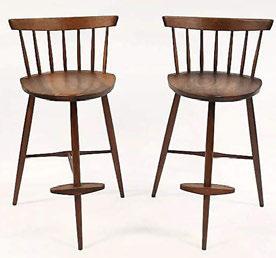


although the set needed cushions.
Fine art was led by African American artist Vincent D. Smith’s (1929-2003) “Obeisance For Biko,” a 1985 composition in oil, sand and rope on canvas that combined to form a layered abstract with earthy tones. Selling at $23,750, it was signed lower right and measured 54 by 68 inches. There were two additional Smith paintings in the sale among the top performing lots. “Queen of the Nile,” an oil and sand on canvas work done in 1975 that depicted a female figure supine in burial form above a watery band filled with swimming creatures; it brought $17,500.
Another oil, sand and rope on canvas painting from 1983, titled “The Root Detour,” was from Smith’s “Dry Bone Series” and took $15,000. All three works came from the Westchester County, N.Y., estate of the artist, each bearing a G.W. Einstein Company Inc., label verso.
French genre painter, Charles-Émile Jacque (18131894), was represented by a pastoral oil on canvas scene, “Sheeps and Shepherd,” that was signed lower left; a plaque on the frame’s lower center also identified the artist. On the back of the painting,
which came from a Bronxville, N.Y., estate, were labels from the Brooklyn Museum (1920), Christie’s and Wildenstein & Co. In its frame, it measured 37½ by 48 inches, and it crossed the block at $11,250.
A final price of $20,000 was posted for a large 17-inchhigh signed L.C. Tiffany Favrile floriform vase from a Scarsdale, N.Y., estate. The top selling timepiece was a Rolex Cosmograph Daytona steel watch, which changed hands for $20,000. It was produced in 2010 and featured a 40mm round case with a smooth, high-polished steel tachymeter bezel calibrated up to 400 units. Luminous hour markers populated the watch’s black dial, which was complemented by luminous steel and black enamel baton hands, a central, high-polished steel chronograph seconds hand (retour-en-vol), a small seconds subdial at the six o’clock position, a 30-minute counter at three o’clock and a 12-hour counter at nine o’clock. All of this was fitted onto a stainless-steel Oyster bracelet. This watch came from a New Britain, Conn., estate, complete with a Rolex box, factory service booklet and a Rolex Official Chronometer Certification/Guarantee booklet.



Nakashima Studio rectilinear chest from the New
N.Y.,
featured a rectangular top and one blind drawer above three drawers, each centering a recessed, rectangular handle. It realized $8,750.
Jewelry highlights, selling for $9,375 each and both from a Rye, N.Y., estate, were two Van Cleef & Arpels 18K bicolor white and yellow gold ribbed bracelets. Each had a hinged slide closure and were stamped, “VCA France 18kt ©2 K204.”
A piece of jade in an 18K yellow gold foliate form brooch, which made $4,000, was purchased in Japan in the 1960s. The brooch prominently displayed the central, prong-set carved jade. By consignor provenance, the jade was later fashioned into a brooch between 1966 and 1967 by a small boutique jeweler in Geneva. Though unmarked, the brooch was accompanied by an August 2, 2024, GIA report that stated it was a “pierced carving set in a yellow metal brooch, translucent, green, jadeite jade, type A.”
Notable Asian objects included a signed Chinese painting depicting a tiger, lion, lioness, leopard and a wolf, with offspring. The lower left corner bore two red seals and the painting, which sold for $5,250. The category also featured a conical Chinese official’s summer hat from a


Clinton Corners, N.J., estate, which heated up from a $400/600 estimate to sell for $1,375. Comprising stiffened cloth decorated with red fringe, the hat featured a purple silk lining. Topping it was an oval cap finial or surknob; the lot came with two additional finials — one blue and one transparent crystal that denoted the fifth rank. The hat was further accompanied by a folding hat stand. And what Midcentury Modern man cave wouldn’t be complete without a very cool vintage Philco Predicta television on its original and unusual stand? The example in Clarke’s sale came from an East 19th Street, New York City estate and earned $3,000. The only thing keeping the successful bidder from watching their favorite 1950s sitcoms on it was the missing power cord. Catalog notes further stated, “We have not attempted to power up or otherwise test the TV.” Caveat visum
All prices given include the buyer’s premium as stated by the auction house. For information, www.clarkeny.com or 914-833-8336.
This 18K yellow gold foliate form jade brooch had an interesting story, according to catalog notes. The jade was purchased by the consignor in Japan in the 1960s, later fashioned into the brooch between 1966-67 by a small boutique jeweler in Geneva.

Untested and missing its power cord, this very cool vintage Philco Predicta television on its original and unusual stand nevertheless had the look that Midcentury futurist collectors crave. It found a successful bidder at $3,000.


From a Larchmont estate, this set of six brass wheel back chairs attributed to Gio Ponti brought $2,750.


A conical Chinese official’s summer hat comprised of stiffened cloth decorated with red fringe and featuring a purple silk lining, sold for $1,375 against a $400/600 estimate, and came with a folding hat stand for display.
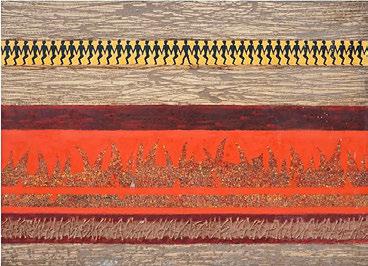
WASHINGTON, DC — The National Museum of Women in the Arts (NMWA) presents a solo exhibition of work by multidisciplinary artist Suchitra Mattai (b 1973). On view through January 12, “Suchitra Mattai: Myth from Matter” features approximately 40 mixedmedia works and large-scale textile installations that explore how memory, myth and visual culture can counter colonial and patriarchal narratives. The exhibition marks the Los Angeles-based artist’s first major solo museum exhibition on the East Coast and coincides with three other solo presentations taking place across the country. A fully illustrated catalog accompanies the exhibition.
Combining richly colored saris, vintage needlepoints, book pages, jewelry, tinsel, bindis, beads and other found objects, Mattai creates layered textile installations, sculptures, collages and paintings that reenvision Indo-Caribbean colonial history. Extending Mattai’s practice of incorporating materials and symbols from across disparate times and places, the exhibition will present the artist’s works alongside a selection of related historical objects from Europe and South
Highest Prices Paid for: lobby cards, 1 sheet, 3 sheets, window cards, glass slides 773-525-9152
email: posterboss@aol.com
WANTED
Antiques of all kinds. Will buy for cash or will sell on consignment –no lot too large or too small.
B & S Auction Service
Thomas Barrows P.O. Box 141 Portland, Conn. Tel 860-342-2540
Asia. The resulting juxtapositions initiate a visual conversation between old and new, East and West and history and mythology.
“We are honored to show the extraordinary work of Suchitra Mattai this fall,” said NMWA director Susan Fisher Sterling. “Her powerful tapestries provide rich narratives that speak to history, identity and migration.”
Mattai’s work restores the presence of marginalized people into histories from which they have been excluded. Using a practice she calls “brown reclamation,” the artist sews brown thread over the faces and bodies of white Europeans who typically populate pastoral landscapes. In “as we know it, as we dream it” (2023), Mattai incorporated a found tapestry that depicts two women sitting beneath a tree, a third woman perched above on a rope swing and a man who holds one end of the rope. Mattai darkened the figures’ skin and hair and added bright embroidery floss, floral appliqué and beads. Her disruption of the serene scene refocuses attention on those who were exploited and whose labor enabled this type of leisure. In this reinterpretation of history, the idealized colonial landscape becomes a space of recreation and respite for people of color, especially those of Caribbean and South Asian descent.

“future perfect” by Suchitra Mattai, 2023; embroidery floss, found objects, freshwater pearls and trim on vintage needlepoint, 25 by 19 inches; Collection of Julie and Bennett Roberts, Los Angeles; Courtesy of Roberts Projects; ©Suchitra Mattai; Photo by Heather Rasmussen.
directly on a mass-produced needlepoint reproduction, adding a jeweled headdress and pink tassel to the scene, while also sewing over the figure’s skin with brown thread. Traditionally, embroidery was both an act of decoration and repair; in Mattai’s work, it redresses single-sided histories that have long sidelined women and omitted people of color. Through cultural, familial and personal references, Mattai confronts systemic erasure on a scale that is both monumental and intimate. She creates new mythologies that reclaim colonial spaces, materials and histories — and center women and people of color. By subverting past narratives, Mattai manifests a more egalitarian future.
that allude to several places and cultures.
“Combining, recontextualizing and reconfiguring disparate materials is a way of making sense of the world around me and of reconciling multiple cultural spheres that I inhabit as an Indo-Caribbean woman,” says Mattai.

Mattai’s tapestries also call
attention to the unrecognized work of women. Historically, textile work was not considered a “fine” art due to its association with women’s domestic practices. Mattai upends this outdated designation, transforming vintage tapestries into vivid scenes of celebration and joy. In “future perfect” (2023), she reimagines artist Jean Honoré Fragonard’s “Young Girl Reading” (circa 1769). Continuing Fragonard’s well-documented practice of working and reworking his own paintings, Mattai makes interventions
Many of Mattai’s works include saris that she has received from the women in her family, friends and even strangers. “I often use vintage saris as a way of connecting women of the South Asian diaspora from around the world,” she says. In “The Center of Gravity” (2022), the artist incorporates her own childhood sari with vintage fabrics and ghungroo bells, which are typically worn around the ankles of classical Indian dancers. The large-scale abstract tapestry “a cosmic awakening” (2023) interlaces jewel-toned saris with shimmery tinsel, beaded fringe and tassels. The work traverses time and geography, as Mattai joins varied artistic mediums
Mattai’s Indo-Caribbean identity inspires much of her practice and the specific iconography and materials that she uses. However, her deft application of these personal references echoes the wider experience of global diasporas. The artist’s family arrived in Guyana by way of India in the Nineteenth Century, when both countries were under British colonial occupation; her great-grandparents crossed the Atlantic as indentured laborers to work on sugar plantations. Guyana achieved independence from Britain in 1966, just seven years before Mattai’s birth, and her family later immigrated to Canada.
Mattai learned to sew and embroider from her grandmothers, and she honors her lineage by weaving inherited textiles and heirlooms into her fiberbased sculptures and installations. Her work is both intercultural and intergenerational, informed by her home country’s history and created through practices and materials passed down from her ancestors. The National Museum of Women in the Arts is at 1250 New York Avenue, Northwest. For information, www.nmwa. org or 202-783-5000.
WASHINGTON, DC — Foregrounding Haiti’s significance as the world’s first free Black republic, “Spirit & Strength: Modern Art from Haiti” presents some of the most prominent artists to have lived or worked there over the past century. Featuring paintings by trailblazing Haitian artists like Rigaud Benoit, Hector Hyppolite and Philomé Obin, “Spirit & Strength” also includes works by renowned contemporary artists Myrlande Constant and Edouard Duval-Carrié. They are joined by African American artists like Lois Mailou Jones, Jacob Lawrence and William Edouard Scott, who looked to Haiti as a source of inspiration, demonstrating the remarkable reach of Haitian artistic production. On view through March 9, “Spirit & Strength” is the first chance to see 21 works by Modern and contemporary Haitian artists recently given to the National Gallery of Art by Kay and Roderick Heller and Beverly and John Fox Sullivan.
“‘Spirit & Strength’ is a landmark exhibition for the National Gallery, featuring works by Haiti’s most preeminent artists, who are now represented in our collection for the first time. Their range of expressions demonstrate the diversity of Modern Art, as well as the joy, beauty

“Mambo” by Andre Pierre, early 1960s, oil on fiberboard, 10 by 8 inches unframed. National Gallery of Art, Gift of Kay and Roderick Heller.
and gravity of Haitian history and culture, which remains influential across the African Diaspora and beyond,” said Kanitra Fletcher, associate curator of African American and AfroDiasporic art.
Organized thematically, “Spirit & Strength” presents paintings, textiles and works on paper by some of the most significant artists from Haiti’s past and present. The roots of Haitian modernism can be found in
the Indigenist movement of the 1920s, when artists and writers came together to develop a national identity inspired by folklore and popular culture.
Over the next several decades, artists developed their own styles based on personal interests, worldviews, social roles and geographic locations. With the support of the Centre d’Art, their success brought international attention to Haitian art, particularly from African American artists.
The exhibition begins with Haiti’s national history and depictions of everyday life. After winning their independence from France in 1804, Haitians endeavored to form an economy and establish their own democracy while honoring their traditions.
Works from the mid Twentieth to the early Twenty-First Century range from boisterous market scenes to solemn portraits of government officials. They shed light on historical events that were erased or obscured in coverage outside the country.
The second room focuses on Vodou lwas (spirits) and biblical narratives. Expressive paintings and textiles depict the distinctive characters of the lwas
Some works include vèvès, geometric symbols that together form a language of signs, each
used to invoke a particular lwa during rituals. Others draw on Vodou traditions to create surrealistic imagery that seems to occupy a space between dreams and reality.
The final room examines Haitian influence on African American artists who traveled to Haiti from the 1930s to the 1980s. In the early Twentieth Century, African American creatives began traveling outside the United States to work and study in places with a significant Black presence. Many found inspiration in Haiti’s revolutionary history and identified with Haiti’s struggles against racism and imperialism. Interested in exploring their shared African roots, these artists produced important work influenced by and depicting their time in Haiti. Their art reflects the significance of Haitian history and culture in the wider African Diaspora. “Spirit & Strength” also features a reading room with ambient Haitian music and texts for adults and children, inviting visitors to learn more about Haiti and its influences on Modern Art.
The National Gallery of Art is at Constitution Avenue Northwest. For information, www.nga. org or 202-737-4215.
NEW YORK CITY — This fall, a historical exhibition at the Grolier Club celebrates one of America’s greatest presidents and his leadership of the country during its most turbulent time. “Abraham Lincoln: His Life in Print” will exhibit the revered but rarely seen books, documents and ephemera that empowered Lincoln’s political ascendance, his leadership during the Civil War, and his efforts to end slavery. On view in the Ground Floor Gallery of the Grolier Club through December 28, the exhibition is composed of materials from the Americana collection of wellknown philanthropist David M. Rubenstein. “Abraham Lincoln: His Life in Print” is timed to appear during the US presidential election and fulfills the aims of the David M. Rubenstein Americana Collection to mount non-partisan presentations that foster civic engagement and historical understanding.
Among the more than 200 works on display are important editions of Lincoln’s greatest accomplishments, such as a signed Emancipation Proclamation, the Gettysburg Address, the Cooper Union Speech, and his debates with Illinois senator Stephen A. Douglas. Through original historical printings, the exhibition follows the life of Lincoln from his birth in the American West and his self-taught readings of literature, philosophy, and the law. It follows Lincoln as he is shaped by the political upheavals of the 1850s, tested by the secession of eleven Southern states, elevated by the twin efforts of emancipation and abolition, and murdered and mourned at the age of 56. The exhibition is curated by Mazy Boroujerdi, special advisor to the Rubenstein Collection, and is accompanied by a catalog published by Marquand Books.
“Lincoln’s story is the most fascinating and exemplary story in American presidential history,”
said Rubenstein. “He is not only our greatest president for having kept the Union together during a period of terrible division and discord. He is also a model American for his tremendous humility, for having continually sought consensus, for always bettering himself through reading and for making sure that the rights and protections enshrined in our founding documents are shared by all.”
“In many ways, books made Abraham Lincoln,” said curator Mazy Boroujerdi. “He became a lawyer through self-disciplined study, won the White House through the concurrent rise of American popular publishing and remains one of the most written about figures over the 160 years since his death, with each generation reinterpreting him through new biographies and research. There is no better way to tell the story of Lincoln than through books, and there is no better subject for a book exhibition than Lincoln.”
Among the treasures on view is the only edition of the Emancipation Proclamation that Lincoln signed. One of 48 copies printed for Philadelphia’s Great Central Fair in 1864, it was originally sold for $10 a copy to raise money for the United States Sanitary Commission, a civilian relief organization that assisted the medical and hygiene efforts of the US War Department. Also on view is a pocket-sized Emancipation Proclamation (1863), printed in Boston by the industrialist and abolitionist John Murray Forbes, which Northern soldiers distributed amongst African American communities at the front.
On view are printings of notable speeches that made Lincoln a rising political star, including the 1858 Lincoln-Douglas Debates. Vying with Stephen A. Douglas through seven district debates for a US Senate seat in Illinois, the men’s sharply opposing opin-
ALBANY, N.Y. — The Albany Institute has developed a major exhibition that marks the 400th anniversary of the founding of Fort Orange, the first permanent Dutch settlement that developed into the present-day city of Albany. “Delights of the Senses: Seventeenth Century Dutch Art and Life” is centered around a partnership between the Albany Institute and the Leiden collection, one of the preeminent private collections of Seventeenth Century Dutch paintings in the United States.
“Delights of the Senses” presents paintings and objects that examine Seventeenth Century Dutch culture through the five senses. In addition to 20 paintings from the Leiden collection, the exhibition includes several prints from the Frances Lehman Loeb Art Center at Vassar College, along with objects from First Church in Albany, Friends of Historic Kingston, Historic Huguenot Street, Historic Hudson Valley, the New
ions about slavery quickly became national news. First printed in newspapers, Lincoln published the compilation Political Debates (1860), a signed edition of which is on view. Lincoln’s 1860 Cooper Union speech was a tour de force of historical research and political rhetoric. First printed in 1860 as Tribune Tracts. — No. 4., Speech . . . Delivered at the Cooper Institute, Lincoln defined what abolitionists were fighting for and challenged proslavery factions as contrary to the Constitution, the Founders, and morality.
Lincoln’s Gettysburg Address is the most acclaimed speech by any American president. Named for the location at which the three-day military battle was won by the Union army in July 1863, at the cost of more than 51,000 Union and Confederate casualties, the speech is on view in the book An Oration Delivered on the Battlefield of Gettysburg (New York: Baker & Godwin, 1863). Another treasure featured in the show is a rare, signed souvenir copy on vellum of the Thirteenth Amendment, officially titled “A Resolution Submitting to the Legislatures of the Several States a Proposition to Amend the Constitution of the United States” (1865). Lincoln knew that only by amending the Constitution could the freedoms gained from the Emancipation Proclamation be protected.
Rubenstein sees Lincoln as continuing the project of the nation’s founding. “Lincoln was remarkably skilled in communicating that the full promise of American democracy had yet to be achieved. This is evident from his early political speeches in Illinois all
the way to the Gettysburg Address. Lincoln explained to Americans the enduring relevance of the Declaration of Independence, and he explained why the Constitution needed the Thirteenth Amendment.”
Especially relevant during this election year is the wide array of printed materials from the campaigns of 1860, the year in which Lincoln became president, deepening tensions between North and South. “Abraham Lincoln: His Life in Print” tells the story of how the sixteenth president won by leveraging the power of popular print media. Included are the many artfully partisan 1860 campaign biographies that crafted Lincoln’s public image; the entertaining political songsters that idealized his western, rural origins; and the visually impressive campaign pamphlets and election ballots that circulated across a nation having to choose between four candidates for the highest office.
Rubenstein added, “Part of my interest in making sure we have an Abraham Lincoln exhibition in 2024 is to show Americans that all elections, especially presidential ones, are opportunities to learn about issues and their histories. The political divisions of our times are nothing compared to what Lincoln faced when he arrived at the White House. However, he was a devoted student of the issues of his day, so while he started his career more or less reflecting his times, by the time he died he was very much ahead of his times.”
The Grolier Club is at 47 East 60th Street. For information, www.grolierclub.org or 212-8386690.

Life of Abraham Lincoln (of Illinois) by Joseph Hartwell Barrett, Cincinnati: Moore [et al.], 1860. More than 30 distinct book-form campaign biographies were printed for Lincoln’s 1860 run for president. The biographies weave two threads: that Lincoln’s life of toil and poverty was an essential part of the American West, and that he acted virtuously on every political controversy of the 1850s.
Fine Art Restoration By Troy Amuso, Master Conservator Specializing in oil painting restoration and conservation for over 35 years. All styles and value levels.


TroyFineArt.com
Friday and Saturdays, Oct 4, 5, 11, 18 & 19 Fridays, 9-3, Saturdays, 8-4
Rowdy Patrons escorted in by security!
Join the fun and get to meet Paul Norton, Author of One Hundred Years of Trunk Innovation. Call for appointment or hrs. All priced items for sale will be sold as is with offers considered for reduced future prices. PS: No security guards yet!
York State Museum and from the rich holdings of the Albany Institute.
Paintings of everyday life by Dutch artists such as Gerrit Dou (1613–1675), Jan Steen (1626–1679) and Gabriel Metsu (1629–1667) are presented alongside objects similar to those in the paintings. The Albany Institute has produced a 116-page, fullcolor, illustrated exhibition catalog written by the curator of The Leiden Collection and scholars of Dutch art and culture.
“Displayed together,” explains chief curator W. Douglas McCombs, “these paintings and objects invite viewers to imagine daily moments in an earlier time — whether it be an encounter with lively music, soft fur, a fragrant bouquet, or a hoppy glass of beer — as they were perceived not just through the eyes, but all the senses.”
The Albany Institute of History & Art is at 125 Washington Avenue. For information, 518-4634478 or www.albanyinstitute.org.
Many Finished Travel Trunks, Odd trunks from around the world, China trade Chest, Large Framed steel Engravings, Safe with lock, 1840s wagon trunk, Fancy R H Macey Oshcosh Wardrobe upright, Very Large Vandermann Steel Chest from Harford, Fancy wedding quality Trunk- Front to back slats, New York Taylor cast edges wardrobe, Car Trunk, large Swedish with cherry tray, Fancy Fairbanks double arm Scale, lots of Connecticut trunk hardware and locks, Also in garage, wood working tool to include 6 inch joiner/ planner, vintage hand tools, saws etc. Some Honda mc parts, Honda 500 four running roller. Low mileage Honda 500 Four Project, Mint Con. Gardening tools, low Oak glass corner cabinet, Armoires, Bidermair Glass bookcase top, High end New York maker “Crouch and Fitzgerald” Sample Quality Trunks. 2013 Leer Cap for F150 Longbed, Smoked Glass front and rear. Wood Pile Art, Lots of wood cutoffs and trunk parts. Much more

Please text or call. Leave message on price and detail on listed items. Stop by sale at:
130 S Riverside





























BY MADELIA HICKMAN RING, EDITOR CHADDS FORD, PENN. —
Before there were lifestyle gurus and influencers, there was Wharton Esherick (American, 1887-1970), whose iconoclastic vision and creativity were expressed in a variety of media, including woodcut illustrations, drawings, sculptures, objects and furniture. The father of the Studio Art Movement is being celebrated at the Brandywine Museum of Art (BMA) in collaboration with the Wharton Esherick Museum (WEM) — Esherick’s hillside home and studio, which was built between 1926 and 1966 into the steep, south-facing slope of Valley Forge Mountain in Malvern, Penn. Referred to by the BMA as “an autobiography in three dimensions,” “The
Crafted World of Wharton Esherick” brings together selections that span his seven decades of artistic practice, including many pieces that have never been viewed outside of his home and studio.
“The Crafted Word of Wharton Esherick” is curated by Emily Zilber, WEM’s director of curatorial affairs and strategic partnerships, with organizational and curatorial guidance and coordination provided by Amanda Burdan, senior curator at the BMA.
The exhibition evolved over seven years of conversations between the BMA and WEM, evolving from an original idea for a smaller exhibition that would focus on his prints in the BMA’s collection. Zilber further explained, “WEM has been through a tremendous amount

of change in the past few years, including celebrating its 50th anniversary in 2022 and opening up rarely seen aspects of our campus, like Esherick’s 1956 Workshop, designed in collaboration with Louis Kahn and Anne Tyng, through new specialty tours. Bringing objects from our collection to a wider audience through a partnership with the Brandywine seemed like a perfect fit for this moment of increased accessibility and celebration.”
Esherick’s work was widely exhibited during his lifetime, including from 1958-59 in New York City in “The Furniture and Sculpture of Wharton Esherick” at the then newlyfounded Museum of Contemporary Crafts (now the Museum of Arts & Design) and, in 1972, as part of the Renwick Gal-

lery’s “Woodenworks: Furniture Objects by Five Contemporary Craftsmen.” Posthumously, his works were included in the 2003 exhibition, “The Maker’s Hand: American Studio Furniture, 1940-1990” at Boston’s Museum of Fine Arts.
Zilber acknowledges that “The Crafted World” breaks new ground from previous shows. “It represents a new approach to the exhibiting of the artist’s work and the bounty of WEM’s holdings. It is the first exhibition that shows objects from across media drawn exclusively from the museum’s extensive collection of over 3,000 objects. It represents the largest number of works that have ever been on loan from WEM at one time.”
She also notes there were some surprises to the curatori-
al team as “The Crafted World” and its formulative research developed. “It was certainly not as obvious to us at the start as it is now just how many points of connection there are between the WEM and the Brandywine, and the artists they represent. N.C. Wyeth and Esherick’s birth dates differ by only five years (Wyeth was born in 1882 and Esherick in 1887). Both had connections to the New Hope Group painters, a deep interest in the writing of Henry David Thoreau, and found inspiration in the day-to-day mechanics and materials of rural life. By extension, it became clear that there were a number of artists seeking to leave the city behind and ensconce themselves in creative hideaways close enough to remain in contact with the
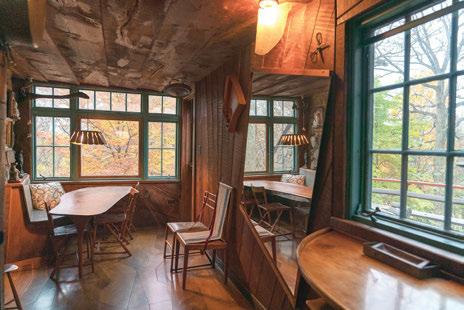


broader business of the art world but in relative seclusion.”
“The Crafted World” is divided into vignettes, using strategic juxtapositions of artworks, objects, historic photography and other pieces from WEM’s collection to not only explore the power of his vision but define Esherick’s interdisciplinary, integrated approach to living and artmaking as relevant to this moment in history. Esherick’s home is fundamentally a rural experiment, built by laborers who worked closely with local materials within a landscape of fields, forests and the occasional farmhouse. The vignette titled “Rural and Urban” explores this alongside his ties to urban living and connections with avant-garde artists, cosmopolitan clients and urban artistic movements. His “Flat Top Desk Suite” is one such piece, featuring angular geometric forms that aligned with German Expressionism.
A woodblock print, made in 1923, three years before his studio was built, is titled “Diamond Rock Hill” and shows a view of Esherick’s family home as seen from the planned site of his studio. Nature is a dominant element in the composition and reinforces his insistence of maintaining the rural landscape around his property.
The bridge between Esherick’s two-dimensional and three-dimensional works is explored in the vignette, “Pattern Recognition,” a somewhat surprising title given the unexpected arcs and bends of his oeuvre. Carving frames for his paintings was his first

foray into woodworking and he sought to create patterns that enhanced the images housed within them. This would develop into making furniture, sculpture and other threedimensional forms.
“Moonlight on Alabama Pines” is an early tour de force, ethereally depicting a grove of trees in a frame that has pine needles as its predominant motif. He retains this abstraction even as he moves into three dimensions, notably in “The Race,” a dynamic and col-

orful version of a child’s game. By the 1930s, Esherick stopped rendering the human form in a literal way. “Bodies in Space” is another vignette that examines this phase of his artistic development, when he became more interested in how people relate physically to things they use, as well as how furniture is designed. A light pull, rendered in the form of a suspended figure pulling down on a light cord, captures this essence succinctly.
The final vignette, “The Way Things Grow,” represents Esherick’s broader output and ties directly to his career-long interest in the way things grow in the natural world. A music stand, designed for one of his most important patrons and passionate amateur cellist, Rose Rubinson, captures and amplifies the movements she would have made while playing her instrument. The sinuous twists and gentle curves of his “Library Ladder” exemplify this magnificently, seamlessly blending form and function. He made a narrow but impactful leap to his spiral staircases, which the catalog describes as “perhaps the most iconic architectural feature” of his studio; the model for the Hedgerow Theatre Lobby Stair is one of many versions he made.
The BMA’s Burdan, reiterating that “it became clear that there were a number of artists seeking to leave the city behind and ensconce themselves in creative hideaways close enough to remain in contact with the broader business of the art world but in relative seclusion. So much attention has been paid to the role of the city and urban spaces in the development of Twentieth Century American art, but this exhibition reminds viewers of another path that other artists often took.”
“The Crafted World of Wharton Esherick” will be on view at the Brandywine Museum of Art from October 13 through January 19.
The Brandywine Conservancy and Museum of Art are at One Hoffmans Mill Road. For information, 610-388-2700 or www.brandywine.org. The Wharton Esherick Museum is at 1520 Horse Shoe Trail in Malvern, Penn. For more information, 610-644-5822 or www. whartonesherickmuseum.org.
“Music Stand” by Wharton Esherick, 1960, walnut and cherry, 44½ by 20 by 20 inches. Wharton Esherick Museum Collection. Eoin O’Neill photo, courtesy of the




WASHINGTON, DC, — The National Park Service (NPS) has announced $12.125 million in Paul Bruhn Historic Revitalization Grants to 17 subgrant programs in 15 states to support economic development through the preservation of historic buildings in rural communities across the country.
“The National Park Service helps rural areas across the country revitalize their communities through historic preservation,” said National Park Service director Chuck Sams. “This locally stewarded work supports improvements to historic buildings, preserving America’s cultural resources while benefiting local economies.”
The grants will allow state and local governments and nonprofit organizations to develop subgrant programs and select individual projects in their rural communities for physical preservation projects that will contribute to economic development.
In Arkansas, the city of Hot Springs will receive $750,000 to address the city’s housing shortage, the most serious economic issue facing this community. The industrial and tourism sectors will languish when workers cannot find adequate housing. One of the most likely sources of subgrant applications is the largest historic district in Arkansas, composed of resources built by and for Black Arkansans.
The Coastal Regional Commission of Georgia will also receive $750,000 for exterior improvements to properties listed or eligible for listing to the National Register of Historic Places in McIntosh County, Georgia.
In Illinois, the Kane County Historic Revitalization Subgrant Program will provide subgrants totaling $750,000 to property owners in rural agricultural communities west of Chicago. Subgrant recipients will be not-for-profit organizations, museums, the Forest Preserve District, or local for-profit businesses such as local food outlets, recreational and educational programs and individuals with high-profile agricultural buildings in the historic district.
Amana Colonies Land Use District in Iowa will use its $748,375 grant to repair and restore significant historic properties within the Amana Colonies National Historic
Landmark area, with an end toward economic development. Also, in Iowa, National Register-listed properties owned by local governments or nonprofit organizations will receive funds from the Iowa Economic Development Authority.
The rehabilitation of the physical character of Frankfort’s (Ky.) oldest neighborhoods will be supported by grants to the City of Frankford while in Paducah, subgrants totaling $750,000 will be awarded to public and private building owners to help stabilize and restore buildings on the National Register of Historic Places.
The Main Street Homer Historic Building Revitalization Program will provide subgrants to develop move-in ready spaces for businesses in the City’s downtown Historic District, in Homer, La.
Revitalize ME Downtown will offer subgrants to historic property owners in one of the 23 rural municipalities classified as a current National Main Street or Maine Downtown Affiliate community.
Endangered and underutilized historic commercial properties within canal towns and communities along the three historic canals of Maryland, most notably along the Chesapeake and Ohio canals, will be supported by grants to the Society for the Preservation of Maryland Antiquities.
National Register-listed properties in a seven county region of West-Central Missouri will receive funds through the Kaysinger Basin Regional Planning Commission.
The City and County of Butte-Silver Bow, Mont., will provide subgrants to economically stagnant properties within the Butte National Historic Landmark District, requiring a financial boost of outside funds to make them viable and serviceable to the Butte community.
Partners for Sacred Places and Pennsylvania’s Faithful Fund will award subgrants for the rehabilitation of historic religious properties in rural Pennsylvania.
The Utah State Historic Preservation Office and Reactivating Utah’s Rural Main Streets program will benefit National Register-listed properties located in the state’s designated Main Street communities. Funds will target


Historic properties in small towns in Maryland, like these in Brunswick, will be eligible to receive subgrants from Preservation Maryland. Photo courtesy of Preservation Maryland.
the conversion of upper floors into much needed housing and the creation of publicly accessible ground level spaces to support new businesses.
The Vermont Historic Villages and Downtown Revitalization Subgrant Program will provide subgrants to support preservation activities on properties listed in the National Register of Historic Places in Vermont communities with a population of 7,500 or less.
The Virginia Department of Historic Resources will provide subgrants to public and nonprofit-owned buildings in 25 rural counties in the Appalachian region of the state.
In Washington, DC, the Strengthening Historic Washington Against Sea Level Rise program will provide subgrants to help National Register-listed properties across coastal Washington State withstand sea level rise and flood events. The subgranting program will serve rural coastal communities, such as Aberdeen, Port Townsend, Coupeville and Anacortes.
Congress has appropriated $10 million for FY24 funding with applications planned to be available in the fall of 2024. For more information about the Paul Bruhn Historic Revitalization Grants Program, www.nps.gov/ revitalization.
NANTUCKET, MASS. — The Nantucket Preservation Trust (NPT) has announced the winners of the trust’s annual Preservation Awards, which recognize individuals or organizations that advance the cause of historic preservation on the island. In general, the NPT Preservation Awards emphasize proper preservation, showcase the island’s craftspeople and reveal the foresight of owners who care about our historic structures and landscape. The program is designed to show that a building or landscape can be sensitively updated while maintaining and preserving its historic integrity.
Leslie Mayer received the Michelle Elzay Architectural Preservation Award for The Maples at 14 Broadway, in Siasconset. Since taking ownership of The Maples at 14 Broadway in 2011, Mayer has cherished the more than 200-year history of her home situated between Broadway and Center Street in ‘Sconset. The roses that adorn her historic home have appeared in numerous publications and are a favorite of visitors and residents alike. Under Mayer’s stewardship, The Maples underwent a

meticulous five-year restoration project that was completed in 2024. There were no changes to the historic building’s footprint, exterior roofs and walls, or its interior plan of rooms. Mayer ensured The Maples’ Eighteenth-Century plaster walls and ceilings, hand-planed wood floors, hardware and windows were all retained and restored.
The John A and Catherine Lodge Stewardship Award was awarded to Frances Karttunen, at 67 North Centre Street, who has made immeasurable contributions to the study of history on Nantucket.
After a celebrated career as a linguist and professor at the University of Texas at Austin, Karttunen returned home to Nantucket in retirement with her late husband, the historian Alfred W. Crosby. A 12th generation Nantucketer, much of her work on the island has been dedicated to uncovering the history of Nantucket’s immigrant communities. Her 2005 book, The Other Islanders: People Who Pulled Nantucket’s Oars, is the culmination of this important research.
Karttunen has been the steward of her family’s home on 67 North Centre Street since 1994. For many years it was known as the Sylvaro Homestead. In 1867, Enos Sylvaro purchased the circa 1730 dwelling from Aaron Swain. Enos and his wife Ellen raised six children there. Ferdinand, Emerson and Lizzie Sylvaro inherited the house, and Lizzie, following the death of her husband Edgar Ramsdell, raised her daughter Ellen at 67 North Centre Street.
In addition to her stewardship of 67 North Centre, Karttunen has published scholarship on Nantucket history, been a longtime member of the Nantucket Cemetery Commission and has been a longtime contributor to programming at the African Meeting House, the Saltmarsh Center and Our Island Home.
Michele Kolb has been awarded the Historical Renovation Award for her work on the property at 27 North Liberty Street.
In August 2023, architect Kolb purchased the Seth Ray cooperage (circa 1798), a contributing structure abutting
the Lily Pond. The property at 27 North Liberty Street was in need of repair and restoration. Prior Nantucket Historic District Commission approval for the site would have allowed a second-floor addition, rear and side additions, removal of all the historic windows and the demolition of all historic interiors.
Under Kolb’s ownership, new plans for a historical renovation were filed with the Historic District Commission with the goal of retaining as much of the existing historic fabric as possible. Late Nineteenth Century windows were retained and restored, as was the original post and beam structure. Two small additions were added, a rear bathroom over what had been an existing shed and a singlestory side addition for a bathroom and laundry.
The work was completed in just nine months under Kolb’s leadership. This past summer renters enjoyed experiencing historic Nantucket without sparing modern conveniences.
The Nantucket Garden Club was the recipient of the Caroline A Ellis Landscape & Garden Award for the Saltmarsh Senior Center Garden at 81 Washington Street. The Saltmarsh Senior Center is a hub of community life for many Nantucket seniors. In recent years, its garden had become overgrown and choked with invasive plants. Starting in early 2022, members of the Nantucket Garden Club led by Paulette Boling undertook the creation of a coastal resilient native plant garden to transform the 1,200 square foot space. The project was not for the faint of heart: its coastal location adjacent to Nantucket Harbor is flooded with seawater multiple times per year, hard to remove invasives were well established and many rabbits liked to snack on new plantings. An interpretive sign at the site shares with the public how once established, these native species do not require pesticides, watering, or fertilizers and support wildlife and pollinators.
Finally, blacksmith Aaron Beck, won the Traditional Building Methods Award
For additional information on the Nantucket Preservation Trust, www.nantucketpreservation.org.












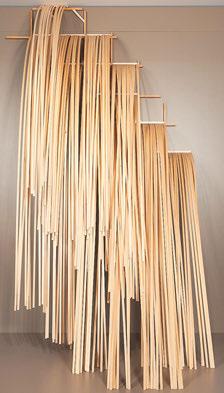
“Waterfall VIII” by Truman T. Lowe (Ho-Chunk), 2011, wood and metal fasteners, 82 by 80 by 64 inches. Denver Art Museum, Native Arts acquisition fund, 2011.430A-N. ©Truman T. Lowe.
OLD LYME, CONN. — From November 16 through February 9, the Florence Griswold Museum (FloGris) in Old Lyme, Conn., hosts two exhibitions that acknowledge the perspective and artistic achievements of the Indigenous community. “Native Prospects: Indigeneity and Landscape” juxtaposes Nineteenth Century paintings by Thomas Cole featuring Native figures in context with Indigenous works of historic and cultural value, and artworks by contemporary Indigenous artists: Teresa Baker (Mandan/Hidatsa), Brandon Lazore (Onondaga, Snipe Clan), Truman T. Lowe (Ho-Chunk), Alan Michelson (Mohawk member of the Six Nations of the Grand River) and Kay WalkingStick (Cherokee). Bringing the Nineteenth Century into conversation with our present moment the exhibition offers profound interpretations of American art and land, expands conventional definitions of “land” and “landscape” and highlights Indigenous artistic creation. “Our museum is proud to make space for this unprecedented and much needed reconsideration of Nineteenth Century paintings through the lens of Indigenous

people,” notes executive director of the FloGris Joshua Campbell Torrance. “By pairing these depictions of the land with works by historic and contemporary Indigenous artists, this exhibition expands the audience’s concept of landscape and their awareness of Indigenous perspectives.”
“Native Prospects” was organized by the Thomas Cole National Historic Site and curated by Scott Manning Stevens, PhD / Karoniaktatsie (Akwesasne Mohawk), associate professor of Native American Studies and English at Syracuse University, where he is also director of the Native American and Indigenous Studies Program and founding director of the Center for Global Indigenous Cultures and Environmental Justice.
In conjunction with “Native Prospects,” people from Connecticut’s five recognized tribes collaborated with the Museum to curate “Naqutiwowok/Continuance: Connecticut’s Tribal Communities Create,” an exhibition with the perspectives and voices of Connecticut’s Indigenous people. The collaboration was led by people from the tribes, who curated the exhibition from
work submitted by members to a jury composed of representatives from those same groups.
Planners sought contributions that express thoughts about indigeneity and landscape from the viewpoint of this region’s people. The exhibition takes place during the fall and winter seasons, times of year that carry specific cultural and spiritual resonances. The organizers encouraged prospective participants to consider and reflect in their submissions concepts such as gathering, resiliency, connecting, relating, walking (land), paddling (water), repairing, continuation, sustaining, warming and changing.
“Naqutiwowok/Continuance” contains work representing an array of media as well as contributions from adults and youth, in keeping with the theme of continuity through time. These exhibitions will be accompanied by public programs exploring storytelling, food, language and the environment, among other topics.
The Florence Griswold Museum is at 96 Lyme Street. For information, 860-4345542 or www.florencegriswoldmuseum.org.
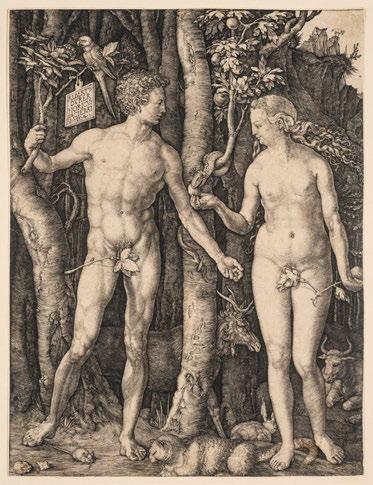


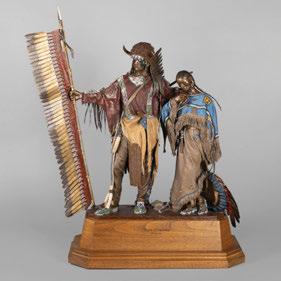
Save the Date, November 8 – 9 UPCOMING CALENDAR
November
December 2024
February 2025
March 2025
May






“Morning at Narragansett – The Turn of the Tide” by Alfred Thompson Bricher (American, 1837-1908), 1871, oil on canvas, signed and dated, 20½ by 41 inches, estimate $150/200,000.
— On Thursday, October 24, at 6 pm, Shannon’s Fine Art Auctioneers will present their annual fall Fine Art Auction. The sale will take place live online at shannons.com and bidding will be available by telephone, absentee and through their website.
Shannon’s has become the leading auction house for American Art and this season proves their strength in attracting quality consignments in this genre. The firm secured 15 paintings from a major private collection of American Art. Many of the paintings from this group are fresh-tothe-market, having been in private hands for decades. The top lot from this collection is an exceptional Alfred Thompson Bricher, “Morning at Narragansett – The Turn of the Tide,” dated 1871, estimated at $150/200,000. This masterful Luminist painting depicts a mother with her two children enjoying a day at the beach, young boys playing in the gentle waves and a couple walking in the sand. Shannon’s has sold more than 100 paintings by A.T. Bricher and the owner, Sandra Germain, noted this is “easily among the best work by Bricher I have ever seen.”
Nineteenth Century American paintings are a strength of this collection. In addition
to the Bricher, Shannon’s will offer Thomas W. Whittredge’s “View of Newport Beach” at $50/75,000; Jasper Francis Cropsey’s “Greenwood Lake,” at $50/75,000; and still-life paintings by Levi Wells Prentice and John F. Francis.
American Impressionism is led by Ernest Lawson’s “Boat House, Winter, Harlem River,” from 1918, estimated at $100/150,000. It was previously in the collection of the Saint Louis Art Museum and in private hands since 2010. Other fine examples of American Impressionism include paintings of New York City by Colin Campbell Cooper and Edmund Greacen.
Arthur Wesley Dow’s superb “Verge of the Abyss,” depicts a rare view of the Grand Canyon painted in 1911-12. Estimated at $80,000-$120,000, this work will undoubtedly attract interest from private collectors and museums alike. The collection includes other Twentieth Century paintings by Dale Nichols and John Atherton.
From an Important Midwestern Collection of American Impressionism, Shannon’s will offer Frederick Carl Frieseke’s “The Rose Gown” from 1915 and estimated at $80,000–$120,000. This impressive 32-by-32-inch painting depicts a woman

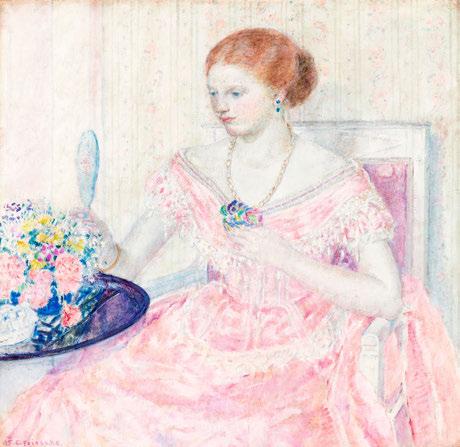
“The Rose Gown” by Frederick Carl Frieseke (American, 1874-1939), 1915, oil on canvas, signed, 32 by 32 inches, estimate $80,000-$120,000.
in a rose-colored dress holding a posy. Shannon’s has attracted a following for Frieseke with recent sales of “Lady Trying on a Hat” for $450,000 (2023) and “Dressing” for $112,500 (2024).
A local view of Woodbury, Conn., titled “The Road that Leads to Home,” by Willard Leroy Metcalf, will be offered at an attractive estimate of $80,000-$120,000. Edward Henry Potthast’s delightful “Children at Play on the Beach” will be offered at $60/80,000. This Midwestern collection features another Ernest Lawson titled “Winter Scene” which descended in the family of the artist and is estimated at $20/30,000.
A collection of five paintings by Emily Mason will headline the Modernist offerings in this auction. Mason painted in New York City and taught at Hunter College for over 30 years. Shannon’s will offer “Three
Musicians,” a 50-by-40-inch oil painting from 1988, at $40/60,000 and “Abstract Orange,” a 40-by-35-inch oil painting from 1981 to 1982, at $30/50,000 alongside three works on paper.
An in-person preview of all the works featured in the auction will be on display weekdays from October 14-23 and on Saturday, October 19. Shannon’s is one of the few auction houses still producing richly illustrated color catalogs to promote their offerings. The eagerly anticipated catalog will be available in early October. Contact the auction house or sign up for the mailing list online.
The fall auction at Shannon’s will feature roughly 200 paintings, drawings, prints and sculpture. To join the mailing list and for updates on the October 24 Fine Art Auction visit www.shannons.com or follow them on social media.



April 11 th & 12 th , 2025 Now accepting important consignments 2024 A uctions reAlized $18 million , with 97% of All lots sold s etting 35 new Auction records , now holding 276.


LONG ISLAND CITY, N.Y. — After five decades spent providing art services from our primary location in New York City, RoGallery is thrilled to announce the opening of our newest space, the RoGallery Annex. Located right around the corner from our foundational gallery showroom in Long Island City, N.Y., this luminous extension of the gallery brings our more than 30,000-piece inventory into new territory. The Annex holds the potential for new opportunities, not just for RoGallery, but for artists and the creative communities we represent.
The Annex is intended to be a multi-use art space. Alongside our own exhibitions, RoGallery is opening the doors to outsider exhibitions, solo and group shows, performance art, site-specific installations and other arts events. RoGallery hopes that this new space will provide a much-needed infusion of fine art into the heart of Long Island City. While the areas nearest the waterfront are beginning to develop into an impressive array of shopping and dining districts, the areas further inland are still neglected by most developers. Located on the Eastern edge of Long Island City, RoGallery and RoGallery Annex are helping to reshape the neighborhood for the future.
The newly renovated Annex boasts 2,500 square feet of spacious galleries. Several of the rooms feature diffused, indirect natural lighting and each space is equipped with fully customizable track lights. The central gallery is an open space capable of displaying several large canvases on each wall, with plenty of room in the center for free-standing objects or performances. The side galleries feature more intimate spacing, each still with ample room for several works on the walls and floors. One of the more interesting galleries at the Annex is the vault room, freshly renovated and still boasting its original armored door. This room in particular provides a unique exhibition space for artists looking to install or perform in an atypical setting outside of the traditional white cube constraints.
RoGallery Annex will be open by appointment only at 37-02 48th Avenue. The main gallery and showroom are open by appointment only just down the road at 47-15 36th Street. Contact us by email at, art@rogallery. com or by phone at 718-937-0901 to arrange your visit. The entire collection can be viewed 24/7 at www. rogallery.com.
RoGallery Art Management Services
With the opening of this new space, we also announce an extension into a variety of additional art services available to our clients. RoGallery is already well known for our many fantastic services. Our gallery provides bespoke in-house framing, global shipping options, white-glove packaging and installations and personal curating, to name a fe w. Now with the RoGallery Arts Management Services, clients can expect a whole suite of ser vices to suit their every need.
Listings, Consignments and Direct Purchases

Are you looking to sell a piece or an entire collection? Sell it with us! We offer a variety of options depending on the piece. Listing is by far the easiest option, letting anyone with any piece (yes, that means artists too!) have their work up on our website, our partner sites and in our auctions for a small fee. Clients can submit their works to us and can usually expect to see them for sale online within a week. Consignments are also available, which allow collectors with more select pieces to not only list the pieces on our various platforms but also store the works at our warehouse location.

Another option available is a direct sale. We are currently seeking entire estates and collections to purchase outright. Clients with good collections are encouraged to contact us and arrange an assessment of their pieces. If purchased, these collections will immediately become part of the RoGallery inventory. This allows clients with larger collections to transfer the pieces to our care without the worry of when they will sell.
Estates and Trusts
We know that over the years, a collection can swell to an overwhelming size. Artists create hundreds of works and collectors amass a beloved array of pieces. The management of those estates and trusts can eventually become too much to handle, and that’s where RoGallery is happy to assist. As part of our Arts Management services, we offer the opportunity to manage and sell the estates through our channels and auctions. This service already offers a welcome reprieve to both living artists and collectors as well as the heirs and managers of posthumous estates. Let RoGallery take the weight off your shoulders by taking responsibility for the care and future of these artworks.
As an extension of our estates and trusts management, we offer single-collector auctions. These custom sales, created and run live by our auction team, are specifically designed to highlight spectacular works from a single collection. Collectors looking to raise the overall quality of their collections will often buy a large number of pieces from these esteemed estate auctions in an effort to bring the legacy of legendary collectors into their own homes.

Director Robert Rogal is certified by the International Fine Art Appraisers to provide appraisals on your ar twork. We can provide free verbal evaluation if you are simply looking to get an idea of value. If you need written documentation for insurance or legal purposes, we can make a written appraisal for a fee.
RoGallery offers long and shortterm leases of the artworks in our inventory for film, TV, staging and more. Find the perfect painting or the ideal sculpture to add the final touch to your project.
Art Collateral Loans
Extract value from your collection with an art-backed loan from RoGallery! With our loan program, collectors are invited to have the value of their work fully assessed before leaving it in our expert care. RoGallery provides custom financing and ensures a confidential process
all involved.

Live Auction
November 2





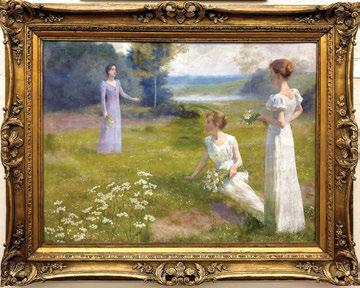
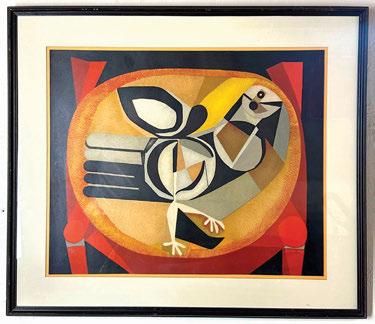

57 PARK STREET, LEE, MA
Open 7 Days A Week ~ 10am-5pm
Follow us on Instagram @ knollwoodantiques


Open


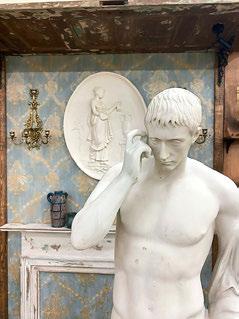


By Richard A. La Vigne
LEE, MASS. — The talented vendors at Galleries at Knollwood Antiques have each, in their own way, contributed images that represent just one aspect of their varied collections.
Mr and Mrs Owen Shugard have included “L’Oiseau,” by artist Josep Maria Garcia-Llort (1921-2003 ) a colored lithograph, numbered “64/250” and signed lower right. It measures 30 by 35 inches. This abstract Expressionist worked and exhibited his works in Paris, Barcelona and even in Louisiana. One retrospective was at the Centre’ d’études Datalanes in Paris with a book by Alex Mitani.
Mr Jeff Cote discovered a charming oil on canvas while “on a house call” in Connecticut. The solid wooden lemon gold framework surrounds an unsigned Nineteenth Century portrait of a young woman with a book. Her silk dress is beautifully rendered and she sits before a swagged drapery panel with over-scaled tassel. It measures 34¼ by 41 inches.
Mr William Union and Ms Mary Cormier of Art and Antiques have contributed one painting from their vast warehouse stock. Set within its period gilt frame, this oil on canvas created by Leopold Franz Kowalsky (1856-1931) depicts three young ladies gathering blossoms in a summer field with their luminous



dresses stark against pastel fields and woodlands.
Mr Errol Farr of Old Kinderhook Auctions takes a different route by displaying a spectacular pair of Continental doors repurposed as wall art and formerly part of a splendid armoire! The rosewood has great depth while the hand carved ebony dolphins with inlaid bone eyes and botanical representations showcase the talented carving skills of its creator.
Ms Robin Miller is renowned for her stylish good taste but also for her ability to locate varied examples of Grand Tour souvenirs, which history buffs recognize the world over! Created by hand in a myriad of Classical Revival styles and specimen stones, each piece represents hours of toil resulting in the landed gentry creating collections that now span hundreds of years.
Interior designer and antiquarian, Mr James Coviello offers an intimate portrait of his signature style represented, with a snapshot of his country residence library showcasing his research books, objects and the Victorian wrought iron stand supporting the glass dome protecting a water fowl. His cherished country abode is surrounded by gardens of his own design and planting with interiors befitting a gentleman whose collection of Hudson River School paintings adorn the walls.


Ms Joy Hanes of Hanes and Ruskin is just one of our venerated legacy vendors whose depth of knowledge is eclipsed only by her steadfast research. To this end, her discovery of the extremely rare and desirable Royal Court silhouette depicting a Classical funerary scene is but one example! Eighteenth Century, with the arms of Frederick William III, this piece was made by the court silhouette artist, Georg Heinrich Bournmester. It measures 26 by 34¼ inches.
Peter D. Murphy’s Scandinavian oil on canvas defies research as it is signed simply “Johansen.” Bold palette knife work allows us to view a mountainous area with rendered cliffs, conifer groves and luminous clouds floating above the Northern scene set within an appropriate custom frame that measures 40 by 37 inches.
Mr Erik Long, our resident graphic ink

and installation artist and e-commerce designer has included a pigma micron illustration that challenges the viewer to interpret his work in their own way. In June 2025, Erik will launch a one-man gallery wide exhibition featuring multidimensional works to include mobiles and standing sculptures, all at The Galleries at Knollwood Antiques!
Mr A. Michael Krieger is an internationally recognized interior designer who has embraced Classicism for much of his career. His Seventeenth Century figure of St Michael is an example of carving a three-dimensional object in which the carver’s adept hand is observed from every angle; today, traces of gilding remain overall. Stunning!
Mr Jeffrey Cobb of The Captains Quarters showcases a work by William Lester Stephens (1888-1969). “Sugar House, Conway, Mass.,” is an oil on Masonite


work by the artist who received 100 national and international honors and awards beginning with his scholarship award at the age of 18. Dimensions are 37¾ by 43½ inches.
Mr Christopher Cawley has a keen eye for history and design and knew this extremely rare English George II armchair
was a purchase to be coveted by many!
The stylish frame — by a master carver — exudes the type of stage presence sought by aristocratic men and women of the times as they sought to achieve certain social standing within their communities and abroad.
Richard A. La Vigne’s approach to The Galleries at Knollwood Antiques, is unique in that he transforms vendor and public spaces within the confines of the 57 Park Street location to include as many vendors as possible with each Gallery move. Constant collaboration among vendors and the exchange of ideas as well as resources keep The Galleries at Knollwood Antiques always current but looking well into the future.
The Galleries at Knollwood Antiques is at 57 Park Street, in Lee, Mass. For information, @antiquesknollwood or 917-751-0820.
The Berkshire area is known for many things: the scenic wonders it offers, quaint yet cosmopolitan villages and towns, an affable populace who are not afraid to get involved in any number of civic chores and projects, and the oftentimes high cost of real estate.
Enter “The Knollwood’s.” Richard A. La Vigné and Stephen P. Concannon were both hugely unfamiliar with the local market but in a “must find” mode to secure a new residence after accepting a business opportunity.
Hearing Richards outright plea for the name of a reliable local realtor, while speaking with a client, Susan Laidlaw of Berkshire Properties in Great Barrington, Mass., extended her hand in friendship and we began the process of house hunting!
We viewed so many homes and types of homes we could have created our own podcast! Colonials, Capes, Midcentury and even condominiums were considered. Frightening conditions for equally frightening sums of money!
Our solution came on a Friday when friends, as well as Susan, called and called regarding a new overnight listing in Lee. Susan was on top of things, as always, and a viewing was set for the same day.
Arriving at the property, one was taken aback by the similarities between Miss Haversham’s country pile and Edie Beal’s Grey Gardens! Politely put, benign neglect over a period of approximately 10 years resulted in nature reclaiming what were once promising views, well planned parterres and hedges and formal planting beds.
The interior of the “Executive Raised Ranch,” as it was described, fared only

slightly better, but viewing the sunken great room with direct lake views and its entire-wall fireplace at the end of the staggered reception area made it irresistible!! The 1990s addition of “The Palladian Room,” with its lake oriented Palladian window with large cedar terrace sealed the deal.
The edifice is nestled in a bucolic threequarter acre, zen-like site at the end of a quiet cul-de-sac. Prior pruning created an arbor of maple trees through which one overlooks Laurel Lake in a setting that brings to mind a Nineteenth Century or Edwardian view of a lakeside village.
Constructed by a prominent businessman for his family in 1967, it is the antithesis of what we wanted; yet, here we are, two years in and renovations continue.
We “dove in” with eyes wide open for this was residence number 14 over 44 years, and we accepted the fact that inspections are never able to determine the extent of hidden issues — read on... Where to begin? Our dear friend and contractor, Thomas Riddle of Kinderhook, N.Y., was enlisted to work alongside Richard in drafting detailed plans and schedules of events.
Our electrician, Thomas Ribero of Pittsfield, Mass., was on board as well, sitting through many meetings and accepting the challenges that lay ahead.
A top priority was that the home office be completed prior to move in. Stephen need to have an efficient and modern layout that also enabled us to display
( continued on page 12 )



( continued from page 11 )
many of the Grand Tour Piranesi engravings and other Classical Revival wall pieces collected over the past decades. Technology was worrisome, and we soon learned that not every wish or demand could be fulfilled without major expenditures and so it went (and goes…).
A plethora of debacles occurred simultaneously, including all three bathrooms backing up with water and pouring through ceilings (loan department anyone? Oh, and did I mention the bears?).
The primary suite was tackled next, and we discovered that no matter where a bed was placed there was not enough room for night stands or even a chair. A cleated wall unit was devised and framed out in two of the suites that would eliminate — visually not structurally — a window, resulting in the perfect relaxing environment at the end of a busy day.
The public, or entertaining spaces, had their own issues, with the former owners having skimped on quality products which required replacements everywhere.
What happened with that Great Room?
From Richards detailed drawings, a Tudor-inspired ceiling was to be installed,
but alas, the ceiling was not level! This resulted in the purchase of a laser device that allowed the installation of three large beams, which were stained and finished out of doors, then relocated into the interior by three men through a window and onto scaffolding. In between the beams, bead and board now covers the former plaster while bespoke moldings were added to inject a period mood.
The entire east wall of the Great Room consists of a wainscot of river rocks below an antique barn beam.
The fireplace was considered “safe” until a second independent inspection revealed the damage and spalling bricks inside the chimney. A custom gas insert and surround was manufactured resulting in everyone’s favorite space. This only took six months! Oh, and did I mention the bears?
Nineteenth Century French library chairs in Scalamandré textiles, a gloriously hand-painted and gilt chinoiserie double pedestal desk and a hand-carved and gilt French canape wearing Rose Cummings silk velvet faux ocelot (once situated in the Presidential Suite of The Ambassador Hotel ) hold court alongside a pair of Eighteenth Century gilt carved wooden

balustrades repurposed in the 1920s with added eglômisé panel tops and stepped bases. A modern steel coffee table with inset stained glass top, contemporary marble baluster-form side table and more Impressionist art round out the space. The room sized Ukrainian carpet anchors the room and the silk taffeta drapery panels, as well as the Robert Allen upholstered suite of four Spanish drawing room chairs, emphasize the importance of combining color and texture to great effect.
Throughout the dwelling, the utilization of color is impactful and showcases the Eighteenth and Nineteenth Century furnishings and decorative accessories purchased worldwide. In particular, the walls of the Great Room — in Benjamin Moore “Historic Brown” — contrast with the vestibule and common hallways scheme of Benjamin Moore’s “Glamorous.” Benjamin Moore’s “Deep Blue” transformed the primary suite where blue and white Chinese porcelain works to advantage alongside French and English antiques and Impressionist art.
Repurposed Nineteenth Century French armoire doors are effective architectural elements as seen left and right of pocket doors in the dining room, the doors

having been discovered after the home was purchased. The continuation of the brown walls in matte finish allows for life-sized Venetian Moorish figures, whose gilt and enameled surfaces shimmer in the illumination from an Eighteenth Century circular tôle hanging fixture, to stand out on roundel form plinths.
The dining table was one of those finds in a Florida showroom where “as found” floor models could be purchased. An autobody shop was contacted and they ebonized the table top, thus concealing gouges and scratches. The circular top now “floats” above a canted fluted column atop a stepped base.
Eight sang de beouf colored leather upholstered Chippendale style side chairs surround the table, which can be found opposite sliding glass doors overlooking wild flower filled woodlands.
The project was placed on reserve when we discovered the space now occupied by our “Best of Berkshires”-designated Galleries at Knollwood Antiques, where construction and improvements continue throughout the autumn season and beyond! Stay tuned for more updates and follow us on Instagram for images of items as they arrive at our new venue!!



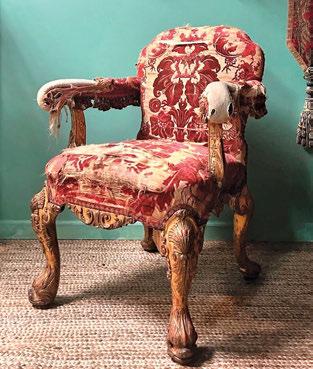

57 PARK STREET, LEE, MA
Open 7 Days A Week ~ 10am-5pm
Follow us on Instagram @ knollwoodantiques

Tiffany & Co., gold, citrine, amethyst and diamond ‘Fireworks’ brooch ($10/15,000).

Gold and diamond brooch ($60/90,000).
BOSTON — Grogan & Company, Fine Art and Jewelry Auctioneers, has announced their highly anticipated Fall Fine Jewelry Auction, scheduled to take place this year on Sunday, November 3, at 11 am. The auction highlights the firm’s niche for offering fresh-tomarket, high-quality period jewelry from estates and collections and comes on the heels of the roaring success of their Spring Fine Jewelry Auction.
The Spring Fine Jewelry Auction was led by an Edwardian diamond and 4.22-carat Kashmir sapphire brooch, which sold for $437,500, more than double its high estimate.
Prior to being offered at Grogan & Company, the brooch had descended through a Massachusetts family for three generations. From a different Massachusetts family came an Edwardian diamond, Colombian emerald and natural pearl sautoir (estimated $10/15,000, sold $42,750) and an Edwardian diamond and Burmese ruby ring (estimated $15/25,000, sold $41,250). Other highlights from the sale included a selection of makers including Van Cleef & Arpels, Cartier and Tiffany & Co.
The Fall Fine Jewelry Auction features a similarly impressive selection of diamonds, colored stones and signed, period pieces. A striking Art Deco Tiffany & Co., emerald and diamond brooch comes to market in its original box, having descended through a Massachusetts family since its purchase ($20/40,000). From a different consignor, and also in its original period bo x, comes a beautiful Tiffany & Co., natural pearl and diamond necklace. The 89 light cream-pink natural pearls are completed by a marquise-cut diamond clasp ($8/12,000). The sale features more contemporary Tiffany jewelry as well, including a celebratory diamond and gem-set “Fireworks” br ooch ($10/15,000), a Schlumberger diamond and ruby “Two Bees” ring

Tiffany & Co., platinum, emerald and diamond brooch ($20/40,000).
($10/20,000) and a Schlumberger gold and diamond “Ibex” brooch ($3/5,000). “This sale highlights the creative vision of Tiffany & Co., throughout the Twentieth Century. From a delicate Edwardian diamond wristwatch to a chunky Paloma Picasso hardstone necklace, this sale is a mustsee for Tiffany & Co., collectors,” notes gallery director Claudia Deeley. With the sale of numerous important Kashmir sapphires and Burmese r ubies over the past decade, Grogan & Company’s jewelry department has a proven track record of assisting families in identifying and selling their valuable period heirlooms.
This auction is no exception, as Deeley explains. “In two separate instances this summer, families invited me to view a collection of jewelry that had been passed down for generations. In one home, between many pieces of costume jewelry, I spotted the glowing blue of what I suspected to be a Kashmir sapphire, nestled between two beautiful diamonds in a period engagement ring. We sent the ring to be

Platinum, Kashmir sapphire and diamond ring ($15/20,000).
tested at the AGL, and, sure enough, the sapphire was determined to be of Kashmir origin, with no indication of treatment.” This 1.10-carat Kashmir sapphire ring is estimated at $15/20,000. From another family comes two Edwardian ruby and diamond engagement rings. Both rubies w eigh approximately 1 carat and were determined to be of Burmese origin, with no indication of treatment. Each ring is estimated at $4/8,000.
The auction features several notable diamonds, led by an abstract dragon -
fly-form brooch featuring a 5.75-carat old-mine cut diamond surrounded by nearly 6.50-carats of old mine and round brilliant cut diamonds set in platinum and gold wings. Deeley notes, “at some point in the mid Twentieth Century, the consignor’s mother decided to refashion several inherited family pieces into this one-of-a-kind brooch.” The brooch is estimated at $60/90,000. Other diamond highlights include a J.E. Caldwell 4.02-carat diamond ring ($40/60,000) and an 8.26-carat pear-shaped diamond ring estimated at $50/80,000. The sale highlights are completed by a selection of Mid Century brooches, including a gold, diamond and gem-set flower brooch by Chaumet, which was featured in a recent book on the maker ($15/25,000), and two chunky diamond and gem-set flower brooches by David Webb ($10/15,000 and $20/40,000).
With 275 lots of jewelry on offer, there is something for everyone in the Fall Fine Jewelry Auction. The live auction will take place at Grogan & Company’s Boston headquarters at 11 am on Sunday, November 3, with a livestream available alongside telephone and absentee bidding. The jewelry will be on display in their Beacon Hill gallery from October 28 to November 1. A print catalog is av ailable by request, and the complete catalog is available online at groganco.com.
Additionally, on November 2, Grogan & Company will conduct their annual Fall Fine Art Auction, which this year features more than 200 lots of Nineteenth and Twentieth Century American art. Highlights include works by Walt Kuhn, George Inness, Charles Hopkinson, Paul Sample and Eric Sloane. The paintings will be on display in Grogan & Company’s Beacon Hill gallery from October 22 to November 1. For more information, to view the online catalog or request a print catalog, visit www.groganco.com.
In-person previews by appointment
October 14th - October 23rd (weekdays from 11AM-6PM)
Saturday, October 19th (10AM-3PM), Closed Sunday
Virtual previews & additional photos are available by request.
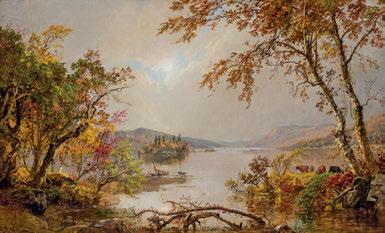


ARTHUR WESLEY DOW
Alfred Thompson Bricher, Frederick Carl Frieseke, Willard Leroy Metcalf, Edward Henry Potthast, Dale Nichols, Thomas Worthington Whittredge, Emily Mason, George Inness, John F. Francis, Richard Hayley Lever, Peder Mork Monsted, Felix Ziem, Frederic Sackrider Remington, David Johnson, Francis Augustus Silva, Wolf Kahn, Jane Peterson, Levi Wells Prentice, Colin Campbell Cooper, Sanford Robinson Gifford, Frederick Mulhaupt, Guy Carleton Wiggins, Blanche Lazzell, Birge Harrison, Francis Coates Jones, William Mason Brown, Walter Launt Palmer, Albert Bierstadt, Larry Rivers, William Harnett, Edmund Greacen, John George Brown, Pauline Lennards Palmer, Tom Yost, Henry Augustus Ferguson, John Carlton Atherton, Selden Connor Gile, William Aiken Walker, Charles Courtney Curran and more

“The Last Roundup” by Quincy Tahoma, (Diné [Navajo], 1920-1956), 1942, gouache on paper, 12¾ by 28½ inches, provenance to the Gregory Warren Nelson Collection, N.M. Estimate: $8/12,000.
SANTA FE, N.M. — The most anticipated annual event of Santa Fe Art Auction’s calendar year, the Signature Live Sale routinely attracts record hammer prices and has long been a staple of the Western Art circuit. Presented this year on November 8-9, Santa Fe Art Auction’s 30th anniversary live sale features the best of the Southwest, and the lots included exemplify the finest of the most popular categories that Santa Fe Art Auction brings to market throughout the year.
This year’s offerings will include a wide selection of both historic and contemporary pieces, ranging from Western paintings to works by the Southwest Modernists to prominent Santa Fe School artists. Wonderful examples of early Pueblo pottery and basketry will be presented, along with many vibrant Diné (Navajo) textiles, exquisite Native jewelry, Western furnishings and showpieces, as well as Edward Curtis photogravures from The North American Indian (1907-1930). Collectors can find a wide selection of works this November that speak to the enchantment of New Mexico and the diversity of this unique history and culture.
Works by many important indigenous artists of the Twentieth Century will be featured among the 300 plus lots, along with that of many contemporary artists practicing today. Look for exemplary pieces by Fritz Scholder, Alan Houser, Margarete Bagshaw, Kevin Red Star, Jaune Quick-to-See Smith, T.C. Cannon, Tony Abeyta and Tony Da. Alan Houser’s “Abstract Crown Dancer” is expected to garner significant attention this November, a marvelous bronze artist’s proof that depicts a modern form of an Apache Ga’an Crown dancer — a rare piece estimated at $30/50,000 that is considered the most technically complex of the bronzes that Houser created late in his career. Many wonderful and expressive portraits by Kevin Red Star and Fritz Scholder will be presented along with innovative and experimental abstractions by Margarete Bagshaw, Tony Abeyta and Jaune Quick-to-See Smith, highlighting the breadth and diversity of these celebrated and wideranging practices.
Santa Fe Art Auction is very privileged this year to present the Gregory Warren Nelson Collection, of Taos, N.M. A patron of the arts and outdoor enthusiast with a keen eye, Nelson developed a world-class collection of Western and Native American art throughout his lifetime, having acquired many major works that capture the bold spirit of New Mexico and the Southwest. Significant artists in Nelson’s collection that will appear at the Signature Live Sale include Gustave Baumann, Ansel Adams, Howard Norton Cook, Gene Kloss, Barbara Latham, Dorothy Eugenie Brett, Fremont Ellis, Quincy Tahoma and Awa (Alfonso Roybal) Tsireh. The auction house is delighted to feature Howard Norton Cook’s “Prismatic Night #1,” a spectacular, highly variegated, almost kaleidoscopic oil painting estimated at $30/50,000. A 1942 gouache by prominent Santa Fe School artist Quincy Tahoma, titled “The Last Roundup,” is another standout piece that is expected to fly off the block ($8/12,000). Quintessential of the Diné artist’s later works, this dynamic piece depicts two Navajo horsemen
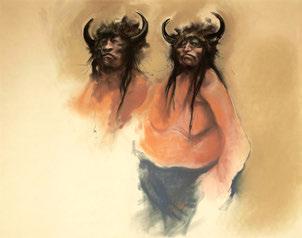
“Blackfoot Warriors” by Paul Pletka (b 1946), pastel, charcoal on paper, 31 by 39 inches. Estimate: $5/7,000.

“Abstract Crown Dancer” by Allan Capron Houser (Haouzous) (Chiricahua Apache, 1914-1994), bronze, artist’s proof, edition of 12, 42½ by 17¾ by 14 inches. Estimate: $30/50,000.

“Capitan–Kiowa Apache” by John Nieto (1936-2018), 1989, acrylic on canvas, 44 by 40 inches. Estimate: $10/15,000.
corralling a stampede of horses with brilliant colors and expressive, precise linework.
Several works from the Highland Park, Texas, and Santa Fe collection of Patsy P. and William L. Hutchison will also be presented at auction this November. Bill was president, CEO and chairman of the Board of Texas Oil and Gas, as well as the chairman of Board of Governors and trustee emeritus of Southern Methodist University (SMU). The Hutchisons were renowned and passionate collectors of Western paintings and sculpture from the 1960s onward. Collectors will find pieces by many important Western artists of the Nineteenth through Twenty-First Centuries, including painting and sculpture by Frank McCarthy, David Mann, Charles Russell, Bill Nebeke and John Moyers. Also a well-known cattle rancher in the highlands of northern New Mexico, Hutchison’s collection highlights his passion and eye for the beauty of the American Southwest.
Artworks from numerous private collections throughout the country will be featured, including paintings and sculptures by prominent artists including Gustave Baumann, Paul Pletka, John Nieto, William Schenck, Dave McGary, Scott Rogers, Donna Howell-Sickles, Malcom Furlow, David Park, Henriette Wyeth, William Penhallow Henderson, Raymond Johnson and contemporary Western star John Maggiori. Paul Pletka’s striking portrait “Blackfoot Warriors” ($5/7,000) is a wonderful classic example of the artist’s work, a poignant mixed media piece of pastel and charcoal that depicts two iterations of a Blackfoot warrior wearing a traditional split-horn headdress. Two major works by John Nieto, “Capitan–Kiowa Apache” ($10/15,000) and “Bear Medicine” ($12/18,000) are wonderful examples of the artist’s style and are also expected as standout lots this fall. As always, prints by Gustave Baumann, for whom Santa Fe Art Auction holds many world auction records, will be presented this November, including a stunning 1926 color woodcut titled “Mountain Gold” that depicts a magnificent Southwestern Landscape ($8/12,000).
A final highlight of the sale is a custom-made multistone, inlaid tooled leather saddle set. Completely unique, this spectacular saddle set, which includes a matching bridle, breast plate and spurs, was meticulously hand-inlaid in silver by Aldrich. The stone selection includes cabochons of coral, turquoise, spiny oyster, lapis lazuli and sugilite.
Santa Fe Art Auction is located at 932 Railfan Road and is always open for previews and accepting consignments. A preview and cocktail reception featuring a special appearance by Benny and Valerie Aldrich will take place on Wednesday, November 6. For more information about the 30th Anniversary Signature Live Sale, reception, and to see the upcoming calendar, please visit www.santafeartauction.com, email info@santafeartauction.com, or call 505-954-5858. For consignment inquiries, please visit our website or email consign@santafeartauction.com.



Featuring some never offered paintings and iconic prints of the period





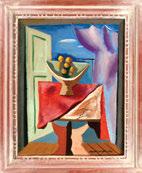














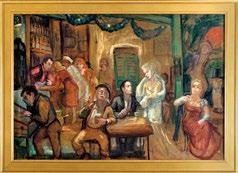






“Kachina Doll Maker” by Eanger Irving Couse (American, 1866-1936), oil on canvas, 24 by 29 inches. Sold for $245,700.

“Pack Trip (Rough Going)” by William R. Leigh (American, 1866-1955), oil on canvas, 22 by 30 inches. Sold for $225,000.
SCOTTSDALE, ARIZ. — Scottsdale Art Auction has proven to be the collector’s choice for Western art auctions year after year.
The proof is in the records.
That is how we feel at the Scottsdale Art Auction. One only needs to see what we have achieved in our 20 years of doing business to understand our importance to the Western art market.
And here are those records…
Two hundred seventy-six individual records for American, Western and wildlife art. Our 2024 auctions alone set 35 new auction records as well as realizing nearly $18 million in total sales, all of this with a 97 percent sellthrough rate.
All of this while remaining at our 17 percent buyer’s premium, the lowest in the industry and significantly lower than most of our direct competitors.
This is why collectors come back to us year after year. Scottsdale Art Auction now holds two significant auctions a year, our live premiere sale in April and our online sale in August. Our April 2024 auction brought in nearly $16 million in sales with more than 400 lots coming to market. Tom Lovell, an early member of the Cowboy Artists of America, saw one of the highest prices for the weekend when his painting “Cottonwood Gazette” sold for $339,000, well over the $300,000 estimate.
Lovell’s longtime friend John Clymer had the secondhighest price for the weekend as his painting “Clearing the Palo Duro” sold for $304,000, again well over its high estimate of $275,000. Another Clymer, “Trading Down the Sweetwater,” sold for $292,000, more than double its high estimate of $120,000.
Speaking of world auction records, one that we set this past April was for Bill Owen. One of our strengths is in the works of contemporary and past members of the Cowboy Artists of America. Bill Owen was a lifetime member of the organization, served as president several times and sadly passed away in 2013. His painting “On the Drag” brought $81,000, against an estimate of $30/50,000. We actually have the top three auction sales for Owen. We also sold “Laying a Heel Trap” in 2023 for $76,050 and “Range Branding” for $70,200 in 2021. Martin Grelle, a present member of the CA had his painting “Distant Signal” sell for $257,400 in 2024, well over the estimate of $150/200,000. We have also achieved some of his highest auction records to date, including his world auction record when we sold “Dust in the Distance” in 2014 for $575,000. Other top Grelle sales include “Snake River Culture” in 2015 for $549,900, “Prayers of the Pipe Carrier” in 2014 for $488,750, “Offerings on the Wind” in 2019 for $438,750 and “Meat Seekers at the Teewinot” in 2023 for $386,100. So, that is Grelle’s top five auction records, all achieved at Scottsdale Art Auction.

“Carmelita” by Nicolai Fechin (Russian-American, 1881-1955), oil on canvas, 24 by 20 inches. Sold for $292,500.

“Indian By Firelight” by Joseph Henry Sharp (American, 1859-1953), oil on canvas, 25 by 30 inches. Sold for $152,100.
Another former Cowboy Artist of America figure that we have had tremendous success with is Howard Terpning. In 2012, we sold Howard’s painting “Captured Ponies” for $1,934,000, at the time a world auction record. This record stood for 11 years, until it was finally
surpassed in 2023. Other notable Howard Terpnings we have sold over the years include “Mystic Power of the War Shield” which sold in 2012 for $1,710,000; “The Shaman and His Magic Feathers,” which sold in 2022 for $1,506,000; “Leader of Men,” which sold in 2012 for $977,500 and “Calling the Buffalo” which sold in 2014 for $632,500.
Another strength for Scottsdale Art Auction has been the work of G. Harvey. 2024 was no different, as seven paintings went home with collectors from the April auction and even more in August. “Boot Top Crossing” sold for $152,100, “Tracks Below the Rim” brought $140,400, “Softness of Winter” brought $70,200 and “The Evening Carriage” sold for $64,350. Other top sales for Harvey include “History in the Making” in 2015 for $409,500; “Snowflakes” in 2023 for $292,500 and “At the Mission Well” in 2022 for $292,500.
Our April 2024 auction also saw solid results for the work of Taos Founders. E.I. Couse’s painting “Kachina Doll Maker” sold for $245,700, just under the high estimate of $250,000. Another Couse, “The Sculptor” sold for $117,000 and Joseph Sharp’s “Indian by Firelight” sold for $152,000. In 2023, we set the world auction record for fellow Taos founder Oscar Berninghaus when we sold “The Hunters, Taos” for $1,562,000. In 2006, we sold a 14-by-14-inch Ernest Blumenschein for $436,800. And, in 2012 we sold William Herbert “Buck” Dunton’s painting, “Roping a Wolf,” for $402,500.
Another historic figure we have had tremendous success with is Maynard Dixon. In 2005, we sold “Canyon del Muerto” for $616,000; in 2020, “Neolithic Afternoon” brought $526,500 and in 2020 we sold “Trail Herd” for $409,500.
In 2023, we added our August online auction to the mix and it immediately was a success. Our 2023 auction brought in $1.4 million, and our 2024 sale brought in $2 million in sales. This past August sale was led by four Frederic Remington drawings from his days as an illustrator completed for Century Magazine between 188891. The four drawings sold for a combined $250,000 to lead the sale, which also boasted a 97 percent sell through rate.
Another top lot from our August sale was Gerard Curtis Delano’s “Footprints at the Pool” which sold for $76,050. Other historic pieces that achieved notable results include Olaf Wieghorst, “Mountain Trails,” which sold for $43,875, Joseph Sharp, “Plum Blossoms,” sold for $16,380 and Fremont Ellis, “Chapel of Loretto,” sold for $23,400.
We are always accepting consignments for historic and contemporary Western, Wildlife and Sporting art as well as classic American paintings. Please contact us at 480945-0225 or info@scottsdaleartauction.com to find out how to consign works directly to us.
FAIRFIELD, CONN. — The Fairfield University Art Museum is all about works on paper this fall! A pair of exhibitions will introduce visitors to a broad range of works on paper, from Old Master prints in the Bellarmine Hall Galleries to prints by contemporary BIPOC artists in the Walsh Gallery.
The first, opening in the museum’s Bellarmine Hall Galleries, on view through December 21, is “Ink and Time: European Prints from the Wetmore Collection.”
Curated by Michelle DiMarzo, PhD, assistant professor of Art History and Visual Culture, the exhibition presents a group of woodcuts, engravings and etchings from the late Fifteenth through late Eighteenth Centuries, including Albrecht Dürer, Raphael, Rembrandt and Canaletto. From familiar favorites like Dürer’s “Adam and Eve” and Rembrandt’s “Three Trees” to hidden gems like the gold-sprinkled surface of Maria Katharina
Prestel’s “Virtue Overcoming Vice,” the show explores more than three centuries of artistic innovation on paper.
The works are part of a collection formed by Fanny S. Wetmore in the first decades of the Twentieth Century and bequeathed to Connecticut College in 1930. This exhibition is the second in the museum’s history to have been co-curated with Fairfield University students and has been supported by generous funding from the Samuel H. Kress Foundation.
The second exhibition, on view in the museum’s Walsh Gallery in the Quick Center for the Arts, is “Sacred Space: A Brandywine Workshop and Archive Print Exhibition.”


This exhibition also runs through December 21. “Sacred Space,” organized by guest curator Juanita Sunday, draws on the rich histor y of the Brandywine Workshop and Archives, founded in Philadelphia in 1972 by artist Allan Edmunds. As of 2022, the museum is home to a Brandywine “satellite collection” — the only such collection in Connecticut. This exhibition features works from the museum’s own collection as well as loans from Brandywine itself.
“Sacred Space” encourages a deep exploration of spiritual connection, inviting viewers to reflect on the ancestral wisdom and memory passed down through generations. The exhibition serves as a portal into the interconnected realms of spirituality, time, space, memory and culture. The artists pay homage to their forebears, drawing upon cultural traditions, rituals and sacred practices to honor and preserve, as well as question, the invaluable heritage that shapes our identities.
In addition to the works from the Brandywine Collection, the exhibition also features local artists whose works are responding to the themes in “Sacred Space.” Artists invited by curator Juanita Sunday include Aisha Nailah, Iyaba Mandigo, Arvia Walker and Rebecca Fowke. This exhibition is made possible by the generous support of corporate sponsor M&T Bank/Wilmington Trust.
A broad slate of programming complements both of these exhibitions, from hands-on workshops to rich public lectures, and can be explored on the museum’s website calendar.
The museum and its programs are always free and open to all, but registration is requested at fuam.eventbrite. com. Both galleries are open Tuesday through Saturday, 11 am to 4 pm, with special extended hours on Thursdays until 8 pm.
The Fairfield University Art Museum is at 1073 North Benson Road. For information, 203-254-4000 or www. fairfield.edu/museum.


FRANKLIN, MICH. — Paramour Fine Arts, owned by Ed and Karen Ogul, has been in business for more than 40 years. We are long time members of the International Fine Print Dealers Association and have specialized in Twentieth Century fine prints, primarily American and European. Some of the areas of specialization are American social realist prints of the 1930s and 1940s (WPA), Arts and Crafts color woodblock prints, New York artists and images, Belle Epoque color prints and African American artists and images.
We also have a large selection of paintings and drawings from artists of this same time period and specialties.
Our next major show will be at the IFPDA Fine Art Print Fair at the Park Avenue Armory in New York City on March 27-30.
Some of the artists whose work is well-represented in our inventory are the following:
Eleanor Acker — Several stunning color woodblock prints and the original blocks.
Ivan Albright — Five important works.
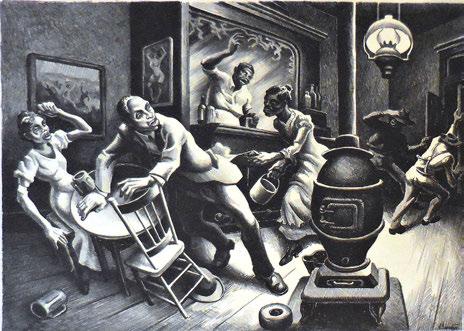

Thomas Hart Benton — Including “Frankie & Johnnie,” “Huck Finn” and “Jessie James.”
Gerald Brockhurst — “Adolescence” as well as others.
Margaret Burroughs — Several linocuts.
Asa Cheffetz — A large selection of his wood engravings.
Howard Cook — Many New York images.
Mabel Dwight — Some of her finest satirical lithographs.
Don Freeman — Many New York images — some hand-colored.
Kate Hanlon — Over 40 lovely Provincetown School white line color woodcuts.
Rockwell Kent — Over 25 wood engravings and lithographs.
Paul Landacre — Exceptional wood engravings by this American master.
Martin Lewis — “Glow of the City” and other extremely rare New York and Connecticut etchings.
Louis Lozowick — Over 10 New York images.
Kyra Markham — “Nightclub” and many exceptional lithographs and important paintings.
James McConnell — Several early dynamic abstract color screen prints.
Robert Riggs — A wide variety of his boxing, circus and other poignant lithographs.
Luigi Rist — A huge selection of his striking color woodcuts of floral subjects.
George Rogers — Extremely rare sculpturegraphs by this rediscovered African American artist.
Clyde Singer — Many wonderful paintings.
Raphael Soyer — Important early prints and a few paintings.
James Tissot — Many lovely turn of the century etchings.
Grant Wood — Several lithographs by this important American regionalist. We are always interested in purchasing important works by artists we represent and would welcome any offers for sale. Our vast website (more than 5,000 items) can be found at www.paramourfinearts.com. Our email is edogul@paramourfinearts.com.
We are located in Franklin, Mich., and can be reached at 248-539-7775.
Please call or email with any inquiries and to be added to our mailing list.
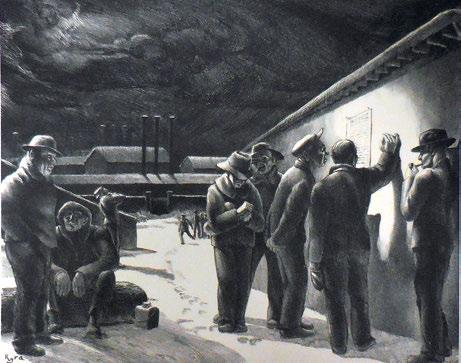

BERKELEY, CALIF. — On October 31, PBA Galleries will present the third and final sale of comic books from the estate of the late Steve Ditko, the reclusive genius whose highly-stylized renderings defined Spider-Man and Doctor Strange for generations of fans.
Steve Ditko, a seminal figure in comic book history, profoundly influenced the medium through his distinctive artistic style and innovative storytelling techniques. Born on November 2, 1927, in Johnstown, Penn., Ditko’s artistic journey began in his youth. His education at the School of Visual Arts in Manhattan and his service in World War II laid the foundation for his future career. By the early 1950s, Ditko had entered the comic book industry, showcasing his detail-oriented art and imaginative storytelling.
Ditko’s most notable achievement came through his collaboration with writer Stan Lee at Marvel Comics. In 1962, they co-created Spider-Man, a character who would transform the superhero genre. While Lee crafted Spider-Man’s voice and personality, Ditko brought the character to life with groundbreaking visual design. Ditko’s depiction of Spider-Man, with its unique web-patterned costume and expressive eyes, was unprecedented in comic books. His dynamic layouts and panel compositions conveyed action and emotion in ways that set new standards for visual storytelling.


Beyond Spider-Man, Ditko’s creation of Doctor Strange in 1963 marked another significant milestone. Doctor Strange, a sorcerer battling mystical forces, allowed Ditko to delve into themes of magic and the supernatural. His surreal and psychedelic artwork suited the character’s fantastical realm perfectly. Ditko employed unconventional panel layouts, vibrant colors and intricate designs to create a visually stunning experience that pushed the boundaries of comic book art. His work on Doctor Strange expanded the possibilities for depicting mystical and otherworldly elements in comics.
Ditko’s influence on the comic book medium is
substantial. His use of dynamic panel layouts and dramatic perspectives added visual sophistication to the genre. He also introduced psychological depth and moral complexity into superhero narratives, exemplified by Spider-Man. Unlike traditional superheroes, Spider-Man was portrayed as a relatable individual grappling with personal and ethical challenges, which added layers of depth to his character and made him enduringly popular.
Ditko’s storytelling was marked by a focus on characters’ inner lives. Spider-Man was not merely a superhero but a complex character dealing with personal struggles. Ditko’s exploration of these themes helped mature the superhero genre, emphasizing character development and moral ambiguity. His experimental approach to narrative structures and
NOV 16, 2024 to FEB 9, 2025
artistic techniques laid the groundwork for future creators to innovate and engage readers in new ways. Ditko’s legacy extends beyond his creations. His artistic and narrative innovations have inspired countless comic book artists and writers.
Many contemporary creators draw on Ditko’s style and approach, and his influence is evident in the evolution of comic book storytelling. His emphasis on psychological complexity and moral dilemmas in heroes has become a defining trait of modern superhero stories. His creative legacy continues to inspire new generations of creators, ensuring that his influence will resonate in the world of comics for years to come.
PBA Galleries is at 605 Addison Street. For information, 415-989-2665 or www.pbagalleries.com.

This
By Mark Murray
NEW YORK CITY — This autumn at the Mark Murray Fine Paintings gallery, we are pleased to be exhibiting a “rare, instructive and beautiful” oil study by the Austrian Orientalist painter, Ludwig Deutsch, recently discovered in a private collection in Virginia after being untraced in the artist’s oeuvre. Painted circa 1887-88, this is a study for Deutsch’s large painting “Guarding the Palace,” painted in Paris in 1888 (oil on canvas, 60½ by 38 inches), formerly in the collection of Pierre Bergé and Yves Saint Laurent, until sold at Sotheby’s, Paris on October 30, 2018, to a private collector.
“Palace Guard” (oil on canvas, 13 by 7¾ inches) was examined by Dr Emily M. Weeks and will be included in her forthcoming critical catalogue of Ludwig Deutsch’s Orientalist works. In an essay about this painting, Dr Weeks notes that “the differences between the smaller study and the finished version are readily apparent: the figure in the study has armor or a gauntlet over his right arm and hand (similar to that depicted by Deutsch in his “Palace Guard” of 1892), for example, and the number of steps and tile patterns differ between the works, as well. These compositional inconsistencies reflect what may be considered a logical path of conceptual and aesthetic development as the smaller work evolved into a more formidable painting intended for exhibition and sale.”
“The popularity of Deutsch’s single-figure guard pictures,” writes Dr Weeks in her essay, “which appeared regularly after 1880, is suggested not only by the sheer number of works he produced of this type (or versions thereof), but by the repetition of certain compositions and compositional details to satisfy his seemingly insatiable audiences. Deutsch’s uncanny ability to replicate favorite motifs, and yet invest each of them with a sense of novelty and immediacy, was aided by the manner in which he composed each picture: Deutsch employed a small number of African and Arab models in Europe, and regularly drew from the many sketches he made on his trips to the Middle East.”
Ludwig Deutsch had an impressive following among late Nineteenth Century collectors and won gold medals in Paris at the Salon of 1892 and Exposition Universelle in 1900. Kristian Davies, in his 2017 introduction to the catalog, The Art of Ludwig Deutsch from the Shafik Gabr Collection, ranks Deutsch as “among the best of the Nineteenth Century Orientalists” and notes that, “Today his work is highly sought after for its exceptional

detail and precision, which at its best verges on a virtual trompe l’oeil of photographic realism; yet his brushwork still bears a lush, painterly richness.” Museums displaying works by Deutsch include the Lusail Museum in Doha, Qatar, and the Dahesh Museum of Art in New York City.
Orientalist paintings are one of the gallery’s primary

“Guarding the Palace” (1888), by Ludwig Deutsch (1855-1935), oil on canvas, 60½ by 38 inches.
“Palace Guard” (circa 1887-88), by Ludwig Deutsch (1855-1935), oil on canvas, 13 by 7¾ inches. This is the rediscovered study for “Guarding the Palace.”
specialties and this autumn we are pleased to be exhibiting a wide selection of important works by Jean-Léon Gérôme, Alberto Pasini, Edwin Lord Weeks, Frederick Arthur Bridgman, Adolphe Schreyer, Narcisse Berchère, Edwin Long, Rudolf Ernst and Charles Bargue.
Mark Murray Fine Paintings is at 116 East 62nd Street, New York City. For further information, visit www.markmurray.com or call 212-585-2380.
NEWPORT, R.I. — Two bronze relief sculptures by Gertrude Vanderbilt Whitney have found a new home at The Breakers, her family’s former mansion in Newport. Whitney (1875-1942) was a noted sculptor and founder of the Whitney Museum of American Art in New York City. These two reliefs are smaller casts of her panels on a 1919 Victory Arch in New York’s Madison Square. The arch was built of plaster and wood, triumphantly soared over several parades of World War I soldiers, then was torn down.
The bronze reliefs were kept at Whitney’s Long Island
studio for decades until last year, when the Preservation Society of Newport County purchased them from her estate. The Preservation Society owns, maintains and operates The Breakers and 10 other historic properties that are open for tours.
The larger piece, “America at War,” is 5 feet long and weighs more than 300 pounds. It depicts soldiers engaged in a chaotic battle. The smaller piece, “Blinded,” features a soldier, blinded by poison gas, being assisted by a comrade. These figures formed the central group on a larger panel from the Victory Arch.

The sculptures were installed Thursday, September 5, in the circular service area of The Breakers where visitors exit the house after their tour.
The public display of these commemorative works coincided with the installation of a monumental new sculpture at the National World War I Memorial in Pershing Park, Washington, DC. The 58-foot bronze relief by Sabin Howard, titled “A Soldier’s Journey,” was unveiled on Friday, September 13, by the United States World War One Centennial Commission.
Whitney was one of the few American sculptors with firsthand experience of World War I. She traveled to France in 1914 and founded a hospital for wounded soldiers in the town of Juilly. There she comforted wounded men and made drawings that she later used when designing her public memorials. Another famous commission was her 20-foot-high sculpture for the American Expeditionary Forces Memorial in SaintNazaire, France, with its figure of a “doughboy” standing with his arms outstretched atop a giant eagle. A maquette, or study, of that memorial is displayed in her bedroom in The Breakers.
The Preservation Society of Newport County, Rhode Island, is a nonprofit organization accredited by the American Alliance of Museums. It is dedicated to preserving and interpreting the area’s historic architecture, landscapes, decorative arts and social history. Its 11 historic properties — seven of them National Historic Landmarks — span more than 250 years of American architectural and social development. For more information, www.newportmansions.org.
CINCINNATI, OHIO — The Cincinnati Art Museum (CAM) premiere an unprecedented exploration of the early career of Ansel Adams, demonstrating how, between 1916 and the 1940s, Adams developed from a teenage tourist with a camera into the country’s most celebrated photographer. Drawn from the definitive Adams archive at the Center for Creative Photography (CCP), Tucson, “Discovering Ansel Adams” will be on view through January 19, 2025.
The exhibition brings together approximately 80 photographs with unique ephemera, including handwritten correspondence, snapshots, personal possessions and photographic working materials. Featured photographs range from small, one-of-a-kind prints from Adams’ teenage years to jaw-dropping, muralsized prints of his most iconic views.
“Discovering Ansel Adams” traces the artist’s professional evolution — sharing his journey from teenage musician to young mountaineer — as he experiences the American Southwest, imagines and learns how to communicate with a new national audience and undertakes an epic quest to photograph America’s national parks.
Dr Rebecca Senf, foremost Adams scholar, organizing curator and chief curator at the Center for Creative Photography, shares, “After 20 years of research on Ansel Adams, it is a delight to share these spectacular prints and rare archival materials with the Cincinnati Art Museum’s audience. I hope that learning about Adams’ personal and professional journey, seeing rarely shown prints, and exploring how the prints were made will enrich people’s appreciation of Ansel Adams images they already know.”
Nathaniel M. Stein, curator of Photography at the Cincinnati Art Museum, says, “It’s been a tremendous pleasure to work with Dr Senf to bring the CCP’s unparalleled Adams holdings to Cincinnati. This exhibition has changed my understanding and deepened my ap-
preciation of a figure I thought I knew. I’m eager for the public to share in that experience.”
The exhibition will offer insight into Adams’s experiences in Yosemite and with the Sierra Club in his formative years, his early forays in the art of bookmaking and his commercial endeavors in his beloved Yosemite National Park and elsewhere in the American West. These seldom-explored backstories lend new dimensions to the Adams we know, and to his guiding mission to communicate the power and importance of America’s wild places to broad audiences. Personal snapshots, letters, tools and working material provide an intimate look at the person behind the camera.
Ansel Adams, photographer and environmentalist, was born in San Francisco, California, the son of Charles Hitchcock Adams, a businessman, and Olive Bray. An only child, Adams was born when his mother was nearly 40. He was raised in an environment that was deeply Victorian, and Adams was a solitary child; at the age of 12, he taught himself to play the piano and read music. Although he ultimately gave up music for photography, the piano brought substance, discipline and structure to his frustrating and erratic youth. Moreover, the careful training and exacting craft required of a musician profoundly informed his visual artistry, as well as his influential writings and teachings on photography.
Adams was the recipient of three Guggenheim Fellowships during his career, the first being awarded in 1946 to photograph every national park. At that time, there were 28 national parks, and Adams photographed 27 of them, missing only Everglades National Park in Florida. This series of photographs produced memorable images of Old Faithful Geyser, Grand Teton and Mount McKinley.
The Cincinnati Art Museum is at 953 Eden Park Drive. For more information, 513-721-2787 or www.cincinnatiartmuseum.org.

Ansel Adams (American, 1902–1984),





Tales: The
THE DC UNIVERSE COLLECTION Part 4: SUPERMAN November 14, 2024

Weird Tales and Amazing Stories: The PBA Pulp Sale October 24, 2024


COLLECTION Part 3, and More October 31, 2024



PBA Galleries has a proud 65 year history of serving collectors around the world. Known for its biweekly auctions of rare and collectible books in all genres, the auction house also features specialty auctions of Fine Pens & Watches, Original & Illustration Art, Comic Books & Comic Art, and Golf Books, Clubs, Memorabilia & other Collectibles. We invite consignments year round in a variety of fields. For more information about PBA Galleries, consigning or our upcoming auction schedule contact us at 415-989-2665 or pba@pbagalleries.com.

• Cartography
• Literature & Countercultre
• Comics
• And many others





NORTH ADAMS, MASS. — MASS
MoCA presents “Osman Khan: Road to Hybridabad,” the first solo museum exhibition by the Detroit-based artist of a new body of multimedia works. The show will be on view in Building 4, first floor, through March.
In “Road to Hybridabad,” Khan rereads the magical and fantastical figures found in folktales and lore, with a particular focus on those from South Asia, the Middle East and other Muslim and immigrant traditions. Khan interprets these figures through contemporary technologies through a new body of work that includes a 10-foot-tall animatronic djinn head, a forest of telephone poles with djinns atop them, drone-powered flying carpets, a boundary wall-destroying sound system, a fountain of endlessly flowing honey and a robotlike sculpture that is in fact a storytelling “Scheherazade AI.” This last work references a legendary young woman who told stories to a king for a thousand and one nights, ending each tale on a cliffhanger until the following evening in order to delay her execution.
The sprawling exhibition invites visitors on a journey across borders, through time, and between legend and history, encouraging reconsid-
eration and rewriting of narratives around identity, difference and power reflected in the tales we tell ourselves. It draws in part on tales that make up The Thousand and One Nights (often known in English as the Arabian Nights) which have many authors and have shifted with each retelling as they are adapted to new historical and cultural contexts. Khan encourages a rereading of the fantastical elements of such folk narratives not as superstitious and fanciful, but as aspirational applied technologies.
“‘Road to Hybridabad’ reflects Khan’s own particular experience of identity formation, which, like The Thousand and One Nights, has been influenced by many histories and cultures — blending American, South Asian, Middle Eastern and Muslim lores and visual references,” noted MASS MoCA curator Alexandra Foradas. “His work brilliantly layers legend, history and contemporary technologies, employing what he calls ‘active hybridity’ to disrupt the aesthetics and logics that support and reproduce dominant power systems. Khan has built on these themes over the course of his years-long relationship with MASS MoCA — from his 2018 residency at The Studios at MASS
MoCA (managed by Assets for Artists) to his commissioned installation in the 2020 group exhibition ‘Kissing through a Curtain,’ to now a solo exhibition with ‘Road to Hybridabad.’”
Upon entering the exhibition, visitors are invited to answer a riddle asked by the immense animatronic djinn in order to gain access to its inner sanctum: an allegory for the possibility that learning and knowledge are still the keys to accessing coveted information. In the adjacent “Re-Reading Room,” audiences can hear stories from the robot-like form of Khan’s Scheherezade, an AI trained on contemporary immigrant narratives and traditional folktales. Through these interactive, immersive installations, “Road to Hybridabad” posits a connection between legendary tales and technology as opportunities for delight, and as conversational partners through which histories and identities can be reread and even rewritten as we migrate through the world.
The MASS MoCA is at 1040 MASS MoCA Way. For information, www. massmoca.org or 413-662-2111.
Osman Khan, “Scheherezade 2.0,” 2024. Courtesy of the artist.



AMHERST, MASS. — The Eric Carle Museum of Picture Book
Art (The Carle) announced a major acquisition of artwork by Caldecott Medalist Jerry Pinkney. The acquisition from the Pinkney family includes Pinkney’s iconic 2009 cover illustration for the Caldecott Medal-winning book, The Lion & the Mouse (Little, Brown Books for Young Readers), plus 39 related works of art from the book, including 15 published illustrations and 24 preliminary sketches.
Jerry Pinkney (1940-2021) was a brilliant artist and storyteller who changed the course of chil-
dren’s literature. He influenced millions of young readers and entire generations of up-and-coming illustrators. In addition to his books celebrating African American history and culture, Pinkney also loved fairy tales, particularly Aesop’s Fables, from which the Lion and the Mouse is derived.
One of his trademarks was to take famous tales, stories that often traded in racist stereotypes, and reinterpret them. As an individual and as an artist, Pinkney always had hope for a better future. He was a founding trustee of The Carle, and the 2014 Carle Honors Artist. His work has been

exhibited at The Carle dozens of times, and he was a frequent speaker at the museum. For many years, Pinkney served on the museum’s collections committee, where he led efforts to diversify The Carle’s holdings and look at children’s literature through the lens of representation.
Jerry Pinkney’s cover for The Lion & the Mouse is legendary. Realistically rendered in graphite, watercolor, and colored pencil, the lion’s velvety fur and cascading halo of hair appear soft enough to touch. Jerry, a master of anthropomorphism, depicts a lion with quizzical arched eyebrows and a sideward glance, inviting us into his wordless picture book. The publisher’s courageous decision not to overlay type on the cover serves to focus all attention on the majestic creature; there is nothing to compete with the lion’s noble presence. It is a portrait of immediacy, power and personality.
“We are very excited to acquire Jerry Pinkney’s cover image for The Lion & the Mouse,” says executive director Jennifer Schantz. “The Carle is the international champion of picture book art and adding Jerry’s work to our permanent collections will deepen our holdings of visionary artists and allow our visitors and scholars to glimpse the masterful illustration of the ferocious lion in the richly conceived favorite adaptation of Aesop’s Fables.”
“On behalf of the Pinkney family, we’re pleased and honored to have Jerry’s The Lion & the Mouse find its home at The Carle,” says Gloria Jean Pinkney, Jerry’s wife and creative collaborator for more than 60 years. “Jerry believed deeply in The Carle’s mission. As a wordless picture book, The Lion & the Mouse illuminates Jerry’s unwavering commitment to reaching the hearts of
children through the power of visual literacy, and art’s ability to transform and inspire.”
The Carle led a successful campaign to acquire Pinkney’s The Lion & the Mouse. It was met with great enthusiasm by the museum’s collections committee and numerous friends. The museum is grateful for the generous supporters who made this important acquisition possible.
Pinkney’s cover for The Lion & the Mouse will be on display at The Carle through March 9 as part of the installation “Recent Acquisition: Jerry Pinkney’s Lion and the Mouse.”
The Eric Carle Museum of Picture Book Art is at 125 West Bay Road. For information, www.carlemuseum.org or 413-559-6300.




he Hessian Ministry of Science and Research, Art and Culture and the University Council of the Academy of Fine Arts - Städelschule announced that Barbara Clausen will take up her post leading the Städelschule on October 1, with a contract term of five years. She will succeed Yasmil Raymond, who headed the Städelschule from 2020 to 2024 and left her post in July. Curator and art historian Clausen was born in Austria in 1970 and was most recently vice dean for research and development on the art faculty at the Canadian Université du Québec à Montréal where she has been professor of contemporary art and performance at the Institute of Art History. In 2023, Clausen was Chillida visiting professor at the Art History Institute of the Goethe University Frankfurt am Main. As director of the Städelschule, she will also take over the management of the Portikus exhibition house.

The Cranbrook Educational Community Board of Trustees announced that Christopher (Chris) Whittey has been named the Maxine and Stuart Frankel interim director of Cranbrook Academy of Art. He succeeds Paul Sacaridiz, who left Cranbrook in 2023. Whittey’s tenure began in September. Whittey joins Cranbrook from Oklahoma State University (OSU), where he held the position of Vaughn Vennerberg II chair of art, professor of art, and head of the department of art, graphic design, and art history for the past two years. Cranbrook will launch a search for a permanent director at a later date.
MBROOKLYN, N.Y. — The Brooklyn Museum is unveiling a refreshed brand on the occasion of its 200th anniversary. The new logo and visual identity reflect and celebrate the past while bringing the institution boldly into the future, according to the museum. It goes on to say, “This rebrand marks an exciting new chapter, as the updated look is rolled out throughout the fall via new signage and collateral, a digital campaign, a new website and a suite of exclusive merchandise.”
“The ways that audiences are engaging with museums are expanding, and we needed a new brand that meets the demands of the day, honors our rich history and brings a whole lot of energy. And there’s no better time to launch it than our 200th anniversary!” said Anne Pasternak, Shelby White and Leon Levy director of the Brooklyn Museum.
The new “visual identity” of the museum entails a sans serif font, new ligatures featuring an overlapping “o” in Brooklyn and a combined “u” and “m” at the end of museum and two dots surrounding the institution’s name intended to mimic those that frame the names of ancient philosophers, playwrights and poets on the building’s facade.
“This reference to writers and thinkers links to our beginnings as a library and to the intersectional nature of the arts,” the museum stat-

ed in a release.
“In particular, the brand looks to the museum’s iconic building, considering its evolution from an original neoclassical design by McKim, Mead & White to its moves toward Modernism in the 1930s, to recent projects that have created more open and welcoming spaces. The brand draws on these elements from our past and unites them with our identity today as a contemporary institution,” it continued.
The logo was designed by Brooklynbased graphic design studio Other Means, with support from the museum’s in-house graphic designers.
In every application, the dots appear at least twice, an echo of the two Os in Brooklyn. They can be activated in motion graphics, used as bullets in text or as functional features in signs and occasionally replaced
with symbols or illustrations to add meaning or a sense of play.
The new palette includes a range of grays, paying homage to the museum’s limestone building, as well as brighter, more saturated hues, lending a distinctly Brooklyn vibe. The two dots, overlapping letters and kaleidoscopic colors all convey the Brooklyn Museum’s identity as a place where a multiplicity of ideas, identities and points of origin converge. These design elements nod to the encyclopedic collection as well as the interconnected roles the museum plays for its multifaceted audiences: art museum, educational center, forum for ideas, weekend hotspot and many more.
The Brooklyn Museum is at 200 Eastern Parkway. For information, www.brooklynmuseum.org or 718638-5000.
PARIS (AP) — Notre Dame Cathedral in Paris is getting its bells back, just in time for the medieval landmark’s reopening following a devastating 2019 fire.

useum of Modern Art’s (MoMA) director Glenn Lowry will step down from his post in 2025, bringing to a close a 30-year tenure that will have made him the longestserving leader in the institution’s history. He has held the top post since 1995. When it was revealed in 2018 that he planned to continue through 2025, the museum parted with one of its cardinal rules: that “chief curators and other senior managers” retire at age 65. The policy, a MoMA spokesperson said at the time, “doesn’t offer enough flexibility to strategically recruit and retain a talented and experienced work force.” Lowry, who is now 69, has already gone past that limit. When he retires in September 2025, he will be pushing 70.

The Fondation d'entreprise Hermès is handing the reins of its Artists' Residencies program to Emmanuelle Luciani, who will choose the artists she mentors during their residencies. Challenging the workshops to create futuristic pieces, Luciani gives pride of place to crossing techniques and methods. The aesthetic she champions borrows as much from the medieval period as from cyberpunk, and plays on the tensions between the past and a phantasmagorical future. In February, two residencies began under her watchful eye: those of Jenna Kaës at the Maroquinerie de la Tardoire in Montbron, and Mounir Ayache at the Holding Textile Hermès workshops in Lyon.
A convoy of trucks bearing eight restored bells — the heaviest of which weighs more than four tons — pulled into the huge worksite surrounding the monument on September 12 on an island in the Seine River.
They are being blessed in a special ceremony inside the cathedral before being hoisted to hang in its twin towers for the December 8 reopening to the public.
Cathedral Rector Olivier Ribadeau Dumas, wearing a hardhat as he prepared to enter the cathedral and bless the bells, called them ‘‘a sign that the cathedral will again resonate, and that its voice will be heard again. A sign of the call to prayer, and a sign of coming together.”
The bells will be raised one by one and tested out, but they won’t ring in full until the day of the reopening, said Philippe Jost, overseeing the massive Notre Dame reconstruction project. He called the bells’ arrival ‘‘a

very beautiful symbol of the cathedral’s rebirth.’’
While construction on the cathedral started in the Twelfth Century, the bronze bells damaged in the fire are from the Twenty-First Century. They were built according to historical tra-
dition to replace older bells that had become discordant, to mark the monument’s 850th anniversary. The cathedral’s roof and spire, which collapsed in the fire, have been replaced, and scaffolding is being gradually removed from the site.
WASHINGTON, D.C. — The National Gallery of Art (NGA) announced it is partnering with the National Gallery of Victoria (NGV) in Australia to streamline the exchange of artworks from both institutions, according to a press release. The collaboration is billed as “the largest exhibition of Aboriginal and Torres Strait Islander art ever presented internationally,” and it is slated to open at the NGA in October 2025. It will also travel to several other locations, including the Royal Ontario Museum,
Canada. The show, titled “The Stars We Do Not See: Australian Indigenous Art,” is curated by the NGV, and will include more than 200 works by more than 130 artists from its Melbourne collection, dating from the late Nineteenth Century to today. In 2027, the NGA will return the favor with an exhibition of major works from its D.C. collection. In a statement, Tony Ellwood, director of the NGV, said, “Never before has a volume of works of this size and national significance toured internationally.”
WILLOUGHBY, OHIO — Milestone Auctions’ Fall Antique Toys Extravaganza on September 14 presented shelves and shelves of rare and desirable toys from around the world, featuring the singleowner Buddy Forman collection. Vintage toys that were lined up for sale in the live webcast sale included windups, battery ops, cast iron, pressed steel and more, with names like Disney, Buddy L, Keystone, Marx, American National, Sturditoy, Smith Miller, Kingsbury, Lehmann and others. Auctioneer Miles King elicited the auction’s highest price — $15,375 with premium — for a rare Disney celluloid windup Mickey Mouse Riding Horse toy, measuring 7½ inches long. Leaping over its $2/4,000 estimate, the toy was all original with colors that were still strong and its windup mechanism still sent horse and rider on their merry way. The toy is staying in the United States. Watch for a later roundup of some of this sale’s top highlights.

BLOOMFIELD, N.J. — “We were really pleased with how that did,” affirmed Andrew Holter, president of Nye & Company auctions, a few days after the firm achieved $68,750 including buyer’s premium for a federal eglo mise and parcel-gilt girandole clock made by Roxbury, Mass., clockmaker Lemuel Curtis. The timepiece was the highest selling of more than 965 lots offered in a three-day marathon of sales — conducted Sept 11–13 — that includ ed property from the estate of Barbara Mal lory Hathaway. Consigned to Nye by a pri vate collector, the third collector to own it, the clock was making its second trip across the block, having been previously auctioned in North Carolina in 2020. A trade buyer, bidding on behalf of a client, prevailed over competitors. More highlights will be featured in an upcoming issue.

10, Oct aandoauctions.com Ahlers & Ogeltree 4C 10, Oct brunkauctions.com Brunk Auction 2C 10, Oct hp.com/6289 Heritage 55 10, Oct live.dumoart.com DuMouchelles 63 10, Oct newenglandauctions.com
New England Auctions 47-48 10, Oct opferauction.com Opfer Auction 59 11, Oct hp.com/6289 Heritage 55 11, Oct live.dumoart.com DuMouchelles 63 11, Oct newenglandauctions.com
Every Thurs goldengavel.com
Every Tues Coventry, CT
30, Sept auctionsappraisers.com
30, Sept tomhallauctions.com
1, Oct auctionninja.com
Golden Gavel 64
Weston’s....................58
Winter Associates 62
Tom Hall Auctions 64
SJD Auctions 64
2, Oct kodner.com Kodner 64
3, Oct bodnarsauction.com
Bodnar’s Auction 64
4, Oct Jewett City, CT Leone’s Auction Gallery 2 4, Oct wiederseim.com Wiederseim Associates, Inc. 56
5, Oct dlstraightauctioneers.com
5, Oct georgecoleauctions.com
5, Oct josephekabe.com
5, Oct milestoneauctions.com
D.L. Straight 5C
George Cole 50
Joseph Kabe 60
Milestone Auctions 57
5-6, Oct abell.com Abell 53
6, Oct clarkeny.com
6, Oct fontainesheritage.com
Clarke Auction 51
Fontaine’s Heritage 54
7, Oct northfieldauctions.com Northfield Auctions 62 8, Oct landrypop.com Rago 61
8, Oct liveauctioneers.com Bert Gallery 62 9, Oct aandoauctions.com Ahlers & Ogeltree 4C 9, Oct chiswickauctions.co.uk Chiswick 60 9, Oct helmuthstone.com Helmuth Stone 7C 9, Oct live.dumoart.com

1st Sun Every Mo.Alameda, CA 7 2, Oct Dover, NH 13 4-5, Oct Plymouth, CT 29 6, Oct Milford, NH 3
DuMouchelles 63
New England Auctions 49 12, Oct auctionzip.com Hesse Auction 56 12, Oct brzostek.com Brzostek 6C 12, Oct cascobayauctions.com Casco Bay Auctions 58 12, Oct copakeauction.com Copake Auction 52 12, Oct liveauctioneers.com Main Street Auction 46 12, Oct thoscornellauctions.com Thos. Cornell Auctions..........2 13, Oct brozstek.com Brzostek 6C 13, Oct gabrielsauctions.com Gabriel’s Auction 64 15, Oct liveauctioneers.com Davies Auction 58 16, Oct brunkauctions.com Brunk Auction 2C 17, Oct brunkauctions.com Brunk Auction 2C 18, Oct Jewett City, CT Leone’s Auction Gallery 2 19, Oct rolandauctions.com Roland Auctions 2 19, Oct rolandauctions.com Roland Auctions 11 20, Oct blanchardsauction.com Blanchard’s Auction 52 20, Oct nyshowplace.com Showplace 3C 22, Oct woodburyauction.com Schwenke Auctioneers 2 24, Oct pbagalleries.com PBA Galleries 23G 24, Oct shannons.com Shannon’s 15G 27, Oct tremontauctions.com Tremont Auctions 62 30, Oct litchfieldcountyauctions.com Litchfield County Auctions 2 31, Oct pbagalleries.com PBA Galleries 23G 2, Nov groganco.com Grogan & Company 7G 8-9, Nov santafeartauction.com Santa Fe Art Auction 3G 13, Nov..litchfieldcountyauctions.com Litchfield County Auctions 2 14, Nov pbagalleries.com PBA Galleries 23G 17, Nov butterscotchauction.com Butterscotch Auction...........2 8, Dec tremontauctions.com Tremont Auctions 62 2025Feb...litchfieldcountyauctions.com Litchfield County Auctions 2 11-12, Apr...scottsdaleartauction.com Scottsdale Art Auction 5G
10-13, Oct Atlanta, GA 5 11, Oct Plymouth, CT 29 12, Oct Boxborough, MA 6 12, Oct Coventry, CT 6 13, Oct Bath, ME 13 13, Oct Wayne, NJ 33 18-19, Oct Plymouth, CT 29 20, Oct Milford, NH 3 20, Oct Boxborough, MA 13 3, Nov Milford, NH 3 30, Nov-1, Dec....Columbus, OH 5 2025 13, May................Brimfield, MA 2 8, July Brimfield, MA 2 2, Sept Brimfield, MA 2 Weekly Events Sun......................Jewett City, CT 2 Sun.....................New Milford,
CHEVY CHASE, MD. — Sloans & Kenyon started September off right with their September Estate Catalogue Auction, conducted on the 12th of the month. The 510-lot sale offered property from the estates of Bernard “Bernie” Delia, Arthur Cotton Moore and other notable consignors. Items up for grabs included vari-
ous furniture, paintings and sculpture, silver, decorative arts, rugs, Asian objects and clocks. Leading the sale was a 103-piece partial service of English Paragon fine bone china tableware. According to the auction catalog, the set is “in pattern of service made for Her Majesty Queen Mary” and was designed by J.A.
POUGHKEEPSIE,

— More than 700 lots of decorative arts, primitives, arts and crafts, collectibles, garden items, books and ephemera were offered by Hyde Park Country Auctions in the firm’s September 15 auction. Far surpassing its $1/2,000 estimate range, a cast iron Watling Manufacturing Co., gum vending machine from the early Twentieth Century achieved $27,600 including buyer’s premium, and was the sale’s top lot. The slot machine-style vending machine operated for five cents, with a memo at the top reading “For 5c you get a package of gum, and the number of premium checks indicated above.” These “gum checks” ranged from two to 20 depending on the luck of the operator’s pull. Though not currently working due to non-use, it was sold with all its keys and interior parts in good condition. The tabletop model measured 23 inches high and 16 inches wide and weighed more than 100 pounds. A more in-depth review will be in a future issue.
By Jim Salter
ST LOUIS, MO. (AP)
— A man used construction equipment to drop a heavy boom lift onto a sculpture that has stood for 25 years outside St. Louis’ Cathedral Basilica, badly damaging it, police said.
It wasn’t immediately clear whether the Angel of Harmony, which stood 14 feet (4.3 meters) tall and depicts a Black angel protecting three children of various races, could be saved.
The St. Louis Post-Dispatch reported that part of one of the children was broken off and the angel’s wings appeared to be damaged.
The motive for Tuesday night’s (September 17) vandalism was unknown, said police, who arrested a 35-year-old suspect.
The Angel of Harmony, created by Polish sculptor Wiktor
Robinson. All pieces were decorated with a polychrome floral decoration with cobalt and gilt borders. With provenance to the lifelong collection of LGBTQ+ activist Bernie Delia, the lot set the table for $5,398 against a $500/800 estimate. More highlights from this sale will be featured in an upcoming issue.

(Brimfield, Mass.) September Brimfield Closes Out A Strong Year
(Danvers, Mass.) Kaminski’s
(New York City) A
(Denver, Penn.)
(Phoenixville, Penn.)
(Westmoreland, N.H.) Hambletonian Portrait & French Chateau Furniture Headline Flying Pig
(Larchmont, N.Y.) Clarke Auction Gallery Bids Adieu To Summer With ‘Blockbuster’ Sale
(East Dennis, Mass.) Mumford
(Freehold, N.Y.) ‘River
(Geneseo, N.Y.)
(New
(Boston)
(New York City)
(Salem, Ore.) New
Ceramicist Peter Voulkos 6 (New York City) Museum Of The City Of New York To Showcase Postcards From Leonard A. Lauder 7 (Albany, N.Y.) Celebrate Mohican Art & Culture At The Albany Institute Of History & Art 11 (New York City) The Met Presents First Major Exhibition Dedicated To Architect Paul Rudolph 13 (Norfolk, V.A.) Glass Artist Peter Bremers Debuts A New Collection At The Chrysler Museum Of Art 13 (Greenwich, Conn.) Bruce Museum Presents Joel Sternfeld Photographs & Never-Exhibited Works 15 (London) The Courtauld Gallery
Szostalo, was installed in 1999, months after Pope John Paul II’s visit to St. Louis. The angel’s wings include more than 100 wind chimes and the children are playing instruments. The pedestal is inscribed with quotes from the New Testament, Pope John Paul II and Martin Luther King Jr. Police arrived at the ornate Catholic cathedral in St. Louis’ Central West End neighborhood after a caller reported that a man was tampering with construction equipment. The statue had been knocked off its pedestal. Police said the suspect also apparently fired a gunshot into an unoccupied car. It was not clear why.
Surveillance video helped point officers to the man. A police dog helped find the suspect hiding a few blocks from the cathedral.
In our coverage of Peter Mavris’ August

NEW YORK CITY — Paintings were all the rage at Swann Auction Galleries’ American Art sale, which was conducted on September 19. The 137-lot sale offered US-based and internationally composed landscapes, portraiture and still lifes, among others. Leading the day was “Dark Inlet,” an oil on canvas completed in 1980 by New York native March Avery (b 1932). The landscape scene used both bold and muted colors to depict an unoccupied
inlet; the work was signed and dated both on the upper lefthand corner and in ink on the stretcher verso. The 30-by50-inch painting had provenance to Summit Gallery in New York City — a label for the gallery was affixed on the reverse — as well as a private collection in Woodstock, N.Y. Flowing to $47,500, it far surpassed its $10/15,000 estimate. Additional highlights from this sale will be featured in an upcoming issue.

EAST DENNIS, MASS. — Over the course of two days, from September 12-13, Eldred’s conducted its Americana and Marine Art auction, with only online, phone and absentee bidding available. There were 308 lots offered on both days, for a total of 616 lots. Session one saw Americana, furniture, paintings, decorative arts and more cross the block, while session two focused on marine lots, including scrimshaw and whaling materials, ship models, paintings, Chinese export and more. Leading both days of the sale was “Where there is room in the heart there is room in the house,” an oil on board in session one by Elizabeth Mumford (Massachusetts, 19502020). The painting depicted figures and horse-drawn car-
FREEHOLD, N.Y. — An oil on canvas painting by Julie Hart Beers (1835-1913), “River Landscape With Cows,” measuring 66½ by 20 inches, sold way past its estimate of $1,5/3,000, finishing at $23,750, including buyer’s premium, at Carlsen Gallery on September 22. The painting sold to an East Coast gallery, bidding on LiveAuctioneers, said Abby Carlsen, the firm’s co-owner. According to American Art Gallery’s website, Julie Hart Beers Kempson is regarded as among the best and perhaps the only woman artist of Nineteenth Century America to specialize in landscapes. It’s a bio undergirded by the observation made by William Gerdts in his exhibition catalog, Women Artists of America, 1707-1964, in which he wrote of her rarity: “It is perhaps not surprising to find so few women landscapists,

since the rigors of painting outdoors and the unseemliness of women engaging in this activity during the Victorian era acted as a deterrent.” A year after her first husband’s death in 1876, Julie married Peter Kempson and moved to Metuchen, N.J., however, she continued to use the last name “Beers” and sign her works, as in this one, “Julie H. Beers.” Watch for further highlights from this auction in a later review.
GENESEO, N.Y. — On September 20, Cottone Auctions presented 204 lots from the Plantation, Fla., collection of Dr Martin May, an orthopedic physician, businessman, author and collector. Another 119 lots of Fine Art & Antiques from various estates, museums and individual collections followed on September 21. Earning the highest price across both days was a Nineteenth Century portrait of George Washington painted by Rembrandt Peale (America, 1778-1860). According to a 1926 letter from M. Knoedler & Company, New York, to Colonel Charles Clifton of the Buffalo, N.Y., Pierce-Arrow Motor Car Co., this portrait is known as “Port-Hole – Washington” and was originally purchased from the artist in 1845 by Giles F. Ward. Measuring 36 by 30 inches framed, the historic portrait was bid past its $200/400,000 estimate range to achieve $492,000 including buyer’s premium. Further review of the auctions will be in a later issue.

riages outside a large, coastal home and earned $7,680. The highest price of session two went to a bronze model of a canon, which fired off at $5,760. Additional highlights from this sale will be featured in an upcoming issue.
IOWA CITY, IOWA — Keith Haring’s mural “A Book Full of Fun” was painted at Iowa City’s Ernest Horn Elementary School more than three decades ago and has a temporary home at the University of Iowa Stanley Museum of Art and will be featured in the exhibition “To My Friends at Horn: Keith Haring and Iowa City,” on view to January 5 at 160 West Burlington Street. For information, 319335-1727 or www.stanleymuseum.uiowa.edu.
WASHINGTON, DC — On April 15, 1874, an exhibition by the “Anonymous Society of Painters, Sculptors, and Engravers, etc.” opened at the Parisian studio of the photographer Nadar on the Boulevard des Capucines. It was a defiant response to the official, government-sponsored annual exhibition known as the Paris Salon. The first exhibition of these Société anonyme artists included works by Claude Monet, Auguste Renoir, Edgar Degas, Berthe Morisot, Camille Pissarro, Alfred Sisley and Paul Cézanne, later known as impressionists. This now-legendary event is often considered the birth of modernist painting and remains a key moment in the history of Western art.
Honoring the 150th anniversary of the first impressionist exhibition, “Paris 1874: The Impressionist Moment” brings together some 130 paintings, works on paper, prints, sculptures, and photographs to explore the various ways that artists responded to a city recovering from the violence of war and enormous political and social upheaval. What exactly happened in Paris in the spring of 1874, and what meaning can we attach to the emergence of this artistic movement? Works shown at the first impressionist exhibition will be put into perspective alongside paintings and sculptures displayed at the official 1874 Salon. This unprecedented juxtaposition will help us understand the visual shock that visitors experienced when first encountering the works of the impressionists. The exhibition will also explore the circumstances that led more than 30 artists to defy the official system of the Salon, with its judges, prizes and government approval, by showing their art inde-
pendently. At the time, France was struggling to recover from its defeat in the Franco-Prussian War of 1870–71, the siege of Paris and the violence of civil war. Following these crises, artists were rethinking their art, discovering their voices and exploring new directions.
Eager for autonomy and challenging an academic system that often rejected them, Monet, Degas, Morisot, Pissarro and their colleagues came together as a société anonyme coopérative, an “anonymous cooperative society.” They exhibited their work in the very heart of Paris, in a photographer’s studio. Scenes of modern life and pleinair landscapes were displayed alongside more conventional paintings, engravings and sculptures. It represented a common desire to pursue art unconstrained by the established order. That order will be evoked with a selection of paintings and sculptures from the official Salon, held in the massive Palais de l’Industrie. This annual event, the highlight of the season, featured meticulously crafted mythological, religious and historical paintings that received government and academic approval. Comparisons between the first impressionist exhibition and the Salon will give us a fresh look at artistic divisions of the day. The exhibition is organized by the National Gallery of Art, Washington and the Musée d’Orsay, Paris, where it was on view March 25-July 14; it will be at the National Gallery of Art until January 19.
The National Gallery of Art is on Constitution Avenue NW between Third and Ninth Streets. For more information, 202-737-4215 or www.nga.gov.
SUBMITTED BY THE FAMILY
WEYMOUTH, MASS. — Willis Russell Henry of Marshfield, Mass., died peacefully, surrounded by his family, on Sunday, September 8, at South Shore Hospital in Weymouth, just two days after his 80th birthday.
Will would have you believe that he was born under the boardwalk during a hurricane in Atlantic City. While the boardwalk and hurricane details are still unconfirmed, he was born in Atlantic City, N.J., to Barbara Henry (née Houk) of Carey, Ohio, and Robert Henry of Enid, Okla., on September 6, 1944. The first of four sons, Will grew up outside of Columbus, Ohio, and spent the summers in Michigan with his grandparents, catching fish at their lake house. He attended high school at Millersburg Military Institute in Kentucky, and college at Ohio University, in Athens, Ohio, where he joined Sigma Chi fraternity. He went on to receive Masters’s degrees in education and acting. It was there that Will met the love of his life and partner in all things, Karel Rowe.
After graduation, Will moved to the West Coast to pursue theater and creative adventures in San Francisco’s Haight Ashbury district, where he spent the late 1960s. Karel soon joined Will there; later, in 1971, they moved in with friends in Beacon Hill, Boston, where Will was proud to secure a job at Brattle Bookshop. A year later, they relocated to Buzzards Bay, and then again to Marshfield to stay with Karel’s parents and save money. It was at this time that Karel’s older brother Charlie “Ranny” Rowe invited Will and Karel to help clean out the basement of his antiques shop in Newport, R.I. There, they discovered a trove of antique blue ink bottles, which they brought along with some other treasures from family and friends to sell at the Boston Flea Market at Faneuil Hall. This was the seed that soon flourished into Will’s lifelong calling and passion for antiques. Soon, the couple were making trips to visit Will’s mother in Ohio, who was also an amateur antiques dealer and collector. They would buy beautiful old country pie safes from contacts of Barbara’s and truck them back to Marshfield to sell at flea markets and shows around New England. They soon opened their own antiques shop, South River Primitives in Marshfield, and, in the fall of 1972, Will and Karel married. Through their love of antiques, they found a new community of friends making the rounds at local flea markets, antiques shows and auctions. Charles and Mary Grace Carpenter first introduced them to Shaker design, sparking an enduring passion. It was around this time in the 1970s that Will first had the opportunity to meet the Shakers living at Sabbathday Lake in Maine. By his account, that day Karel was wearing an ethereal chiffon dress; struck by her appearance, the Shaker sisters pulled her and Will aside to chat and share lunch. Will and Karel continued to grow their business, with Will pivoting to auctioneering in 1975, a natural fit for his theatrical training and talents. In 1980, they founded Willis Henry Auctions, Inc., and, in 1982, they held their first Shaker antiques auction, which became an annual event for more than 40 years. Will would go on to become one of the foremost experts on Shaker furniture in the world; he was also known for his detailed knowl-

edge in many other areas of antiques. In 1984, Will and Karel welcomed their first son, Tyler, and soon after purchased an old farmhouse in Pembroke, Mass., where they would host many auctions under giant tents in the yard. Tyler remembers these events from his childhood fondly as being like the circus coming to town in his own backyard, with family and friends all lending a hand. In 1990, Will and Karel welcomed their second son, Caleb, who Will referred to as “his little guy.” Caleb was born with special needs and Will could not have been a more devoted father and lifelong advocate for him. Will and Karel

continued to work together and completed their final Shaker auction this past June after 51 years of marriage. In the last years of Will’s life, his focus turned from the business of antiques to some of the pastimes he always enjoyed with his friends and family like traveling, fishing, gardening and music.
Will’s love of antiques and history played a large role in his choice to become an auctioneer, but it was his love of people and their personal stories that fueled his passion. Will made friends wherever he went. It seemed like every day he had a new story to tell about someone he had just met, to

whom everyone should be introduced. He was always connecting people through their common interests and experiences and he never wanted anyone to feel alone. He was a gregarious, funny storyteller and performer with an empathetic, introspective and creative heart. Will was a caring father and husband and would do anything for those he loved. He loved to surprise friends and family with unique trinkets and presents, and frequently brought flowers and pastries to Tyler and daughter-in-law, Annelise, or a new maraca he had made or found for Caleb. He shared his love of music, especially the blues, with his whole family, and he would take Caleb to every live music event that he could find. He was a big fan of the “drop-in” and would show up at both the best and worst of times just to tell you he was thinking about you or wanted to hear your voice. He believed in serendipity and that our experiences have significance beyond what we can understand and he was always looking for those deeper meanings.
Willis is survived by his wife, Karel Rowe Henry; his eldest son, Tyler Bingham Henry and wife Annelise Katherine Whitley; his younger son Charles Caleb Bingham Henry; his brothers Stephen Henry, Thomas Henry and Peter Henry; and many other extended family and loved ones. Willis was preceded in death by his father Robert Henry, mother Barbara Henry (née Houk), mother-in-law Claire Rowe, father-in-law Charles Rowe, and sisters-in-law Cheryl Rowe and Kelly Henry.
A reception was held on Saturday, September 21, followed by a Celebration of Life at MacDonald Funeral Home in Marshfield.
In lieu of flowers, donations should be made to organizations that have supported Will’s loved ones, including Perkins School for the Blind, the Alzheimer’s Foundation of America, or a charity of your choice.



COMPILED BY
MADELIA HICKMAN RING, EDITOR





In 1973, Suzanne and I bought an Eighteenth Century Dutch farmhouse in Austerlitz, N.Y. Within a year after we arrived, we established our antiques business. At the time, we were part of a close-knit group of dealers living in Columbia County that included Rich and Betty Ann Rasso, Grace and Elliott Snyder, Corey Daniels, John and Jackie Sideli and Michael and Jane Dunn. We were all young, either under 30 years of age or in some cases just a year or two over, and we all shared a deep abiding love for “the stuff.”
Imbued with youthful enthusiasm, energy and reverence for antiques, especially for “untouched” antiques, Suzanne and I signed up for and exhibited at flea markets and antiques shows — a lot of them. It was at one of our earliest shows, possibly at Valle’s Steak House in Saugus, Mass., (now long gone), or at one of Bob Mower’s (who died last year) Compass Antiques Shows on the South Shore of Massachusetts, where we first met fellow exhibitors, Karel and Will Henry.
The four of us were all about the same age. We all shared the same passion for antiques and we hit it off right away. Throughout the ensuing years, our friendship grew. We did many of the same shows. We bought from them; they bought from us. We visited them and spent many nights at their home. Likewise, they visited us and spent many nights at our home. During those visits, we often ventured out together in search of antiques. We had fun — a lot of fun — and our close friendship was palpable to others. We were perceived of as something of a unit, known among older colleagues as “the kids.”
The 1980s saw a shift in our relationship with Karel and Will, who now had two sons to raise, the younger of whom had special needs, requiring much of their attention. What impacted our relationship even more was Will’s decision to shift careers from dealing in antiques to auctioning antiques. In 1982, he conducted the first of what became annual Shaker Auctions.
The material culture of the Shakers was always our specialty, Suzanne’s and mine. Because of that and because we were friends, Karel and Will asked us to help with that inaugural sale, which we eagerly did. As the years passed, Will’s confidence and his credibility as a major player in the Shaker world grew. He had astutely perceived that there was a strong appetite for buying at auction, particularly among collectors. Much to his credit, he strived to establish himself as THE Shaker Auc-

tioneer. I admired and respected him for what he worked so hard to achieve. On many occasions, we directly benefitted from Willis Henry Shaker Auctions, most notably at the 1991 sale at Fruitlands Museum in Harvard, Mass., where we purchased two of the finest pieces of Shaker furniture we ever handled: a beautiful double washstand and a majestic tall chest, both in pristine original condition.
At the same time, on a personal level I missed the closeness that our shared “m.o.” as dealers had engendered. I recognized that Will no longer needed our help, and that we no longer had the same connection that we had enjoyed previously. Suzanne and I had to adjust to the reality that our relationship with Karel and Will had evolved and matured.
Then, in 2015, Suzanne died, and, for the next nine years, Karel and Will were chief among those who supported me with their kindness. It was almost as though we had become “the kids,” and having fun once again. I will be forever grateful to them both for that.
. . . and now Will is gone. I miss you, kid.
Bob Wilkins
rWe were saddened to hear of the death of Willis Henry. He has been an essential part of the Shaker market and is responsible for introducing and fostering interest in collecting Shaker pieces. His auctions have provided generations of new collectors with a source for buying, and equally important, he has helped long-time collectors find homes for their collections. It was always a pleasure to talk with Will, and he often reminisced with me about his early days working for Brattle Rare Books.
Scott DeWolfe DeWolfe and Wood Rare Books
rI met Will and Karel Henry in 1977, at the Lyndhurst outdoor show in Tarrytown, N.Y., when they were doing business as “South River Primitives.” Will and Karel were part of a generation of talented young dealers in country Americana and folk art who became influential figures in our business. After Will and Karel became auctioneers, I attended their first Shaker sale in 1982, which became an annual event. These auctions coincided with, and contributed to, the dramatic increase of interest and competition for Shaker antiques. Will Henry brought a wide swath of




Shaker pieces to the auction market, from the most humble to major examples, the famous and well known and new discoveries. Of my experiences at those Shaker auctions — the great purchases and disappointing underbids — the most memorable occurred at the 1990 sale of the John Roberts house collection held on the grounds of Mount Lebanon Shaker Village. When we arrived on the morning of the sale, a row of chairs had been placed in front of our reserved seats was occupied by none other than Oprah Winfrey and her friend, the artist and professor, David Driskoll (19312020), who were seated right in front of us. Oprah proved outgoing and boisterous, happily doing her own bidding. She had a lot of fun, enthusiastically purchasing many lots in a wide range of prices, said to be furnishings for a Midwestern farmhouse. Interestingly, we only bid against each other on one lot: a small three-drawer counter in original red paint pictured on the catalog cover and conservatively estimated about $40,000. I ended up the underbidder on the counter when Oprah paid $220,000 for it, then a record price for Shaker furniture. Over their years in business, many high water marks of price were established at Willis Henry Shaker auctions. Two of the most extraordinary items were sold in 2006 and established record prices that remain to this day: a work desk attributed to Orren Haskins for $491,400, to us and the finest known yellow carrier for $105,300 to our friends Bob Wilkins and Suzanne Courcier. Although Will and Karel Henry sold a wide array of art and antiques as auctioneers, their specialized Shaker sales are a legacy in the development of that market. Our community has lost a friend and the extended Shaker “family” one of its old guard.
David
A. Schorsch
Woodbury,
Conn.
rIn the summer of 1982, we packed our bags and loaded them into our pick-up truck, strapped our 18 month old toddler into his car seat between us — rather tight quarters — and started out on a 763-mile road trip from Saginaw, Mich., to Pittsfield, Mass., to attend Will’s first Shaker auction. It was more than worth the trip. Never had we seen so many beautiful Shaker artifacts gathered in one place. We were like kids in a candy store. During the preview we made out our shopping list and anxiously awaited auction day.
On the day of the auction, a tall, slim, handsome man approached the podium. He smiled his broad, engaging smile and started the auction…every eye and ear in the place was on him. As we all know, Will was a master storyteller and each piece had its own history. As novices, we were shocked by the prices which were way out of our reach, but we were able to purchase an early Mt Lebanon chair which we still treasure today. From that day forward, Will Henry had us hooked and we have never missed one of his annual Shaker auctions.
Will wasn’t just an auctioneer, he really got excited about the things he sold and he made it a point to be knowledgeable about them. He also cared about the people who attended his auctions and knew most of them personally. He and his lovely wife, Karel, made a great team and they worked hard to make their Shaker auctions so successful that they attracted major collectors, celebrities and Shaker aficionados from all over the world.
We consider ourselves fortunate to have had him as our friend and are thankful for so many great memories. His passing will be the end of an era for the Shaker realm.
Harlow and Cherie Murray r
I knew Will for over two decades; first as an auctioneer and then as a friend. He was always kind and certainly knowledgeable about Shaker furniture, artifacts and history. He helped me to develop a love of Shaker design and aesthetics.
Drew Epstein

The Will Henry I remember was born to be a teacher. I covered his auctions for a number of years-both Shaker and Americana. He knew that I was far from knowledgeable about Shaker material, but he always took the time to explain, “this is great because...” or “take a look at this.” And then he’d take the time to point out often obscure details to help me understand the objects we were talking about. He loved what he was selling. I last saw him a couple of months ago at the time of his last Shaker sale. He, Karel and I had lunch together that day, something we’d talked about doing for a long time. I’m glad we had the opportunity to do that. They were both good friends. He’ll be missed.
Rick Russack
rThe antiques and auction world has sustained a great loss with the passing of Willis Henry right after his 80th birthday. Will was born in Ohio and attended college there where he met his future wife, Karel. They moved from Ohio to Massachusetts sometime in the early 1970s and one of his first jobs was at the Brattle Street bookstore in Boston. This sparked his interest in old books and documents. Will’s mother was an antique dealer in Ohio, so he began to travel back there to bring primitive antiques to New England to sell. He opened his first antique shop in Marshfield, Mass., in the early 1970s. Shortly thereafter, he started running auctions out of the Marshfield Congregational Church. His business grew rapidly due to his great enthusiasm for older objects and his dynamic personality. As the auction business grew, he moved his sales to the Dedham Holiday Inn. In the early 1980s, he became very interested in Shaker and he started having specialty Shaker auctions. He had a unique approach to this market. He would conduct the sales at actual Shaker communities, including Hancock Shaker Village, New Lebanon, Harvard Shaker Village and Canterbury. These on-site sales revolutionized the Shaker market. Willis Henry Auctions quickly became the premier go-to company for Shaker collections. The specialty auctions were extremely successful and attracted many celebrities such as Oprah Winfrey, David Byrne from the group the Talking Heads, Bill Cosby and many others. Will became known as the auctioneer to the stars; he also sold items from the Nat King Cole estate. His interests, however, were not just in Shaker material. He had a passion for all early American objects as well as decoys, Native American and historical documents. He conducted numerous general estate sales in Pembroke and Duxbury. His sales were always interesting and he was known for bringing fresh merchandise to the market. He will also be remembered as being an outstanding father, especially to his disabled son, Caleb. He spent countless hours caring for his son. Will Henry was a true gentleman, a great friend and colleague.
David Glynn and Frank McNamee
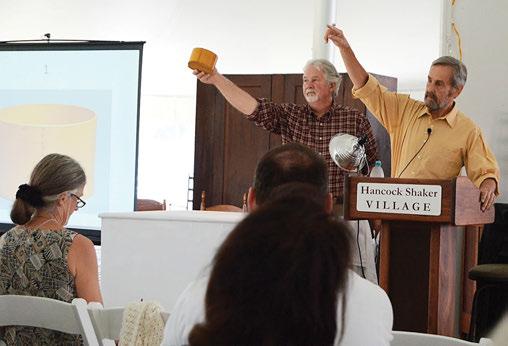
So deeply sorry to learn of Will Henry’s passing; our business has lost a true gentleman and our heart goes out to Karel and his family. Will’s love and understanding of Shaker life and artifacts will keep the Shaker legacy alive for future generations to learn from and Will Henry’s name will be eternally synonymous with the Shaker story.
Frank Gaglio Barn Star Productions
It is with great sadness that I received the news of Will Henry’s passing. His auctions were not only an opportunity to bid on objects, but wonderful social gatherings where people in the Shaker field renewed friendships and acquaintanceships and celebrated their common interests and shared devotion to a people and a history. Will was a man of integrity and honesty, a nice sense of humor, warmth and openness towards others. He will be greatly missed.
Darryl Thompson r
As a longtime friend just told me, the passing of auctioneer Willis Henry is the end of an era, and she is right. His auctions were not just sales, they were annual reunions. We all came to buy, or at least look, because we saw friends we may not have seen since the previous Will Henry sale. Or we made new “friends” at the sales and even bidding competition did not change that. Recently came a Will Henry internet auction — a sign of the times — but afterword, the phone calls from friends still were coming. Will also brought our

attention to the history of the Shakers by telling us about old time collectors and sometimes where and how they the built their Shaker collections. He also showed us the perfection found in the Shaker woodworking and “fancy goods,” tools, basket-making and sewing “smalls” and their dedication to simplicity, craftsmanship and utility. Also, we visited Shaker sites and joined Shaker village/community memberships often after his sales to learn more about the overall history and support the sites. Will and his family and staff will never be forgotten and we all thank them very much for the memories.
Fran and Herb Kramer Pittsford, N.Y.
rI first met Willis Henry in 1982, when he held his very first Shaker auction in Pittsfield, Mass. I was a beginning collector and Willis had recently purchased an entire Shaker collection for this auction. I was immediately impressed by this lanky and friendly auctioneer and his lovely wife, Karel. At this inaugural auction, I purchased a beautiful two door cupboard, from the Hancock Shaker community with original mustard wash. It would be the first of many pieces I would buy from Willis. Willis quickly grew a enviable reputation as a very knowledgeable and trustworthy auctioneer who could be counted on to offer many of the finest Shaker items. For most of the last 40 years, he held a yearly Shaker auction.
Willis Henry Auctions drew collectors and interested people from all over the country and the world. At various times, there were notable celebrities, politicians and collectors bidding on the items Willis offered. In 2022, I purchased a rare five-slat Canterbury, N.H., Elder’s rocker from Willis. He is pictured sitting in it in the attached photo. It was his favorite item in the auction; mine too. Willis will be greatly missed by all who knew him.
Bob Hamilton Lancaster, Penn.
rBoth myself and my business partner, Karin Phillips, were shocked and saddened to hear of Will’s passing. Will and I both started our auctioneering careers in the 1970s and, as I recall, we were often competitive in the beginning. Our friendship developed over the years as we progressed. He certainly was the Shaker “master” and put together wonderful auctions. Our paths crossed frequently as we were both “on the hunt” for the next great antique item. In the past several years, he and Karel always appeared at our auction exhibitions in Cambridge. We enjoyed our talks and shared experiences. The Shaker world — and antiques world in general — has lost one of its best.
Carl Nordblom CRN Auctions
Every Sunday Year-Round
75-100 EXHIBITORS
2 Wedgewood Drive
Slater Mill Mall
Jewett City, CT
Sun 9 am-4 pm
Manager: Bob & Sue Leone
860-376-3935 or 860-642-6248
Website: www.leoneauctioneers.com
January 14-December 22 Biweekly
October 6
Sunday
Rain Date October 13 LIVE
ANTIQUES FAIRE
800 VENDORS
3900 Main Street
Alameda, CA 94501
Sun 6 am-3 pm
Antiques By The Bay, Inc
Owner: Allen Michaan
Manager: Randie Bradley 510-522-7500 ext 3101
Website: www.alamedapointantiquesfaire.com
October 10-13
Thursday-Sunday
LIVE
October 12-13
Saturday & Sunday
STORMVILLE AIRPORT ANTIQUE SHOW & FLEA MARKET
OVER 400 EXHIBITORS
Stormville Airport
428 Route 216
Stormville, NY 12582
Sat & Sun 8 am-4 pm
845-221-6561
Website: www.stormvilleairportfleamarket.com
50 EXHIBITORS
Granite Town Plaza 185 Elm Street
Milford, NH
Sun Early Buying: 6:30-8:30 am - $40
8:30-9:30 am - $5
9:30 am-Noon – Admission Free
Manager: Deb Lerner & Rick Martin
603-506-9848
Website: www.granitestateantiqueshows.com
April 3-October 30
Wednesdays
60-130 EXHIBITORS
34 Quaker Meeting House Road
Sandwich, MA
Wed 6 am-12 pm
Sponsor: Lisa Davis
Manager: Lisa Davis
508-685-2767
Website: www.thesandwichbazaar.com
April 21-October 27
America’s Favorite Treasure Hunts!
3,500 BOOTHS!
Atlanta Expo Centers
3650 & 3850 Jonesboro Road SE
Atlanta, GA 30354
Thurs 10:45 am-6 pm, Fri & Sat 9 am-6 pm & Sun 10 am-4 pm
740-569-2800
Website: www.scottantiquemarkets.com
October 12 Saturday
PAPER TOWN – THE VINTAGE PAPER, BOOK & ADVERTISING SHOW!
45 EXHIBITORS
Boxboro Regency Hotel & Conference Center
242 Adams Place
Boxborough, MA 01719
Sat 9 am-3 pm
Sponsor: Flamingo Eventz, LLC
Manager: Tina & John Bruno
Phone: 603-509-2639
Website: www.flamingoeventz.com
Facebook: www.facebook.com/papertownvintage
October 27
ANTIQUE SHOW
Best Western Inn & Conference Center
815 Lafayette Road
Hampton, NH
Sun 10 am-1 pm
Manager: Peter Mavris 207-608-3086
Email: petermavris@gmail.com
Website: www.petermavrisantiqueshows.com
November 2
OVER 400 EXHIBITORS
Stormville Airport 428 Route 216
Stormville, NY 12582
Sat 8 am-4 pm
845-221-6561 Website: www.stormvilleairportfleamarket.com
25-50 EXHIBITORS
34 Quaker Meeting House Road
Sandwich, MA
Sun 7 am - Noon
Sponsor: Lisa Davis
Manager: Lisa Davis
508-685-2767
Website: www.thesandwichbazaar.com
November 2-3
Saturday & Sunday
600+ BOOTHS
Dulles Expo Center
4320 Chantilly Shopping Center
Chantilly, VA 20151
Sat 9 am-6 pm & Sun 11 am-5 pm
Manager: D’Amore Promotions
757-430-4735
Website: www.thebigfleamarket.com
November 3
Sunday
Rain Date November 10
800 VENDORS
3900 Main Street
Alameda, CA 94501
Sun 6 am-3 pm
Antiques By The Bay, Inc
Owner: Allen Michaan
Manager: Randie Bradley
510-522-7500 ext 3101
Website: www.alamedapointantiquesfaire.com
November 7-10
Thursday-Sunday LIVE
America’s Favorite
Treasure Hunts!
3,500 BOOTHS!
Atlanta Expo Centers
3650 & 3850 Jonesboro Road SE Atlanta, GA 30354
Thurs 10:45 am-6 pm, Fri & Sat 9 am-6 pm & Sun 10 am-4 pm 740-569-2800
Website: www.scottantiquemarkets.com
November 23-24
Saturday & Sunday
100 EXHIBITORS
New York State Fairgrounds 581 State Fair Boulevard Syracuse, NY 13209
Sat 9 am-5 pm & Sun 10 am-5 pm
Manager: Allman Promotions LLC 315-686-5789
Email: allman@gisco.net
Website: www.syracuseantiqueshow.com
November 24
Sunday LIVE
ANTIQUE SHOW
Best Western Inn & Conference Center 815 Lafayette Road
Hampton, NH
Sun 10 am-1 pm
Manager: Peter Mavris 207-608-3086
Email: petermavris@gmail.com
Website: www.petermavrisantiqueshows.com
November 30-December 1
Saturday & Sunday LIVE
America’s Favorite
Treasure Hunts!
800-1,200 BOOTHS
Ohio Expo Center 717 East 17th Avenue Columbus, OH 43211
Sat 9 am-6 pm & Sun 10 am-4 pm 740-569-2800
Website: www.scottantiquemarkets.com
NEW YORK CITY — The International Center of Photography (ICP) presents “We Are Here: Scenes from the Streets,” an indepth exploration into 50 years of contemporary public life documented through the lens of over 30 street photographers from around the world, beginning in the 1970s. Guest curated by Isolde Brielmaier, PhD, with Noa Wynn, independent curatorial assistant, “We Are Here” runs through January 6.
Featuring works by photographers from Algeria, China, Egypt, Germany, India, Japan, Russia, South Africa, the USA and beyond, “We Are Here” reframes our understanding of “the street” and the activities and exchanges that occur in diverse public and community spaces. In a world fraught with misunderstanding and societal tension, the exhibition highlights street photography’s unique viewpoints on local culture and unfolding events. Documenting both dramatic and everyday moments — from street style to protests — the works in “We Are Here” testify to the resilience and similarities of the human experience.
“‘We Are Here’ invites viewers to confront the richness and complexities of our modern, multifaceted life, emphasizing our shared humanity beyond geographic and cultural divides,” Brielmaier said of the exhibition.
“Today’s world moves fleetingly, but these images prove that though circumstances might change, humanity is not going anywhere; the stories of our lives will remain.”
“Street photographers often navigate the complexities of power dynamics and privilege,” Elisabeth Sherman, ICP senior curator and director of exhibitions and collections said. “We hope this exhibition sparks reflection and conversation about the historical and current dynamics of public spaces that are shaped and mediated by gender, race and socio-economic status and how we critically understand the ways they govern our lives.”
“As we end ICP’s 50th anniversary celebration with ‘We Are Here,’ we are reaffirming our mission to educate the public on the power of visual storytelling and to foster international dialogue about what it means to be a concerned photographer today,” said Bob Jeffrey, ICP CEO. “As we look toward the future of ICP and imagemaking, ‘We Are Here’ offers insight into how integral street photographers are to our understanding of the
culture, politics and day-to-day life of communities across the world.”
“We Are Here,” while not exhaustive, is expansive, highlighting many fresh and previously underrepresented voices in street photography as a genre, art and photographic discipline.
“We Are Here” situates each work in dialogue with one another, addressing universal themes such as neighborhood and community, urban landscapes, fashion and self-presentation and protest and advocacy. Together, these topics offer a framework for engaging with the changing social realities of public spaces around the world:
“On the Shoulder of Giants (An Ode to New York)” — New York City, a pivotal center for street photography in the USA, has nurtured pioneering photographers whose work has inspired subsequent generations. This section honors iconic photographers who have defined the genre, within the vibrant and dynamic context of New York City.
“Neighborhood and Community” — through a collaborative approach of engaging with local residents, photographers can offer an intimate look at the social fabric of neighborhoods and communities and how they evolve over time. Their work often results in vivid portraits that shape our understanding and perception, connecting us to people and places beyond the physical spaces we may call home.
“Street Style and Self-Fashioning” — fashion and style on the streets are potent forms of self-expression and identity. Photographers help turn the pavement into runways for creative expression. This section rejects traditional, staged fashion photography, emphasizing the unique style of everyday people and self-presentation as reflected in cultural trends and social movements.
“Urban Landscapes” — with urbanization on the rise, photographers document the ever-changing landscapes of contemporary cities. This section showcases how imagemakers reveal the ways we live, move and interact with our natural, built and social environments.
“Protest & Advocacy” — streets are crucial arenas for social activism. Featuring powerful images of public dis-

sent, this section highlights the streets as vital spaces for expressing collective frustration and advancing social change, providing a visual narrative of contemporary activism.
The International Center of Photography is at 79 Essex Street. For additional information, www.icp.org or 212-857-0000.
HOUSTON — Celebrating the acquisition of some 300 Cuban photographs from the Chicagobased collectors Madeleine and Harvey Plonsker, “Navigating the Waves: Contemporary Cuban Photography” traces the medium’s evolution in Cuba over nearly six decades — from promoting the Revolution following Fidel Castro’s 1959 overthrow of the Batista government, to engaging in social and political critique in more recent times as the triumph of the Revolution increasingly gave way to economic hardship and political repression. Particularly in the years after the 1991 collapse of the Soviet Union, Cuban photographers created powerful personal expressions by exploring individual identity, the body and spirit, Afro-Cuban heritage and the margins of society, all while navigating the fluctuating prescriptions and proscriptions of official cultural policy.
The exhibition of some 100 works are on view through August 3, in the Museum of Fine Arts, Houston’s Nancy and Rich Kinder Building for Modern and Contemporary art.
“With the acquisition of the Madeleine P. Plonsker Collection, the Museum of Fine Arts, Houston (MFAH), now boasts the most complete collection anywhere of post-Revolution Cuban photography, with an emphasis on the years since 1990: nearly 700 works by more than 80 Cuban artists,” commented Gary Tinterow, director and Margaret Alkek Williams Chair of the Museum of Fine Arts, Houston. “We are enormously grateful to Mrs Plonsker,

Raúl Cañibano, from the series “Country Land (Tierra guajira),” 2009, inkjet print, the Museum of Fine Arts, Houston, the Madeleine P. Plonsker Collection, gift of Madeleine and Harvey Plonsker. ©2009 Raúl Cañibano.
who assembled the collection through the lasting relationships she forged with artists over many visits to Cuba from 2005 to 2020.”
“The strengths of the Plonsker Collection are unparalleled, in terms of telling the complex and compelling story of post-Revolution Cuban photography,” commented Malcolm Daniel, Gus and Lyndall Wortham Curator of photography at the MFAH. “Combined in this exhibition with works already in the museum’s holdings, the collection allows us to chronicle that story from the ‘epic generation,’ whose work would define the image of the Cuban Revolution, to the succeeding generations of photographers, who questioned the power of photography and its relationship to political authority and who created highly per-
sonal work in the context of a greater awareness of international contemporary art.
The exhibition begins with a brief prologue featuring works by the so-called “epic” generation of photographers — Alberto Korda, Raul Corrales and Osvaldo Salas among them — who used the medium to further the ideals of the Cuban Revolution, celebrating its heroes andpromoting its ambitions. It opens with Korda’s iconic portrait of Che Guevara, “Guerrillero Heroico” (1960), the most widely reproduced and recognized of all Cuban photographs.
The first gallery presents images of daily life in Cuba, primarily from the 1990s and early 2000s, beginning with photographs that reference patriotic themes: the Cuban flag, veterans, a military parade and pub-
lic portraits of Nineteenth Century Independence hero José Martí and Cuban leader Fidel Castro. While ostensibly honoring the new Cuba, many of the images question both the power of photography and its relationship to political authority. An untitled 1992 photograph by José Figueroa depicts dozens of freshly made prints of Alberto Korda’s iconic portrait of Che laid out on a bed — Figueroa was Korda’s longtime printer — and suggests the ubiquity of that iconic image as both propaganda and commodity. Other photographs in this section of the exhibition depict the hardships and aspirations of rural Cubans in the post-revolutionary era as well as the day-to-day joys of life divorced from political concerns. Photographers in this section include Pedro Abascal, Raúl Cañibano, María Cienfuegos Leiseca, José Julián Martí, Humberto Mayol and Eduardo Muñoz Ordoqui.
The second section of the exhibition marks a pivotal shift in Cuban photography. As the nation plunged into economic, social and political crisis following the collapse of the Soviet Union and the loss of its financial support, a time that Castro dubbed the “Special Period,” many photographers turned from documentation of the public sphere to a more personal and poetic exploration of the private realm. Photographers treated the body, often their own, as the path through which to examine their present situation through the lens of AfroCuban rituals, personal history, queer identity, race and gender.
This particularly rich section features exceptional work by Juan Carlos Alom, Arien Chang Castán, José Manuel Fors, Alejandro González, Eduardo Hernandez Santos, Cirenaica Moreira, René Peña and others. In the final section of the exhibition, composed primarily of work made since 2005, photographers address the current political, social and economic situation more directly than in previous years — but slyly still, in order not to run afoul of government dictates and official arbiters of culture. This most recent generation of photographers, born well after the Revolution, came of age in the depths of the Special Period and began their artistic careers with a greater awareness of international contemporary art. Again, national symbols appear — the Cuban flag, currency, stamps, historic events — but this time with a knowing nod to their emptiness. The precarious nature of life in present-day Cuba and the widespread desire for emigration are common subjects. This gallery includes work by Adrián Fernández, Alejandro González, Glenda Léon, Liudmila & Nelson, Yasser Piña Peña, Sandra Ramos, Esterio Segura, Lisette Solórzano and others. The exhibition is accompanied by a fully illustrated catalogue published by MFAH and coauthored by MFAH curator Malcolm Daniel and Raquel Carrera, as MFAH research associate in the Department of Photography. The Museum of Fine Arts, Houston is at 1001 Bissonnet Street. For information, www. mfah.org or 713-639-7300.
NEW YORK CITY — The Jewish Museum presents “Ilit Azoulay: Mere Things,” the first US solo museum exhibition dedicated to the work of interdisciplinary artist Ilit Azoulay (Israeli, b 1972; lives and works in Berlin), through January 5. The exhibition features selections of Azoulay’s work from 2010 to the present, showcasing large scale digital photocollages of archival objects that explore how images and objects transmit knowledge, shape memory and support or undermine historical narratives. The presentation includes a new work that responds to the collections and context of the Jewish Museum, as well as selections from the series “Queendom” (2022), first presented as part of Azoulay’s solo exhibition for the Israeli Pavilion at the 59th Venice Biennale in 2022.
The works on view combine photomontage with sculptural and sound elements to magnify different aspects of object histories and introduce imaginative frameworks that expose the ways in which objects can embody multiple and shifting meanings. Advancing the Jewish Museum’s role as a beacon for the Jewish community and a place to explore universal values, the exhibition encourages viewers to recognize one another’s humanity by reconsidering how we perceive each other’s stories.
Initially trained in photography, Azoulay’s research-based practice explores the central role photography plays in archives and the idiosyncrasies of institutional systems created to preserve and produce knowledge. As an outgrowth of this practice, Azoulay created a new work, “Unity Totem” (2024), for the exhibition, mining the Jewish Museum’s collection for ritual objects such as Torah finials and amulets. Mostly created by Jewish communities throughout the Arab world, including in the artist’s familial homeland of Morocco, the objects in the photographs are suspended from a green hat that smokes like a cone of incense, spinning as they propel new spiritual energy outward into the world.
The series “Queendom” (2022) evolved similarly from a collection of photographs from the L.A. Mayer Museum of Islamic Art in Jerusalem. Working digitally with analog photographs by David Storm Rice (1913-1962), an Austrian-British and Jewish art historian and archaeologist, Azoulay isolated motifs and components in images of medieval Islamic metal vessels. She then spliced them into startling new forms that draw on the spirit of the original objects while opening up feminist reimaginings of male-dominated myths. By demonstrating the varied lives a sin-

“Vitrine No. 4: (Take, for instance, this) true story” (2017) from the series “No Thing Dies” by Ilit Azoulay. Inkjet print, gold leaf. About 56 by 47 inches. The Tony and Trisja Podesta Collection, Washington. DC. ©Ilit Azoulay.
gle object can lead, Azoulay allows the viewer to consider how images and objects are positioned to support certain views of history and reality and to hide or discredit others. Selections from the series will be shown in the exhibition.
Another installation that reflects on how institutions broker the transmission of knowl-
edge, “Shifting Degrees of Certainty” (2014) consists of photographs of 85 objects from historical sites in Germany undergoing preservation or reconstruction. These objects are nestled tightly together, creating equivalencies — sometimes poetic and sometimes comic in effect — with other objects as varied as a stuffed parrot and an imperial
throne. In an accompanying audio component, a narrator highlights aspects of each object’s history that differ from what historians and curators might deem important, asking visitors to confront how society preserves and interprets the past.
Additionally on view are selections from “No Thing Dies” (2017), a large-scale digital collage series commissioned for the Israel Museum in Jerusalem that combines photographs of rarely seen collection objects and spaces inside the Museum, and “Tree For Too One” (2010), a photo collage of found objects from the walls of a condemned house in south Tel Aviv.
The mounting of Azoulay’s first solo exhibition in the US builds on the Jewish Museum’s ongoing practice of exploring contemporary art in real time, providing a platform for each emerging generation of artists. Dating back to the 1960s, when the Museum hosted the first solo exhibitions of path-breaking artists like Jasper Johns and Robert Rauschenberg, the Museum has organized major solo exhibitions of such influential artists as Louise Bourgeois, Eva Hesse, Louise Nevelson, Man Ray, Ad Reinhardt, Martha Rosler and Art Spiegelman. The Jewish Museum is at 1109 Fifth Avenue. For information, www.thejewishmuseum.org or 212-423-3200.


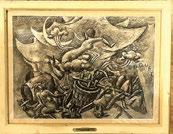
Preview Saturday, Oct 5, 11:00-3:00 or by appointment (Text (203)233-1736) 161 Main St S, Woodbury CT






Sale to include Park Ave NY estate, Art Dealers estate from Woodbury Ct, New Fairfield estate with select additions.
Antiques, oriental rugs, fine art, folk art, decorative arts, antique frames, coverlets, garden ornaments, American, oak, continental furniture, sculptures and more













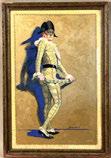





Highlights include: Alexander Calder signed lithograph, Joy Brown bronze, massive vintage paddle wheel boat weathervane, French empire brass mounted mahogany desk, 20 + vintage and antique room size rugs, 4 large vintage and antique bird cages, several Antique portraits, large old masters style o/c, set 6 paint decorated chairs, set of 10 ornate oak chairs, Hudson Valley sandpaper drawing, pr Chinese Export Armorial plates, Large oak sideboard, rare Wm and Mary Butterfly table, collection of tin parade decorations, summer winter coverlet w eagles, Wm and Mary Tavern table, set of 8 framed botanical prints from 1736, folk art rocking horse, mahogany and carved giltwood console table with mirror phoenix birds, Federal Bow front chest, Ruth Berk folk art sign, Lalique Conch, Navaho rug, 17.7x14.1 Aubusson carpet, Antique ornate childs sleigh, country farm table, slant front desks, Chippendale step back cupboard, antique copper pots, inlaid pipe box Artists include Alexander Calder, Joy Brown, Eugene Savage, Kurtz, Lindenthaler, Allier, Kerry, Barribal, Soler, Duckworth, Clapp, Grant, Prosdocimi, Stevens, Purdue, Hassan, Gockel, Lesser, Albert Rosenthal, Riocardi, Randone, Terechkovitch, Charles E Ponte, Marino, Hanna Barbera, E Cole, and more.






FRIDAY OCTOBER 11TH



IN PERSON PREVIEW:



OCTOBER 2ND-4TH &c 7TH-8TH
9:30AM - 3:30PM
OCTOBER 9TH 9:30 AM - 2:00PM




PREVIEWS: FRI. 10/04, NOON-6PMSAT 10/05, 1PM-4PM and Preview In-Person Other Days By Advance App • Preview Online 24/7 PICKUP: SUN 10/06, 10AM-NOON, MON 10/(07-08-09), 10AM-4PM, After That M-F, 1-3PM


FURN: MID-CENTURY/MODERNE: Danish Kofod Larsen Designed Faarup Mobel Fabric Teak Credenza 30.5”H x 90.5”W x 19.5”D, Saarinen Marble Top Dining Table 27.5”H x 8’L x 54”W, Knoll Studio Saarinen Marble Top Coffee Table 1958 15”H x 42.5”L x 27.5”W, Danish Teak Refectory Table 67”L x 39.25”W x 29”H, Set 4 Danish Teak Armchairs Made By Carl Hansen & Son Odense Denmark, Set Of Josaf Hoffmann Made By Wittman Austria 2 Armchairs + Settee & 1 Side, Pr Harvey Probber Wicker & Chrome Chairs, Dunbar Walnut 2-Door Over 2-Drawer Tall Chest, Teak Barrel Roll Top Desk By Karlit Sweden, Teak Armchair & Ottoman By Geiama Denmark, Teak Bar Cabinet W/Drop Leaf Sides, Teak 3-Drawer Desk 28.5”H x 47”W x 25.5”D, Danish Teak Tall Case Clock W/Interior Cabinet 69”H x 17.5”W x 10.5”D, Set Of 4 Moderne Enzo Mari Box Chairs For Anonima Castelli Italy - 1 Is Missing 2 Legs, Schoolhouse Elec & Supply Co Sofa + Archair + Bench, Phllipe Starck Folding Table Base, Roberto Tapinassi Rataplan Reclining Arm Leather Sofa Italy 1980’s W/ Chrome Base, Eames Chrome Base Sofa, 3pc Cassina Mex Coffee Table, 10 Ghost Chairs, Nest 3 Lucite Tables, Danish Frem Rojle Stool, Slab Coffee Table, Leather Tech Yellow Sofa, Green Leather Club Chair Etc, Chrome Base Butcher Block Top Table 30H x 42” Diam, Eames Compact Sofa, Etc... PERIOD: 17th/18thc 2-Door Curved & Inlaid Oak Armoire, c1820 Mahog Secretary Desk, Late 18th / Early 19thc Marquetry Slant Front Desk, Country Chippendale Maple 4-Drawer Chest, Early 19thc English 3-Drawer Chest, EMPIRE: Exceptional Mahog Settees, Mahog Pedestal Base Marble Top Console Table, Walnut Armchair, Etc... VICTORIAN: 2 Renaissance Revival Chairs, Set 4 Walnut Side Chairs, Walnut 3-Drawer Chest, Walnut Sewing Stand, Marble Top Walnut Server, Walnut Marble Top Step Down Dresser, Walnut Marble Top Center Table, Etc... PRIMITIVE: 2-Door Ptd Cupboard 62.5”H x 53”W x 14.5”D, Ptd 1-Door Cupboard 45”H x 39.5”W x 18”D, Ptd Corner Cupboard 6’10”H x 40”W x 18”D, Ptd Blanket Box, Etc...
OTHER: Simply Amish Cherry Dining Table 4’L x 38”W W/2 Leaves & 4 Chairs, Suede Uphols Wing Chair, 40’s Mahog Demi Lune Table W/Elaborately Carved Foliate Apron W/Eagle, Fr Inlaid 1-Drawer over 1-Door Cabinet, Flex Steel Sofa, Thomasville Replicas Knotty pine Secretary Desk, Mahog 8-Drawer Dresser, Decorator Uphols Fan Back Chair, 4-Door Ebonized Bookcase 36”H x 68”W x 12.5”D, Bamboo & Rattan Settee, Pine Display Cabinet W/2 Drawers 6’3”H x 14.5”D x 42”W, Restoration Hardware Oak Dining Table 8’L x 44”W W/2 Leaves & * Chairs, Baker Furn Cherry Credenza, 32.5”H x 6’W x 19”D, 2-Section Sofa W/Lounge Chair Ends, Set 6 Chippendale Style Mahog Chairs, 2 Modern Wall Units 6’8”H x 46”W x 23”D & 6’8”H x 5’W x 23”D,




Pr 4-Sided Shelving 6’8”H x 25”Sq, Brunswick Arts & Crafts Style Oak Billiards Table, Metro Shelving, Etc... PATIO: Wood Classics Teak Table 49.5” Diam W/6 Chairs, Arthur Laurer Teak Bench 36”H x 6’L, Pr Wood Classics Teak Folding Armchairs + 3 Folding Side Tables, Pr Arthur Laurer Curved 17”H x 7’L 10pc Wicker, Toro Recycler 21” Lawn Mower, Etc...
SMALLS: Pr Baccarat Male & Female Torso Figurine W/ Boxes, 2 Baccarat Decanters, 66Pc Sgnd Stemware, Etc... CLOCKS: Exceptional Birge Empire Carved Mahog Clock W/ Hand Painted Panels All Original 37.25”H x 17”W x 6”D, Italian Made French Style Ormalu Mounted Mantel Clock 23”H x 12”W x 5.5”D, New England Clock Co Mantel Clock 28.5”H x 16.75”W x 6.25”D, 2 Cookoos, Etc... POTTERY: Étienne Vilotte & Poterie De Ciboure Pottery Vessel, Italian Vase Signed Zaccagnini 12”, 20’s Art Pottery Vase Sgnd 10.5” Roseville Artwood Green 1951 Console 1062-12”, Bowl Sgnd Robert Archambault 3.25”H x 14” Diam, Etc... Boxed Prop Set Replica Dueling Pistols, Empire Mahog Dresser Mirror 28”H x 24.5”W x 15.25”D, Etc... EARLY LIGHTING: Tole Oil Lamps, Battery Lamps, Etc... Vintage Collection Cast Iron Doorstops 6 Flower Baskets, 1 House & 1 Brass Fruit & Flower Basket 15.5”H x 8”W, 4 Firkins, Coll Wooden Hat Forms, 20pc African Art, Vict Jig Saw Wall Pockets, Art Nouveau Brass Ink Stand, Leaded Glass Hanging Dome 12”H x 21.25”Diam MidCentury Floor Lamps, 34Pcs Schumnann Bavaria “Forget Me Not” Luncheon Set, 4 Vintage Milk Glass shades 9”H x 14”Diam, 35Pc Spode Christmas Tree Dinner Service, Royal Daulton Figural pitchers, Figurines & Creamers, 3 Boxed Silverplate Flatware Sets; Danish Wooden Bowls & Serving Pcs, 16Pc Le Creuset Cast Iron Enamel Cookware, Cordovox Accordian & Cordovox Amp & Organ Amp, Hohner Accordian, Sterling Jewelry, Qty Costume Jewelry, Lg Coll Ourses 9” New Boxed Emotiva Gen Z Power Amp, New Boxed Epson Workforce 2760 Laser Printer, Piper Cub Remote Controlled Plane, Coll Records - Rock / Broadway / Showtunes / Disney, Etc...
ARTWORK: O/C Peacock Sgnd Innis Jr 36” x 21” Original Work For Century Magazine Cover W/Illus Pencil Sgnd By George Innis Jr 13.25” x 11.5”, Etching “Rounding The Bend” Pencil Sgnd Samuel L Margolis 11.75” x 13.75”, O/Panel Landscape Sgnd Jodhima 1828, 3 Orig O/C Sgnd Guccione From The Bob Guccione Estate - Boy With A Sailor Cap 18” x 22” W/Frame 35” x 30.5”, Portrait Of A Thinking Woman 19” x 27” W/Frame 38” x 30” & Unframed Portrait Of A Roman Woman 28.75” x 21.25”, +100 Unframed Bob Guccione Shambola Preserve Squash Blossom Gallery Palm Desert California Feb 27, 1993 Posters, Diptych Oil Pastel Sgnd Beard (Mark) ‘84 Paris Dennis Florio Gallery NY 25.5” x 39.5”


W/Frame 27.75” x 41.75”, Early 19thc Portrait Of A Woman 17” x 14”, Triptych Japanese Block Print 14.25” x 9.75” Each, Indo 19thc Triptych Ptgs, Framed 19thc Indo Diptych Ptgs, Framed Pottery Tile By Provincetown Artist Hans Hauptman 10.5” x 8.5” Pr O/C Floral Still Lives Sgnd A.L. Crook, O/C Still Life Sgnd G.W. Roers, Pastel Reclining Woman Sgnd Purdy ‘54, 2 Etchings Irkalla & Isthar Pencil Sgnd Bernard Handzel ‘74, Framed Litho Abstract Face Sgnd Ben Shahn, O/C The Critics Sgnd C. Bortnowski, 3 O/C Abstracts Sgnd Leib, Gilt Overmantel Mirror, 18thc Engr Acrylic On Canvas “Delayed Reaction” Sgnd Roger Shimomura 60” x 24”, Etc...
FIREARMS & RELATED: 20+ Long Arms Including 2 Remington Rolling Blocks, Remington Model 11 SA in 16Ga, Marlin Model 1898, Marlin #3 Ballard Falling Block, Damas Anglais, Flobert, Etc... Many other Long arms, Sev SxS, Couple unusual Interesting Actions Including Couple Under-Lever Actions, Etc... Several Other Lots Including Ammo & Rifle Crates, Helmets, Etc... Background checks will be done per as required by law....
RUGS: 13’3” x 16’ Turkish Serapi, 8’7” x 14’4” Tabriz, 10’4” x 14’, Nordic Knots Sisal, 8’4” x 10’2” Nordic Knots Sisal, 7’11” x 10’1” Arenal, 5’9”x10’ Bashir, 5’5” x 8’8” Turkish, 4’7” x 7’ Qun, 9’ x 11’5” Tabriz, Plus Several Other Semi-Antique Runners & Scatters, Etc...
PARTIAL LISTING! MANY OTHER ITEMS THAT AREN’T LISTED HERE – FULL CATALOG WITH PICS IS POSTED ONLINE WAITING FOR YOU RIGHT NOW!!! For More Info Visit Us At: www.georgecoleauctions.com or call (845) 758-9114
DIRECTIONS: Just N. Of The CVS On Rt 9 In Red Hook, NY 12571. (~¼ Mile N. Of Intersection W/Rt 199) AUCTIONEERS & APPRAISERS: George W. Cole & Robin B. Mizerak, & Elmer LeSuer. TERMS:

SUNDAY OCTOBER 6 | 10 am est
In House Previews: Thursday, October 3 - Saturday, October 5 | 12–6pm EST Internet Bidding: Invaluable & Liveauctioneers | Phone & Absentee Bidding Are Welcome!































SUNDAY, OCTOBER 6, 2024 AT NOON ONLINE ONLY (LIVEAUCTIONEERS)
Live Preview: Fri. & Sat. October 4&5 (11am-5pm) • No preview Sunday
We will be selling 700 lots including mid century, Victorian, oak, French, mission, period and country furniture also lots of gold jewelry, sterling silver, lamps, art glass, collection of Toby mugs, Orientals, collection of pre-Columbian artifacts, decoy duck collection, Rugs, collection of early samplers, dozens of paintings, cameras, instruments, several Maxfield Parish prints, blue crocks, radios, lots of early toys, and baseball memorabilia plus much more. From Dalton and Stockbridge, MA, East Chatham, NY & Northwest CT estates









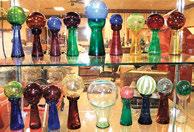








































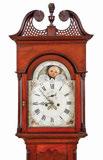



FRIDAY October 4 • 9:00am
LIVE at our Gallery and online with BIDSQUARE and LiveAuctioneers Preview: Thursday, October 3rd, 10am–5pm Hermes Kelly 32 Handbag, Vintage Estate Jewelry, Period Furniture, contemporary and vintage quilt collection, standard gauge Lionel trains, clock collection, paintings, silver, period accessories, porcelains and much, much more. Wiederseim Associates, Inc. | 1041 W. Bridge St. #20, Phoenixville, PA | Theodore E. Wiederseim, Auctioneer # AU003361L Go to www.wiederseim.com OR email info@wiederseim.com for more information!
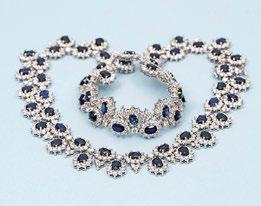




























































































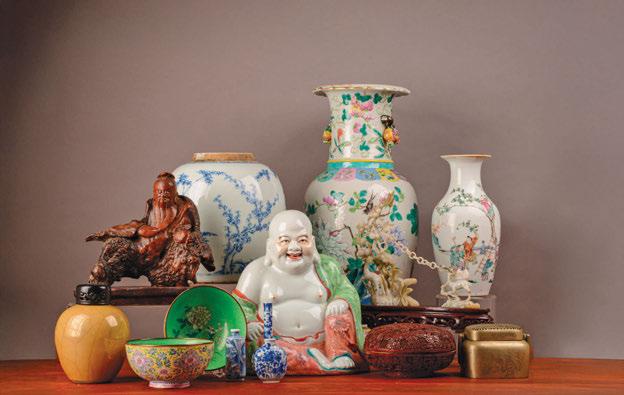



















Timed Online-Only Antique & Estate Auction
Thursday, October 10th starts to close at 5PM Period, Country,Antique, and Reproduction Furniture Paintings, Pr ints,Artwork Silver, Crystal, Porcelain, Large Collection of Willow Ware r
Pre-Columbian Figures and Bowls;
Country Collectibles, Car pets



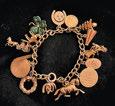








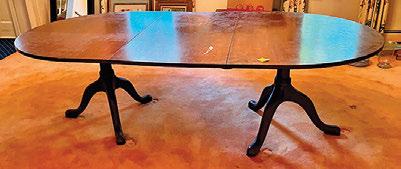




Auction 8 October 2024
Don’t miss our inaugural auction event! For additional information, or to learn more about a
in your collection, contact us at 508 470 0330 or info @landrypop.com.
LIVE AUCTION: September 30th at 5:30PM
Previews: Friday, 9/27, 12-4 pm; Sunday, 9/29, 2-4 pm; Monday, 9/30, 12-5pm or by appointment.
Paintings & Prints; American Antique, Margolis, Nutting, etc. furniture; 19th C. Historical Staffordshire, Stoneware, 20th C. Pottery and Porcelain; Antique Firearms; Asian; Silver; Jewelry; Bronze Sculptures; Garden Iron; Daguerreotypes; Coins; Stamps, etc.






View catalog online as of Sept. 20th at www.AuctionsAppraisers.com Also online at Invaluable.com & LiveAuctioneers.com
TERMS: 28% Buyer’s Premium for MasterCard, Visa, or Discover. OR 25% Buyer’s Premium for Cash or Approved Checks. Live, absentee and phone bids accepted at 25% Buyer’s Premium!








Cooke Street, Plainville, CT 06062
860-793-0288 info@AuctionsAppraisers.com





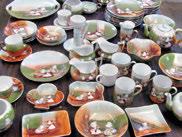












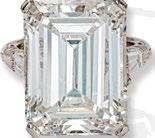




14.16 Carat Emerald Cut Diamond Ring Platinum Setting “SI1, J Color”






Featuring the Estate of Carol Minowitz of Bloomfield Hills, MI

Roger Tory Peterson (American, 1908-1996) Gouache & Watercolor ‘Three Snow Geese’
70+ Lots of Art Glass from Loetz, Steuben, and others from the Estate of Melanie and Norman Tremonti of Bloomfield, MI









Hosted October 9th, 2024, find over 300 lots of fine estate jewelry, including standout designer pieces




Carl Poul Petersen (Canadian, 1895-1977) Sterling Silver Serving Tray


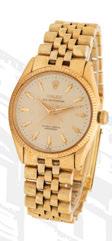


Ti any Studios (American, 1878-1938)

Leaded Glass Scenic Window from the Collection of Stan Aldridge Ca. 1905 “Landscape From A Grape Arbor”






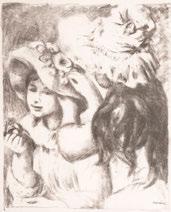
Pierre Auguste Renoir (French, 1841-1919)
Lithograph, 1898 ‘Le Chapeau Épinglé, 2ème Planche’

Ann Hall (American, 1792-1863) Oil on Wood
‘Portrait of William Wilkinson Davis’


Loetz (Austrian) Silberiris Glass Tree Trunk Vase with Applied Snake, 1899-1900




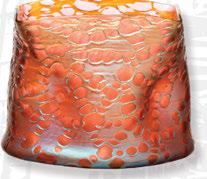
Loetz (Austrian) Pink Ground Orbulin with Applied Silberiris Glass Bowl, 1899-1903 T Snak


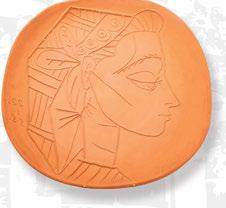
Pablo Picasso (Spanish, 1881-1973) Terracotta Plate ‘Profil De Jacqueline’ Ca. 1956

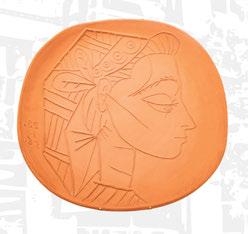

50+ lots of Hand Woven Oriental Estate Rugs Agra, Persian Serapi, Farahan Sarouk, Keshan, Tabriz, Kashmiri, Kerman, and more
























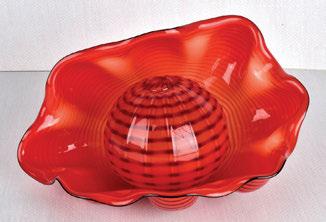
















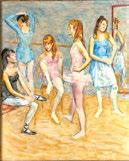



ID#: 2791
goldengavelllc@gmail.com







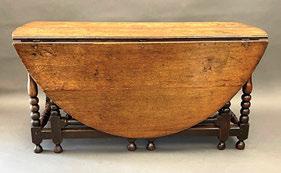






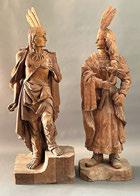

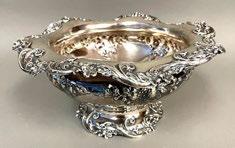









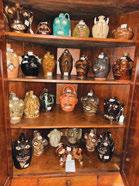

lots of Built-ins, Lg. Family Room w/Real Hand Hewn cross beamed ceiling & Antique Brick Fireplace w/side oven! Each Bedrooms has Walk-in Closets. Partially finished Basement has Vertical Knotty Pine Tongue & Groove walls & Pine Beamed ceilings complete w/a Built-in Antique, Turn-of-the-Century Ice-Cream Soda Fountain & Antique 4 Dispenser Soda Fountain. Unfinished Side w/mechanicals & Sm. Workshop area. 36’ x 15’ Oval in-Ground pool surrounded by Wrought Iron Fencing & Magnificent Mature Hedges, Concrete decking w/Brick accent pavers.
Auctioning On-Site Live & Online @ LiveAuctioneers.com-Following the Auction of the Real Estate on Sat., Oct. 12 to include Furniture: Cherry Corner cupboard, 1796 Oak carved Treasure chest, Victorian easels, 1800’s Cherry secretary desk, 1700’s Cherry Grandfather clock w/wooden works, 3 sec. Hepplewhite Mahogany banquet table, 1929 Chickering Baby Grand piano, Tiger & Bird’s-eye Maple 4 post rope bed, Sgn. Hunzinger pat. March 30, 1869, side chair; Empire Mahogany sewing stand, Cherry Tiger Maple Empire Butler’s desk, 50 drawer Hardware store cabinet, Victorian Walnut dbl. pedestal cylinder roll top desk, Antique Maple Kitchen cabinet w/3-stained glass doors, Tiger Maple 2 drw. Stand, Tiger Maple Fidder’s back settee, Cherry & Tiger Maple 2 pc. Panel corner cupboard, Cherry 2 pc. Corner cupboard, Bird’s-eye Maple step back 2 pc. Empire cupboard, 1700’s Barrel back corner cupboard, Antique McDougall 3 sec. Kitchen cabinet w/porcelain countertop, roll-up door & flour sifter; 8 pane glass door corner cupboard, 2 pc. Mahogany Philadelphia style Chippendale corner cupboard, Tiger Maple turn legs Tavern table, pr. of Windsor hooped back chairs, 2 bow back Windsor chairs, 2 pc. Step back Tiger Maple Kitchen cabinet, Period Queen Anne Tavern table, Pine 6 board dovetail blanket chest, Misson style 2 dr. wardrobe, Mahogany veneer Wm. & Mary 2 pc. Highboy, Period Cherry Queen Anne highboy, Period 2 pc. Cherry Step back cupboard; Folk Art Pottery Face Jugs by: Albert Hodge Newton, Jason Luck, Logan, M Rogers, Sid Luck, ML Ownes, Terry King, Evans Arden, Charles Brown, Ed Redmen, Marvin Bailey, Billy Hussey, Joe Reinhardt, R.E. Albright, Robert Jackson, BB Craig, Charles Lisk, Billy Joe Craven, Bobby Ferguson, Ray Hussey, Tony King, Hale Besmond, Teaque Face Jug “Fred” first snake jug, Mary Livingston; Collectibles; Clocks; Paintings; China/Glassware; Burl Bowls: Rare Antique Burl-18.25” dia. Pedestal bowl, Antique Burl bowl-16.25" dia., Burl bowl-17.5" dia., Maple Burl bowl-16" dia., Maple Burl bowl-14" dia., Burl bowl-12" dia., Burl bowls-10.5", 9.75", 8.5", 7.75", 7.5", 7", 6.75", 6"; NYS Cobalt Blue Decorated
Stoneware: Rare 4 gal. handle cooler jug w/ Fantastic Blue bird in Floral wreath design & others; Books; Auctioning @ 12 Noon: 1929 Franklin Model 135 Hard top convertible coupe w/dual side mounts, dual Chrome horns, dual Tripple Safety Senior driving lights, 80k mi., $70,000 spent on restorations 20 years ago; McShane Bell Foundry Baltimore MD dated 1891, 35"h, 31" dia. Bell w/Clapper & cast iron brackets; Bronze bell Sgn. E. Force, NY 1832; Bronze Bell-Meneely West, Troy, NY 1865; Jones Co. Troy, NY 1882 Bronze bell w/cast iron yoke.
Auctioning Sunday, Oct. 13, 10 AM OnSite Live & Online @ LiveAuctioneers.com-to include-Furniture : Art
Nouveau Louis Majorelle Marquetry inlaid Bedroom set w/Canopy Bed, dresser w/mirror, vanity w/mirror & chair; Louis Majorelle inlaid parlor table, Queen Anne style highboy w/Rattan front, Tramp Art Childs dresser w/mirror, Tiger Maple & Cherry Empire Butler’s desk, 1700’s wooden works Grandfather clock, Cherry night stand, Cherry & Tiger Maple poster bed, Cherry chest of drawers, Victorian lift top storage box, Marquetry inlaid rocker, Cherry 6 board blanket chest, Flaming Birch Queen Anne highboy, Tiger Maple low poster bed, Cherry top w/Tiger Maple legs stand, Bird’s-eye drop leaf stand w/Tiger Maple drawer, Tiger Maple poster canopy bed, 1880’s Mahogany Veneer Kidney shape vanity w/3 mirrors, Shaker style 1 drw. Stand, patio couch & chair, coffee & end table set, Hepplewhite Cherry graduated drw. Dresser, Cherry 9 pane glass top door & 2 lower panel dr. corner cabinet; Cherry pencil post poster bed; Cherry reeded leg Tiger Maple front stand, Tiger Maple dolls bed, 2 Early 6 board blanket chest; 36 drawer store cabinet; Authentic Louis Vuitton Collection: Early LV 20th Century Trunk-180848; Vintage LV steamer trunk-#740669; 2 LV Alzer 80 Suitcases w/black LV protective cover; 2 LV Alzer 75 Suitcases w/black LV protective cover; 2 LV Alzer 790 Suitcases, 2 LV Alzer 60 Suitcases w/black LV protective cover; LV Cotteville 45 case & LV Cotteville 40 case; LV Jewelry case M47120; LV Man’s briefcase M53020, LV Beauty case M21822; 2 LV Graffiti speedy bags; 100 LV Ladies Shoes-most never worn or like new; 2 LV President Briefcases; LV Boite Falcon Train case; LV Hat case Boite Chapeau-Made by French Co. under special; 4 LV Shoulder makeup bag Train case; Early LV Collar & Cuff Horseshoe shaped box, LV Black Epi Cannes M48037-9; 3 LV Golf club bags; 2 LV Blue Epi Cannes M48037-9; 2 LV Red Epi Cannes M48037-9; 2 LV Tassili Epi Cannes M48037-9; Also Auctioning: Vintage Goyard Paris steamer wardrobe Trunk 233; 2 Goyard round traveling hat boxes; E. Goyard Expandable travel Bag 9; Goyard Paris Zippered Toiletry travel bag; Antique E. Goyard Paris Trunk, Vintage E. Goyard Paris cosmetic case; 4 Halliburton Aluminum suitcases, Halliburton Train case; Young Brother Broadway Top hat in Leather traveling case; Stained Glass windows: Set of 5 Stained glass windows from the old St. Paul’s Catholic church, Black River, NY, Stained Glass of Christ & The Little Children from Marie Regina College, Syracuse, NY-36"w x 80"h in Oak shadow box frame w/Opaque Acrylic behind for support of the leaded glass window; Collectibles;Books; Bringing up Father by Geo McManus books; Villages and Towns of Broome Co.; Johnsons Natural History2 Vol.; Onondaga Centinnel-2 Vol; Cayuga Co-2 Vol; St. Lawrence, NY book; Forts & Firesides of Mohawk Co.; Coverlets ; Instruments; Paintings: Sgn. Michael Keane Painting “Morris Island Evening Calm”; Sgn. Michael Keane Painting “Salt Grass and Cays” 1988; Sgn. James G. Tyler oil on canvas; “Provisioning the Ship in Rough Seas” Sgn. James G. Tyler oil on canvas; Lighthouse & crashing waves w/sailboat; Sgn. James G. Tyler oil of 2 Sailboats onshore; Bird’s-eye view of Centennial Buildings & Grounds Philadelphia 1876; Oil Painting Sgn. Mildred Burgess “Night”; Oil Painting Sgn. WS Powell 1940 Harbor scene, Sgn. Picasso “Bouquet” lithograph; Sgn. R.G. Service painting of Tibbetts Point Lighthouse-Cape Vincent, NY; Sgn. J.G. Tyler (James Gale Tyler) Babbling Brook pastel; J.G. Tyler “Ship in the Night”; Sgn. Albert SZ Nemethy Oil Painting-The Ship Machear ice breaking ship on the Hudson River; Painting of Chrysanthemum by W.R. Willets; Watercolor on paper Sgn. Sorrento; Carriage making William B. Kirk
plus much more!







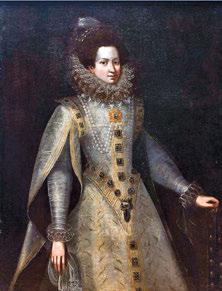








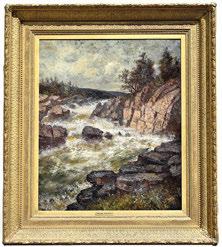

Italian bronze royal marriage urn bearing the combined arms of the House of Savoy and France 17th century. This bronze urn was to symbolize the union of the House of Savoy with France, commemorating the marriage between Victor Amadeus I (1587-1637), Duke of Savoy, and Christine of France (1606-1663), or Victor Amadeus II (1666-1732), Duke of Savoy, and Anne Marie d’Orleans (1669-1728). Height: 35.5


